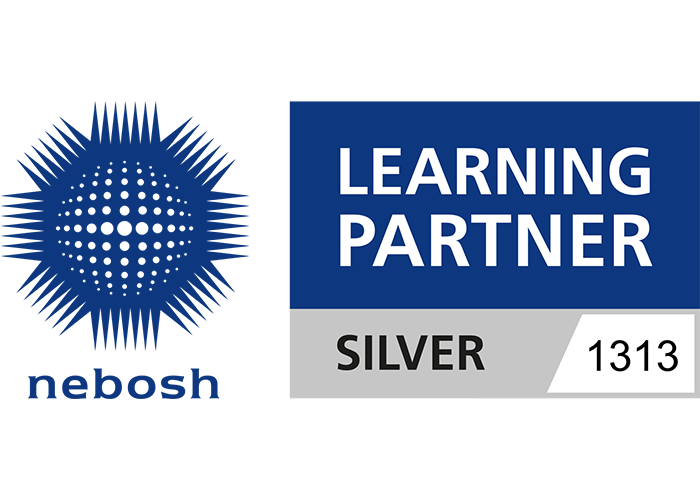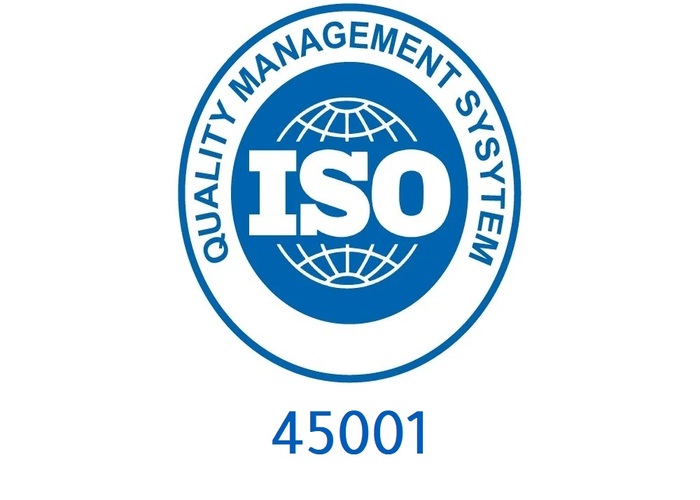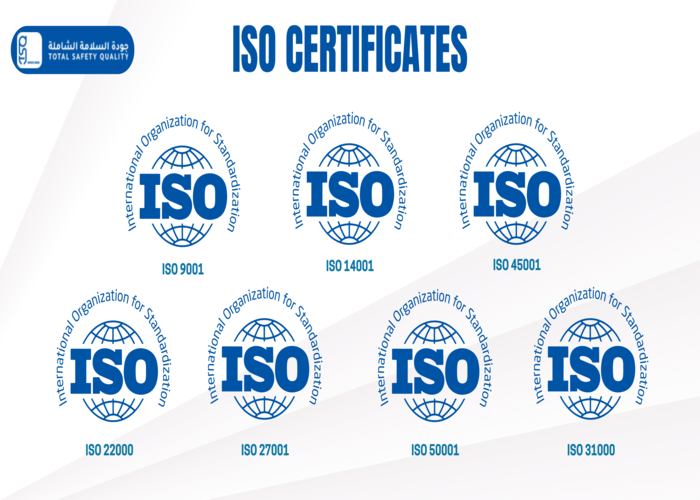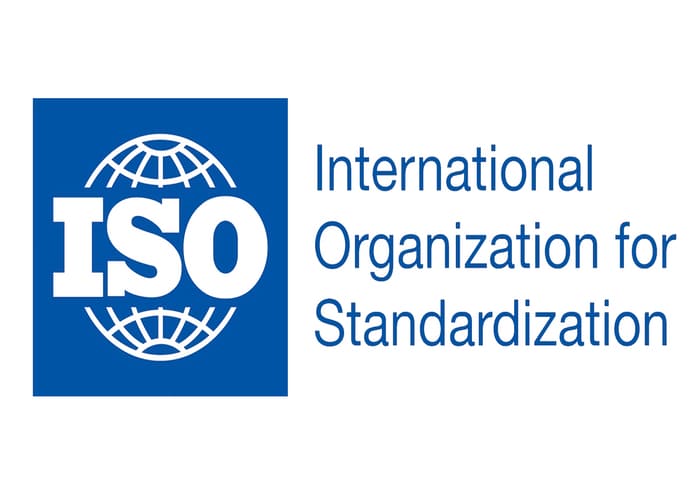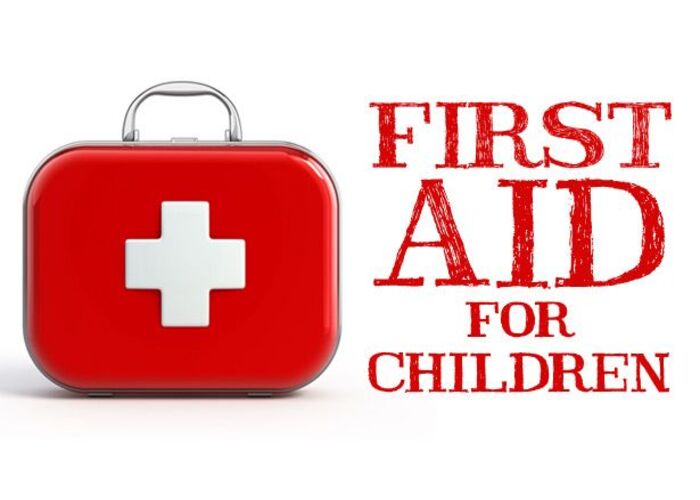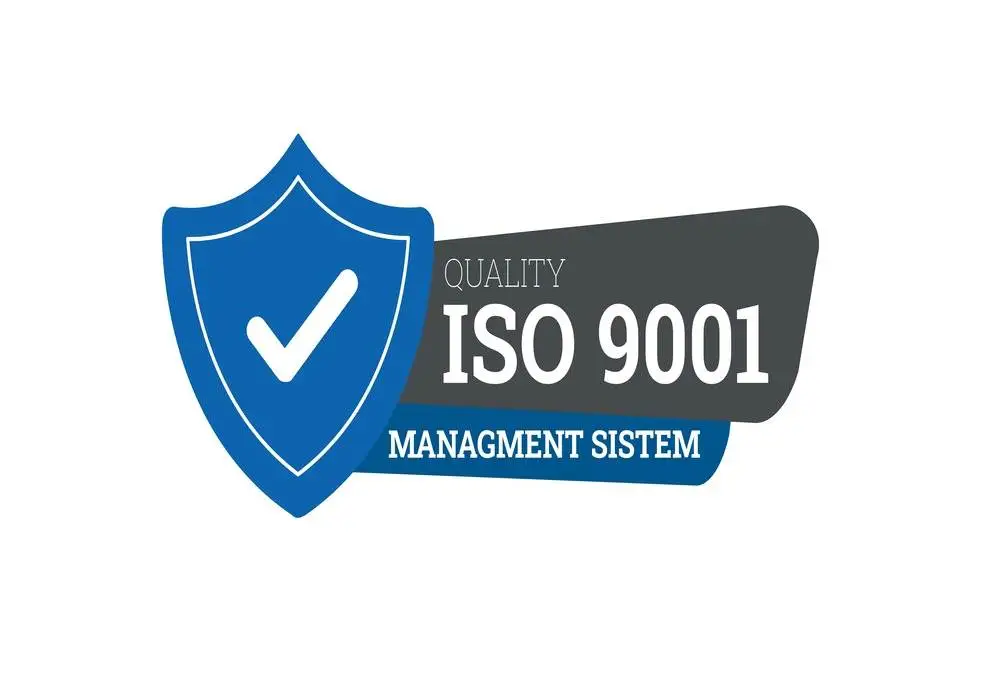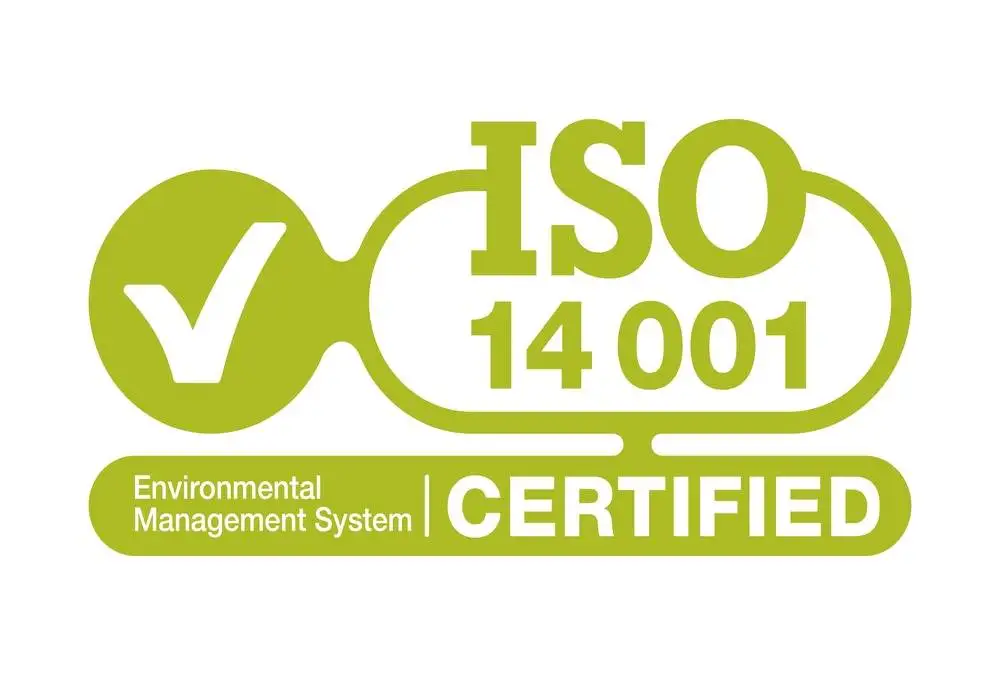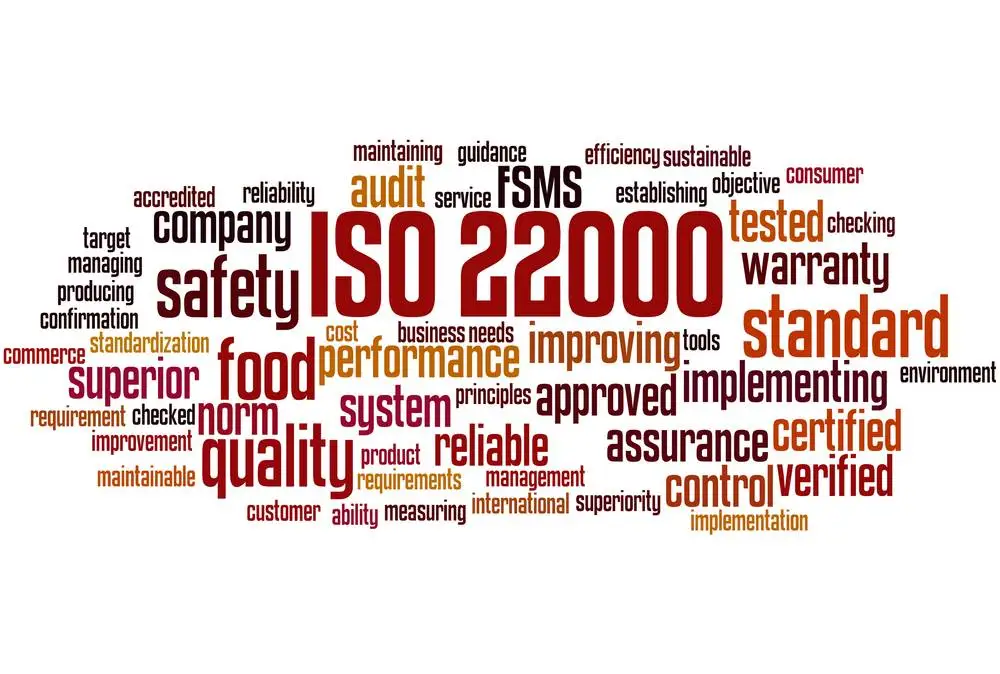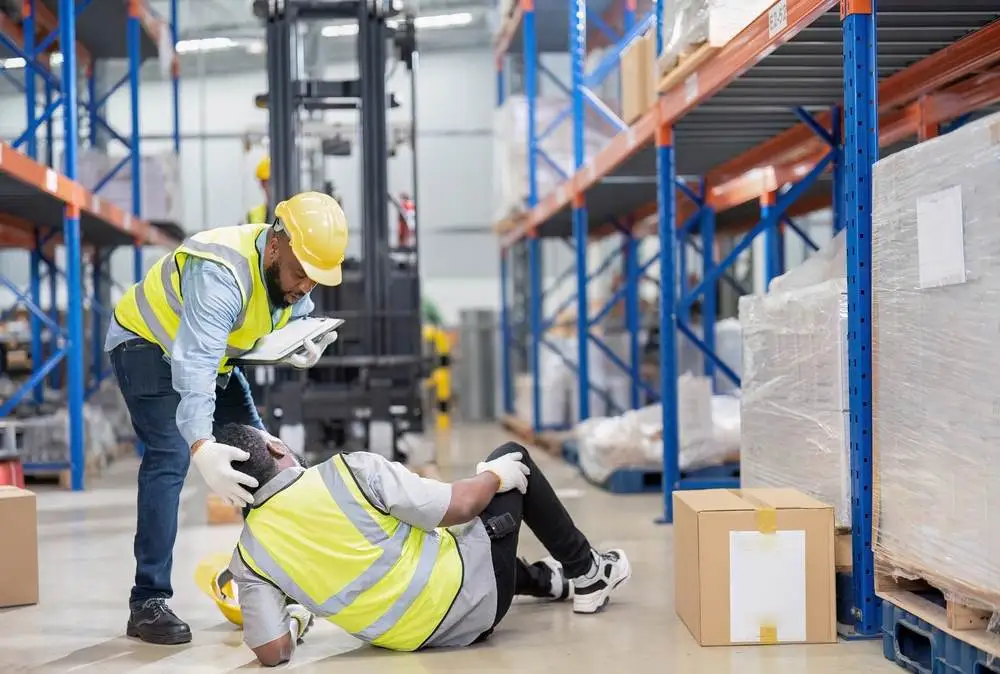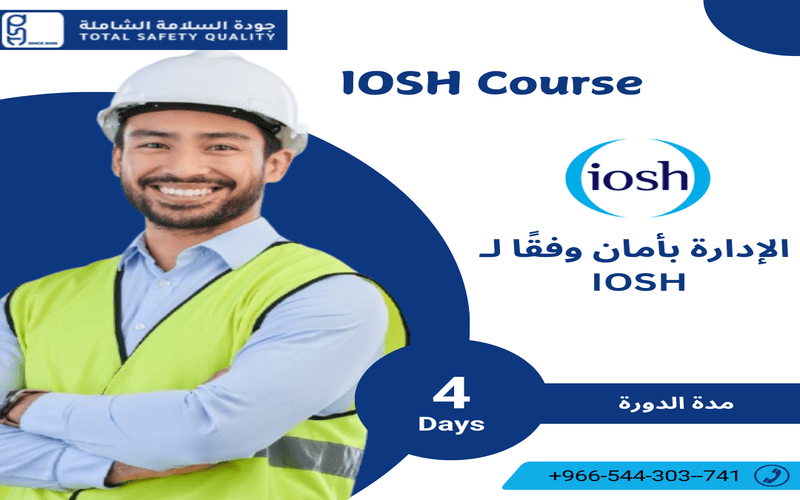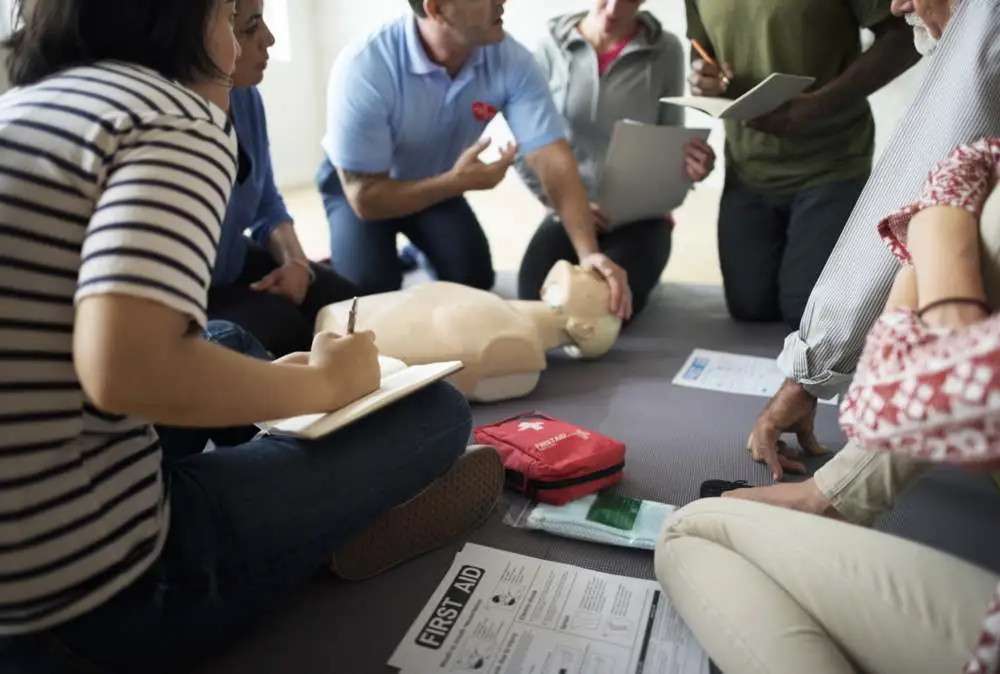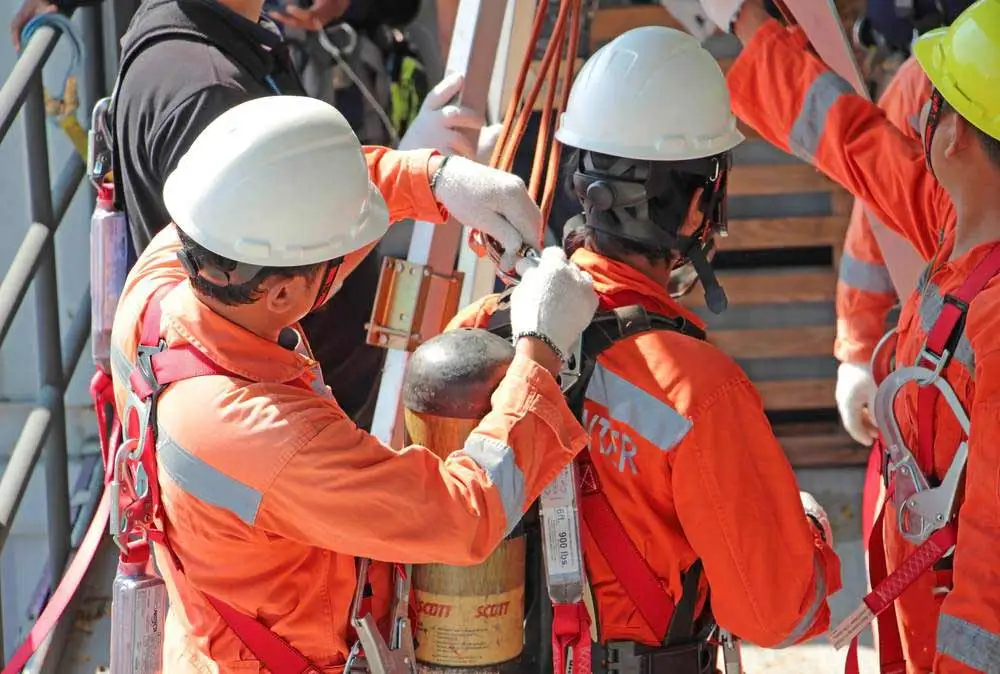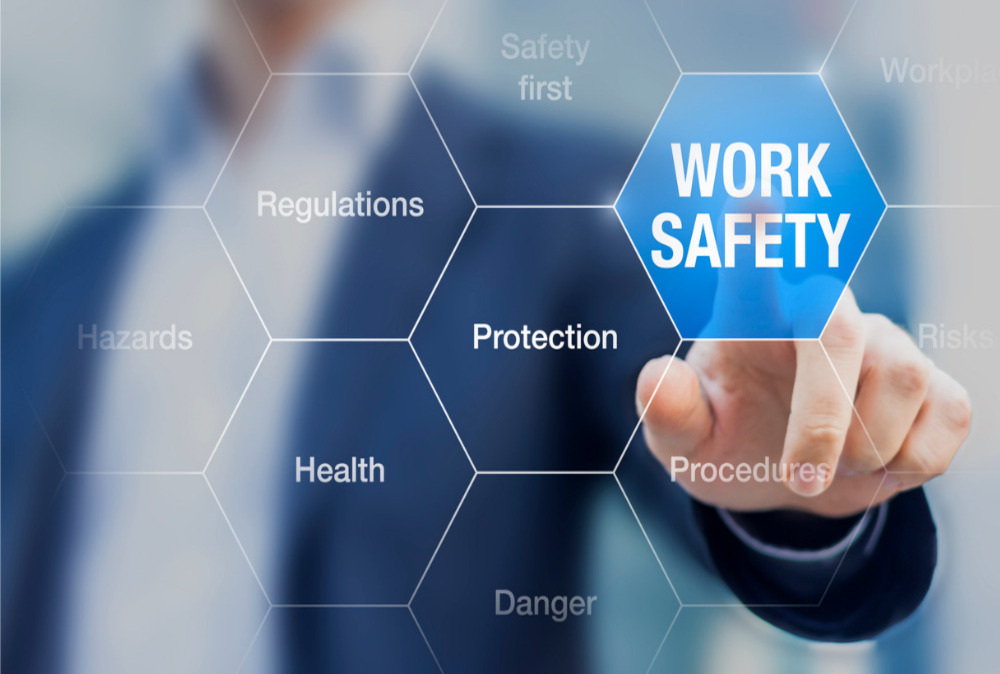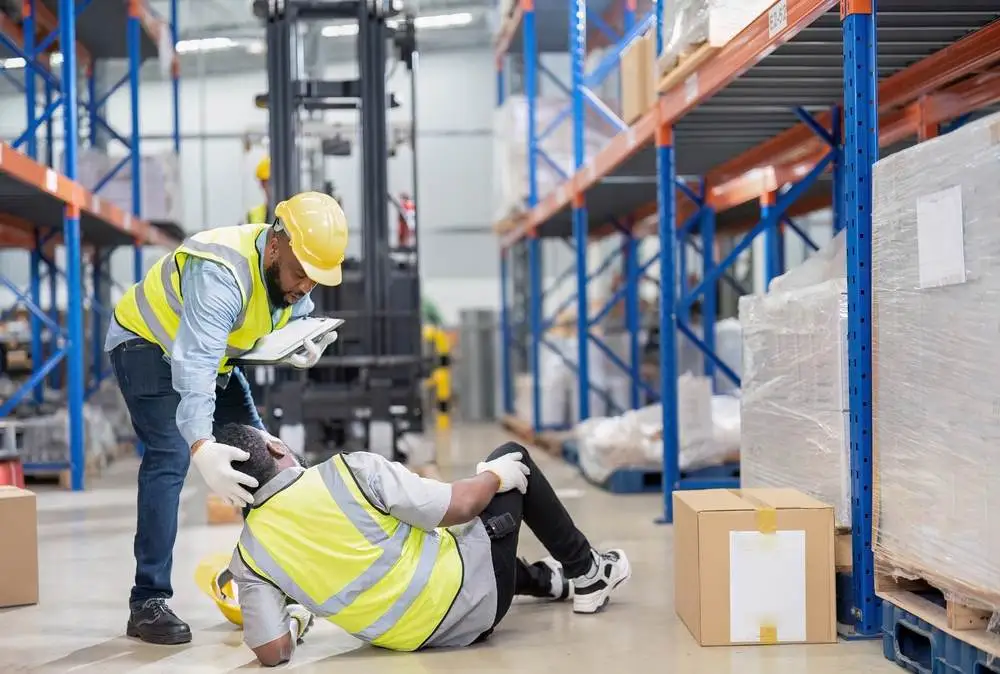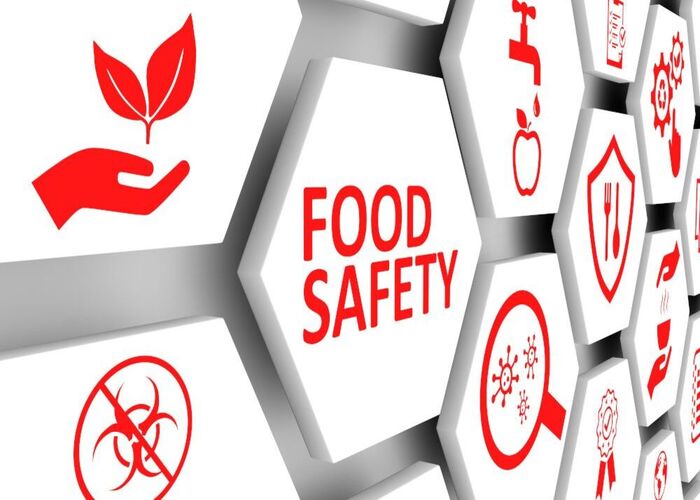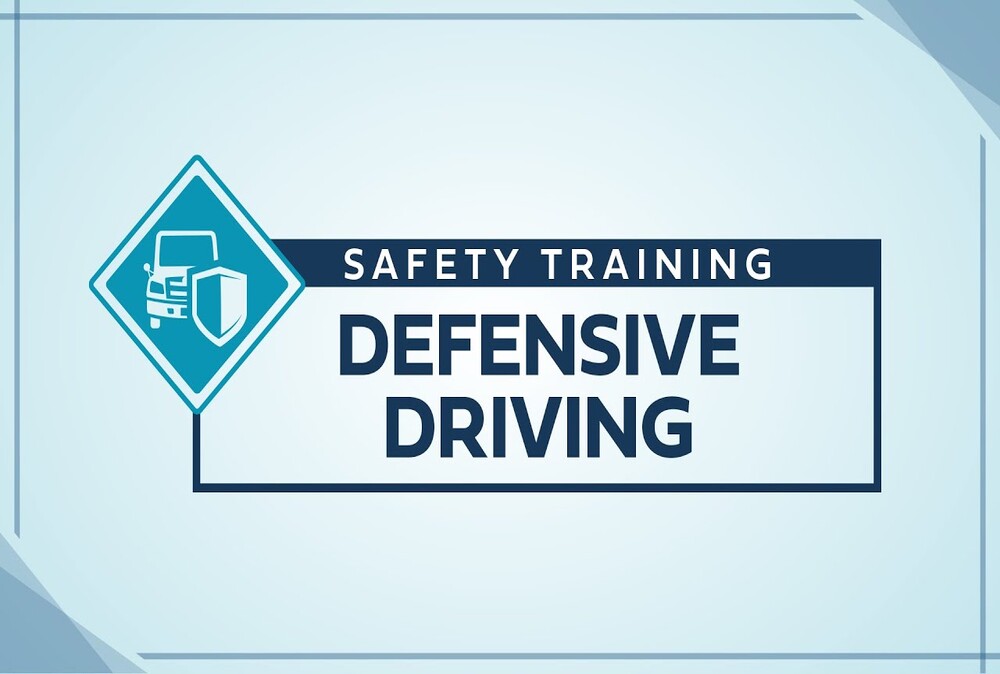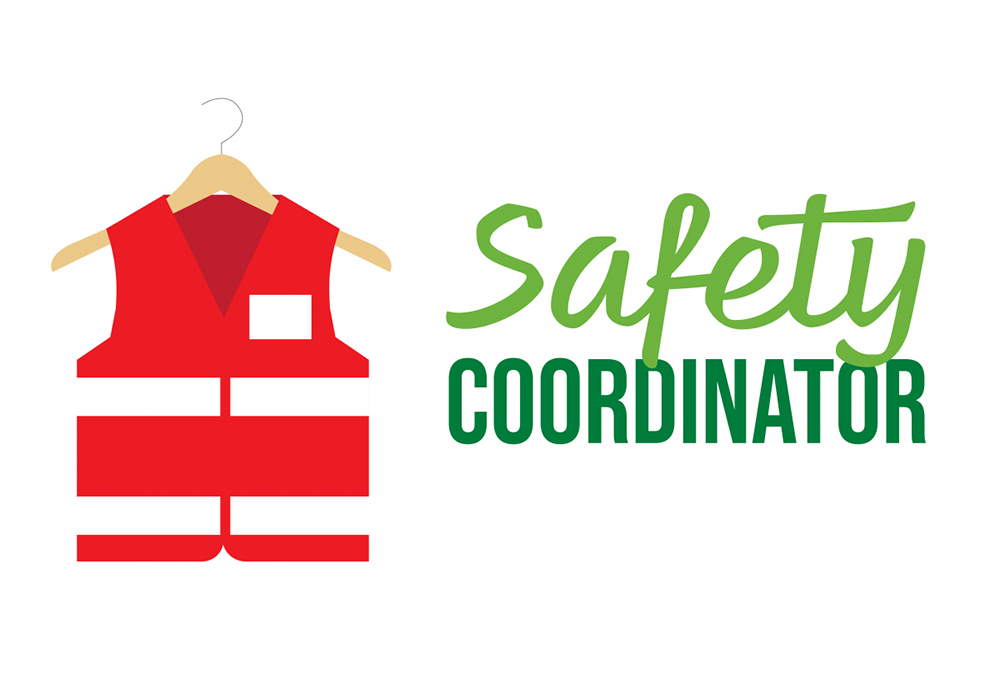In today's dynamic work environment, occupational safety and health have become paramount priorities. Consequently, numerous certifications have emerged to emphasize these crucial aspects. Among these certifications is the NEBOSH IGC certificate. This certification aims to equip individuals with the knowledge and skills necessary to foster a healthy work environment.
What is NEBOSH IGC Certification?
An accredited NEBOSH certificate is awarded to people who require a fundamental knowledge and understanding of health and safety principles and practices, Which covers multiple points, including:
Unit 1:
Topic 1: The importance of managing health and safety in the workplace.
Topic 2: The functioning and appearance of health and safety management systems.
Topic 3: Risk management - comprehending people and processes.
Topic 4: Monitoring and measuring health and safety.
Topic 5: Physical and mental health.
Unit 2:
Topic 6: Health of the musculoskeletal system.
Topic 7: Chemical and biological substances.
Topic 8: Common workplace issues.
Topic 9: Workplace equipment.
Topic 10: Fire safety.
.Topic 11: Electrical safety
Benefits of Obtaining NEBOSH IGC Certification?
Knowledge – Whether health and safety is your main responsibility or just a part of what you do, the NEBOSH IGC Course will give you vital knowledge to help you perform better in your role work.
Enjoyment – You'll enjoy taking the NEBOSH International General Certificate. You'll discover skills and techniques that are useful and practical, not just theoretical.
Achievement – The NEBOSH name is a mark of excellence in the field of health and safety. It's a qualification that people from all parts of the world are proud to have achieved.
Recognition – NEBOSH IGC Safety Course is accepted by IOSH – Institution of Occupational Safety and Health – to meet the academic requirements for Technical Membership of IOSH (Tech IOSH), and Associate Membership of the International Institute of Risk and Safety Management (IIRSM).
Career development – For some, the NEBOSH International General Certificate is a first step towards a life-long career in health and safety. For others, it forms part of an important set of qualifications that brings them success and advancement in whatever field they choose.
How to Obtain a NEBOSH IGC Certification?
One of the most common methods of obtaining a NEBOSH IGC certification in occupational safety and health is to enroll in a training center accredited by NEBOSH, like TSQCTC.
Here are the key steps to obtaining a NEBOSH IGC certificate:
1. Select an Accredited Training Provider:
When choosing a training provider, ensure they are accredited by NEBOSH and offer the program you require.
To join us and obtain the NEBOSH certificate at the best price, contact us now!
2. Enroll in the Training Course:
Contact your chosen training provider to register you for the training course.
3. Attend the Training Course:
The training course comprises lectures, discussions, and hands-on workshops. Ensure you attend all sessions of the training course.
4. Pass the End-of-Course Exam:
After the training course, you will take an exam to assess your understanding of the course material, which will be one written paper (unit 1) and a practical assignment. You must successfully pass the exam to receive the certification.
5. Receive Your Certification:
Upon successfully passing the assessments, you will be awarded your NEBOSH IGC certificate.
What are the Requirements for Obtaining an NEBOSH IGC Certification?
A NEBOSH IGC certification in occupational safety and health is a valuable investment in your professional safety and health, and it can help you advance in your career. If you are looking for a way to enhance your skills and knowledge of occupational safety and health standards, pursuing a NEBOSH IGC certification in occupational safety and health is an excellent choice.
Who Should Get NEBOSH IGC Certification?
NEBOSH IGC training courses are crucial for individuals working in fields that involve occupational safety and health hazards. The courses aim to equip participants with the knowledge and skills necessary to implement occupational safety and health standards in workplaces, contributing to reducing occupational injury and illness rates and improving the overall work environment.
In general, attending NEBOSH IGC courses and obtaining NEBOSH IGC certification is recommended for the following groups:
Supervisors and Managers:
- Those with direct responsibility for ensuring worker safety and health in workplaces.
Construction Workers:
- Facing high risks of occupational injuries and illnesses.
Manufacturing Workers:
- Exposed to hazards from chemicals, machinery, and equipment.
Healthcare Workers:
- Encountering risks of infection and contagious diseases.
Firefighters, Police Officers, and Emergency Responders:
- Facing high physical and psychological risks.
Anyone Working in an Environment with Hazardous Materials or Equipment:
- This includes individuals working in laboratories, chemical plants, oil refineries, and other hazardous environments.
Additionally, NEBOSH IGC certification in occupational safety and health can benefit anyone interested in improving their safety and health in the workplace, such as:
- Self-Employed Individuals:
- Volunteers:
- Students:
Learn More About NEBOSH Courses from the TSQC!
In today's world, safety and security are at the top of the priorities, whether at work or in personal life. Therefore, the Safety Course (security and safety courses) plays an important role in enhancing awareness of risks and ways to avoid them, which contributes to creating a safe and productive environment. The Safety Course (Occupational Safety and Health course) is considered one of the most important training courses that all workers in various fields must take. The Safety course aims to provide participants with the knowledge and skills necessary to create a safe and healthy work environment, through identifying occupational risks and ways to prevent them and being familiar with occupational safety and health systems. established, and acquired skills for dealing with emergency situations.
Definition of safety courses (security and safety courses) in brief:
These are training programs designed to provide individuals with the knowledge and skills necessary to prevent accidents and injuries in various areas of life, such as:
• Occupational safety: which is concerned with providing information to workers regarding the dangers of the work environment and how to follow safety and first aid procedures.
• Public safety: It focuses on educating individuals about the dangers of daily life, such as house fires, traffic accidents, and drowning.
• Home Safety: Provides guidance on how to protect the home from risks, such as fire and electricity, and create a safe environment for children.
• Traffic safety: teaches the rules of safe driving and walking on the roads, to avoid traffic accidents.
The importance of obtaining a safety course
• Protecting lives: Safety courses contribute significantly to reducing the risk of accidents and injuries, saving lives, and keeping individuals safe.
• Enhance productivity: A safe work environment reduces the risk of absence from work due to injuries, which enhances productivity and improves workflow.
• Reducing costs: Safety courses help reduce costs resulting from accidents and injuries, such as treatment costs and workers’ compensation.
• Creating a culture of safety: Safety courses encourage the establishment of a culture of safety in society, which contributes to spreading awareness of risks and ways to avoid them.
• Reducing work risks: The Safety Course contributes to reducing the risks of exposure to occupational accidents and injuries, which reduces both human and material losses.
• Improving the work environment: The Safety Course helps create a safer and healthier work environment, which enhances workers’ productivity and satisfaction with their work.
• Compliance with laws: Many laws and regulations require employers to provide the necessary training for workers in the field of occupational safety and health, and the Safety Course helps meet these requirements.
• Developing personal skills: The course provides participants with valuable skills such as communication, problem-solving, and decision-making skills, which will benefit them in their professional and personal lives.
Safety course topics
A safety course usually includes many topics, which include:
- The concept of occupational safety and health: The concept of occupational safety and health, its importance, and objectives are defined.
- Occupational risks: Different types of occupational risks are identified, such as physical, chemical, and biological risks.
- Methods of preventing occupational risks: Methods of preventing occupational risks are explained, such as: using personal protective equipment, applying safety procedures, and adhering to safe work rules.
- Occupational safety and health systems: The applicable occupational safety and health systems are defined, such as the Occupational Safety and Health Administration System (OHSAS) and the Hazard Assessment and Control System (HACCP).
- Emergency procedures: Participants are trained on how to deal with emergency situations, such as fires and injuries.
The duration of the safety course (security and safety course) varies from one place to another, but it usually ranges between one day and five days, and there are no specific conditions for joining the safety course.
Many entities also offer safety courses, such as vocational training centers, the most important of which is the Total Safety Quality Center, universities, and companies specialized in occupational safety and health.
A safety course is a necessary investment for anyone working in any field. Through this course, workers can acquire the knowledge and skills required to create a safe and healthy work environment, which contributes to improving both their professional and personal lives.
Types of safety courses and how to benefit from them:
Many entities and institutions organize safety courses regularly, and registration can be easily done online or through direct contact. There are also specialized training programs in specific fields, such as occupational safety in the construction sector, safety in laboratories, etc.
There are more than one safety courses that you can benefit from, the most important of which are:
1. NEBOSH course
It is a globally recognized international training course offered by the National Examination Board for Occupational Safety and Health (NEBOSH) in the United Kingdom. This course aims to provide participants with the knowledge and skills necessary to identify, assess, and control risks in the work environment, with the aim of creating a safe and healthy work environment.
Benefits of the NEBOSH course:
• Obtaining a globally recognized international certificate, as the NEBOSH certificate is a valuable certificate that can enhance your chances of obtaining better jobs in the field of occupational safety and health.
• Gain practical skills and experience because the NEBOSH course provides practical skills and experience in the field of occupational safety and health, which helps you apply safety practices in the work environment effectively.
• Improving your opportunities for professional advancement, as NEBOSH certification is a valuable addition to your CV, which helps you advance your career in the field of occupational safety and health.
• Contribute to creating a safe work environment by applying the safety practices you learned in the NEBOSH course, you can contribute to creating a safe and healthy work environment for workers.
>To register or inquire about the NEBOSH course
2. First aid course
It is a training program designed to provide individuals with the knowledge and skills necessary to provide basic medical care in emergency situations, such as:
• Bleeding: How to stop the bleeding and ensure the safety of the injured person.
• Drowning rescue: Techniques for saving people from drowning.
• Cardiopulmonary resuscitation: How to save the life of an unconscious person through artificial respiration and chest compressions.
• Injuries: How to deal with various injuries, such as fractures, wounds, and burns.
• Medical emergencies: How to deal with cases of stroke, diabetes, and epileptic seizures.
Importance of first aid course:
• Saving lives: A first aid course can contribute to saving lives through rapid intervention in emergency situations.
• Preventing injuries from getting worse: Early medical intervention can help prevent injuries from getting worse and reduce their complications.
• Enhancing self-confidence: The first aid course enhances the individual’s self-confidence in dealing with emergency situations.
• Creating a more aware society: The first aid course contributes to spreading awareness of the importance of providing basic medical care in emergency situations.
>To register or inquire about a first aid course
3. Firefighting course
It is a training program designed to provide individuals with the knowledge and skills necessary to fight and prevent fires, and typically includes:
• Basic theories of fires: such as the fire triangle, types of fires, and factors of their spread.
• Firefighting methods: include the use of different types of fire extinguishers, how to deal with water hoses and various firefighting techniques.
• First aid: includes how to deal with burns and injuries resulting from fires.
• Fire prevention: includes learning about fire risks and how to avoid them, and safety procedures in homes and public places.
Benefits of firefighting course:
• Saving lives: Firefighting courses help save lives by teaching individuals how to fight fires effectively.
• Property protection: It contributes to protecting property from fire damage.
• Enhancing self-confidence: Firefighting courses enhance individuals’ confidence in their ability to deal with fires, which reduces their feelings of fear and panic in the face of this disaster.
• Creating a safe environment: Helps create a safe environment for everyone by spreading awareness of the importance of fire prevention and ways to combat it.
>To register or inquire about the firefighting course
Many workers face many risks, injuries, and diseases that they may be exposed to in their work environment, and to ensure the application of occupational health and safety standards, the need has emerged for specialized training programs that provide certificates that qualify their holder to work in the field of occupational health and safety.
In this article, you can learn more details and information about the occupational health and safety certificate.
What is an Occupational Safety and Health Certificate?
It is a certificate awarded to individuals who successfully complete an accredited training program in the field of occupational safety and health. These programs cover many topics, including:
• Work environment hazards: Identify the different types of hazards present in the work environment, such as physical, chemical, and biological hazards.
• Risk assessment: Learn how to assess workplace hazards and determine the necessary preventive measures.
• Injury and illness prevention: Learn the principles of preventing occupational injuries and diseases, such as: using personal protective equipment, and following safe work practices.
• Occupational safety and health laws: Study the occupational safety and health laws in force in the country.
• Occupational safety and health management: Learn the principles of occupational safety and health management, such as: creating safety and health programs, conducting accident investigations, and training workers.
You may be asking yourself now about the benefits of obtaining a certificate at the occupational safety and health course.
What are the benefits of obtaining a certificate at the occupational safety and health course?
The certificate at the occupational safety and health course offers many benefits to its holder, including:
• Improving job opportunities as job demands for occupational safety and health specialists increase, especially with the increasing interest of companies in ensuring a safe working environment for their workers.
• Developing skills as training programs helps in acquiring many important skills, such as analysis skills, critical thinking, and problem-solving.
• Increased salary, as holders of the occupational safety and health certificate usually receive higher salaries than those who do not have it.
• Contributing to improving the work environment as occupational safety and health skills help improve the work environment and make it safer and healthier for workers.
In the following paragraphs, you can learn about some of the most important safety and security courses
- NEBOSH Course (Your Key to Better Safety):
The NEBOSH course is a safety and security course that is a comprehensive training program designed to provide individuals with the knowledge and skills necessary to create a safe and risk-free work environment. This course is offered by the British NEBOSH Institute, a leading institute in the field of occupational safety and health. In order to improve your skills in occupational safety and health, enhance your job opportunities, contribute to creating a safe work environment, improve productivity, and create a culture of safety.
Workers in various fields, managers, officials, and job seekers in the field of occupational safety and health can benefit from this course as it is offered by many accredited training centers around the world.
- First Aid Course (Your Shield in the Face of Emergencies):
A first aid course is a training program designed to provide individuals with the knowledge and skills necessary to provide first aid to those injured in emergency situations, such as:
(choking - wounds and bleeding - burns - fractures - drowning rescue - cardiopulmonary resuscitation)
Through it, you can save lives, provide assistance, and enhance self-confidence, in addition to creating a sense of security. Therefore, the first aid course is suitable for all members of society, regardless of their age, profession, or field of work, whether they are parents or teachers.
- Firefighting Course (Your Shield Against Fire):
A firefighting course is a training program designed to provide individuals with the knowledge and skills necessary to fight and prevent fires. It usually includes basic fire theories, firefighting and fire prevention methods. Firefighting courses help save lives by teaching individuals how to fight fires effectively, and contribute to protecting property from fire damage. Firefighting courses enhance individuals' confidence in their ability to deal with fires, which reduces their feelings of fear and panic in the face of this disaster, and helps create a safe environment for everyone by spreading awareness of the importance of fire prevention and firefighting methods.
In general, before talking about the difference between OSHA and NEBOSH in particular, the OSHA course and the NEBOSH course are globally recognized occupational safety and health training in the field of occupational safety and health, and each certificate has its advantages and accreditations.
We can detail the difference between OSHA and NEBOSH through several points, the most important of which are the following:
First: The difference between OSHA and NEBOSH in terms of definition:
• OSHA: It is a US government agency responsible for setting and implementing occupational safety and health laws and standards in the United States. The certificate focuses mainly on applying these standards and laws in American work environments.
• NEBOSH: It is a leading British institution in the field of education and training in the field of occupational safety and health. This certificate is globally recognized and covers a wide range of topics related to occupational safety and health.
This certification covers a variety of topics, including:
(Risk Management - Occupational Safety - Occupational Health - Safety and Health Legislation - Accident Investigations)
Second: The difference between OSHA and NEBOSH in terms of geographical location:
If you work or plan to work in the United States, the OSHA certification may be more suitable for you, but if you are looking for a globally recognized certification, NEBOSH is your best option.
Third: The difference between OSHA and NEBOSH in terms of your field of work:
If you work in the construction field, the OSHA specialized construction certification may be useful, but if you work in the general industry, the NEBOSH general certification may be more comprehensive.
It is worth noting that as a result of the rapid industrial development in the Kingdom of Saudi Arabia, obtaining a NEBOSH certification in Saudi Arabia has become an urgent necessity for many professionals and job seekers in various sectors, to enhance safety and health in work environments.
After we talked about the difference between OSHA and NEBOSH, let us quickly tell you about the importance of obtaining NEBOSH and OSHA certification in the Saudi market...
- The importance of NEBOSH certification in Saudi Arabia:
NEBOSH certification in Saudi Arabia is gaining increasing importance for several reasons:
• Focus on safety: The Kingdom is striving to promote a culture of safety in all sectors, and this requires the presence of qualified cadres capable of applying international safety standards.
• Increasing demand for experts: With the increase in mega projects in the Kingdom, the demand for experts in the field of occupational safety and health is increasing, making NEBOSH certification holders desirable in the labor market.
• Commitment to international standards: Saudi companies are looking to adhere to international standards for occupational safety and health, and NEBOSH certification is one way to achieve this.
• Improving the company's image: Obtaining NEBOSH certification enhances the company's image and demonstrates its commitment to worker safety and the environment.
• Improving job opportunities: NEBOSH certification opens new doors to work in various sectors, whether in private or government companies.
• Increased salaries: NEBOSH certification holders often receive higher salaries than others.
• Career advancement: The certification helps advance the career ladder and reach leadership positions in the field of occupational safety and health.
• Improve decision-making skills: The certificate gives the holder the ability to make sound decisions in the field of safety and health.
• Contribute to creating a safe work environment: The certificate holder helps in creating a safe and sound work environment for all.
- The importance of OSHA certification is as follows:
• Commitment to international standards: The Kingdom strives to implement the highest standards of occupational safety and health in the work environment, and OSHA certification reflects this commitment and ensures the provision of a safe and sound work environment for workers.
• Reducing accidents and injuries: OSHA certification helps reduce the risk of accidents and injuries in the workplace, which leads to improving the health and safety of workers and increasing their productivity.
• Protecting the company's reputation: Obtaining OSHA certification enhances the company's reputation as an entity committed to worker safety, which attracts customers and investors.
• Compliance with legislation: Many companies and institutions in Saudi Arabia require occupational safety and health certificates, and OSHA certification meets these legal requirements.
• Skills development: OSHA courses help trainees acquire the knowledge and skills necessary to identify, assess, and control hazards in the work environment.
• Better job opportunities: OSHA certificate holders have better job opportunities and higher salaries, as employers look for qualified candidates in the field of occupational safety and health.
But whether you want to get a NEBOSH or OSHA certificate, we want to give you some tips:
1. Find an accredited training center: Choose an accredited training center to ensure the quality of training.
2. Prepare well for the exams: Allocate enough time to study and review.
3. Focus on practical application: Try to apply theoretical knowledge in the work environment.
4. Stay informed: Follow developments in the field of occupational safety and health.
And don't forget to get to know the difference between OSHA and NEBOSH well so that your decision-making will be much easier.
In the field of occupational safety and health, you may find many important courses such as:
First aid is one of the vital skills that everyone should learn, as it represents the first step in dealing with emergency cases and injuries before medical assistance arrives, as through first aid courses, individuals can acquire the knowledge and skills necessary to provide first aid correctly and effectively, which contributes to saving lives and reducing complications resulting from accidents and injuries.
First aid courses include a variety of skills and information, including:
• Case assessment: How to assess the condition of the injured person and identify serious injuries.
• Cardiopulmonary resuscitation: How to perform cardiopulmonary resuscitation in the event of cardiac arrest.
• Airway obstruction: How to remove any foreign body obstructing breathing.
• Bleeding control: How to stop bleeding using bandages and pressure.
• Dealing with burns: How to deal with different burns.
• Fractures and wounds: How to deal with fractures and wounds.
• Shock: How to recognize signs of shock and provide appropriate first aid.
Fires are considered one of the most dangerous disasters that threaten human life and property, so preventing and combating them is one of the most important things that must be taken care of. Firefighting courses play a vital role in providing individuals with the knowledge and skills necessary to deal with fires correctly and effectively, which contributes to protecting lives and property and reducing material and human losses.
Firefighting courses cover a wide range of topics, including:
• Fire theory: Identify the elements of the fire triangle, how fires break out, and their types.
• Firefighting systems: Identify the different types of firefighting systems and how they work.
• Firefighting equipment: Identify the different types of firefighting equipment and how to use them.
• First aid procedures: Dealing with burns and injuries resulting from fires.
• Emergency plans: Develop emergency plans for evacuation and dealing with fires.
Who needs a firefighting course?
Firefighting courses are useful for all individuals, but they are especially necessary for the following categories:
• Employees of companies and institutions: to ensure the safety of workers and visitors.
• Residents of residential buildings: to ensure the safety of residents in the event of a fire.
• Emergency team members: to provide them with the skills necessary to deal with fires.
• Industrial facility owners: to ensure the safety of workers and property.
OSHA certification is one of the most important certifications that prove the competence of its holder in the field of occupational safety and health. This certification allows you to obtain better job opportunities, improve your salary, enhance your skills, and contribute to creating a safe work environment for everyone around you.
Before learning how to obtain a locally accredited OSHA certification, let us first learn about the OSHA course and OSHA certification in occupational health and safety, and the advantages of obtaining an OSHA-certified certificate.
What is the OSHA certification in occupational health and safety?
The OSHA-certified certificate is granted to people who have completed OSHA training courses and successfully passed the test, which covers multiple axes, including:
• Identifying and assessing hazards in the workplace, where participants learn how to identify potential hazards in their work environment, such as physical, chemical, and radiation hazards.
• Learning about safety and health programs, where participants learn how to create effective safety and health programs that comply with OSHA standards.
• Learning about OSHA rules, and participants learn how to comply with OSHA rules, including safety requirements, protective clothing, instructions, and training.
What are the advantages of obtaining an OSHA-certified certificate?
OSHA Certified is a document that proves that the holder has passed the OSHA test set by the US Occupational Safety and Health Administration.
Obtaining an OSHA-certified certificate has many benefits for both individuals and employers, including:
- Improving workplace safety and health: Reducing the risk of occupational injuries and illnesses, and creating a safer work environment for you and your colleagues.
- Compliance with OSHA regulations: Certification helps ensure that employers comply with OSHA requirements, which reduces the risk of fines and penalties.
- Enhancing job opportunities: Certification is a strong competitive advantage in the job market, as it indicates the holder’s commitment to occupational safety and health standards, and OSHA certification in occupational health and safety makes you a more attractive candidate for employers looking for employees who are committed to safety.
- Developing professional skills: Training courses provide participants with valuable skills that are applicable in various professional fields.
- Increased salary: OSHA certification in occupational health and safety can lead to an increase in your salary.
- Compliance with the law: In some cases, OSHA certification in occupational health and safety may be required by law.
How to get a locally accredited OSHA certificate according to OSHA standards
One of the most common ways to obtain an OSHA certificate in occupational health and safety according to OSHA standards is to resort to a training center such as TSQCTC, which is considered one of the largest training centers in the field of occupational safety and health with more than 18 years of experience.
There are many different ways to obtain a locally accredited OSHA certificate, including:
• Attending a training program or course: Many organizations offer locally accredited training programs according to OSHA standards.
• Attending an online training course: You can register for an online course, as there are many entities that provide training courses.
However, one of the most important steps you must follow to obtain a good locally accredited OSHA certificate from a training center is the following:
First, determine the type of certificate that suits you:
• OSHA 30 Certificate: It is a general certificate that suits all workers in various fields.
• OSHA 30 Certificate for Construction: It is intended for workers in the field of construction and building.
• OSHA 500 Certificate for Supervisors: It is intended for supervisors and managers who supervise the safety and health of workers.
• OSHA Certificates for Specialists: OSHA offers specialized certificates in specific areas such as fire safety, electrical safety, and handling hazardous materials.
Second, choose an accredited training institution:
You must choose an experienced training institution that works to provide you with the required program.
To join us and obtain a locally accredited OSHA certificate according to OSHA standards and at the best price, contact us now!
Third, register for the training course:
Contact the chosen training institution to register for the training course, which usually lasts from one to five days.
Fourth, attend the training course:
One of the advantages of obtaining a training course is that it includes discussions, lectures, and practical workshops, which ensures you effective practical training.
Fifth, obtain the certificate:
After attending the course, you will receive a locally accredited OSHA certificate from the training institution.
What are the requirements for obtaining an OSHA certificate?
OSHA certification requirements vary depending on the type of course, but in general, participants must complete all course materials and pass the final exam.
OSHA certification is an effective investment in your occupational health and safety, which helps you advance your career professionally. If you are looking for a way to improve your skills and knowledge of occupational health and safety standards, we advise you to obtain the necessary training and pass the test successfully to obtain OSHA certification.
Who should obtain an OSHA certification?
OSHA certification is a passport to a safe and healthy work environment, as it provides its holder with the knowledge and skills necessary to effectively implement Occupational Safety and Health (OSHA) standards, which contributes to reducing the rates of occupational injuries and diseases and improving the work environment in general.
But, who benefits most from this certification?
1. Supervisors and managers:
-They are directly responsible for ensuring the safety and health of workers in the workplace.
-OSHA certification helps them better understand their responsibilities and make the necessary decisions to create a safe work environment.
2. Construction workers:
-They face high risks of occupational injuries and diseases.
-OSHA certification provides them with the knowledge and skills necessary to avoid these risks and protect themselves and their colleagues.
3. Manufacturing workers:
-They are exposed to risks from chemicals, devices, and equipment.
-OSHA certification helps them understand these risks and how to deal with them safely.
4. Healthcare workers:
-They face risks from infections and communicable diseases.
- OSHA certification provides them with the knowledge and skills to deal with these hazards and protect themselves and patients.
5. Firefighters, police, and emergency workers:
-They face high physical and psychological risks.
-OSHA certification helps them understand these risks and how to deal with them effectively.
6. Anyone who works in an environment that requires handling hazardous materials or dangerous equipment:
OSHA certification helps them understand the risks of these materials and equipment and how to handle them safely.
In addition, OSHA certification may benefit anyone interested in improving their safety and health in the workplace, such as self-employed workers, volunteers, and students.
There are many other safety and security certificates and courses, and these courses differ in terms of content, duration, and registration requirements, but they all aim to raise awareness of the importance of occupational safety and health in the workplace. Let us briefly know the most important of these courses:
NEBOSH Course:
The NEBOSH course qualifies participants to pass the NEBOSH exams, as the NEBOSH certificate is one of the most important certificates in the field of occupational safety and health worldwide. You can also obtain a locally accredited certificate after passing the training body's test or obtain an internationally accredited certificate from the NEBOSH Institute (NEBOSH) United Kingdom after passing its test, which is a prestigious institution recognized internationally for its extensive experience in this field.
Firefighting and Fighting Course:
The firefighting course helps you learn about firefighting systems, study the types of firefighting systems and how they work, and learn about the maintenance procedures for firefighting systems.
Security and Safety Manager Course:
It is a training course that provides participants with the knowledge and skills necessary to manage and implement occupational safety and health programs in various facilities. The most important topics it covers are:
• Principles of occupational safety and health.
• Laws and regulations related to safety
Learn More About locally accredited OSHA Courses from the Total Safety Quality Center!
Certified First Aid Certificate
A certified first aid certificate is one of the most important certificates for security and safety courses. It is like a passport to save lives in emergencies. It is not just a piece of paper with a name on it, but rather a confirmation that its holder possesses the skills and knowledge necessary to provide first aid correctly and quickly, which may make a decisive difference between life and death.
Why is a certified first aid certificate important?
1. Saving lives: A certified first aid course gives a person the confidence and knowledge needed to deal with various emergencies, such as fainting, bleeding, burns, fractures, and cardiac arrest. Every second counts in such situations and first aid can help save someone’s life until medical help arrives.
2. Psychological reassurance: A holder of a first aid course with a certificate feels psychologically reassured because he knows how to act in the event of an accident or emergency. This feeling of reassurance is positively reflected in himself and those around him.
3. Community responsibility: First aid is not just a personal skill, but a community responsibility. Every individual can be the first rescuer in an emergency, thus contributing to keeping society safe.
4. Career opportunities: A first aid course with a certificate is an added advantage in many jobs, especially those that require direct interaction with the public or working in environments that may witness accidents, such as schools, hospitals, hotels, and companies.
5. Volunteering: First aid course holders with a certificate can volunteer in ambulance teams or at major events, giving them the opportunity to serve their community and develop their skills.
What is the importance of an accredited certification?
An accredited first aid certificate means that it is issued by an accredited and reliable body, and ensures that its holder has received the necessary training according to international standards. Accreditation also ensures that the information and skills acquired by the trainee are the latest and most effective.
How to get a certified first aid certificate?
A certified first aid certificate can be obtained by enrolling in training courses offered by accredited specialized centers such as the Total Safety Quality Training Center. These courses usually include a theoretical part that explains the basic principles of first aid, and a practical part that allows trainees to apply what they have learned to imaginary models (mannequins).
You may want to know what a first aid course with a certificate includes? And how will this course help you in your field of work?
A first aid course with a certificate covers a wide range of topics, including:
• Case assessment: because you learn how to determine the condition of the injured person and determine the priorities of first aid.
• Airway management: by knowing how to open the airway and help the injured person breathe.
• Bleeding control: by learning how to stop external and internal bleeding.
• Cardiopulmonary resuscitation: where you have the ability to perform cardiopulmonary resuscitation in cases of cardiac arrest.
• First aid for burns: dealing with various burns.
• First aid for fractures: dealing with fractures and bone injuries.
• First aid in cases of choking: how to help someone who is choking.
• First aid in cases of shock: dealing with cases of shock.
You can also learn more about:
- Occupational Safety and Health Course (OSHA Locally Accredited)
- NEBOSH Course (NEBOSH Certificate in Saudi Arabia)
How to choose a first aid course with a certified first aid certificate?
When looking for a first aid course with a certified certificate, you should look for an accredited training center with a good reputation, in addition to ensuring that the course covers all the basic aspects of first aid and that it includes a practical part that allows you to apply what you have learned.
Ultimately, a first aid course with a certified first aid certificate is an investment in yourself and your community, as it enables you to save lives, enhances your self-confidence, and opens new horizons for you. So, do not hesitate to book a first aid course with the Total Safety Quality Center, which has more than 18 years of experience in the field of security and safety for consulting and training.. Contact us now ..
You can learn more about our many security and safety courses as well
OSHA (Occupational Safety and Health Administration) courses are among the most famous and important training courses related to safety and security in the workplace. These courses aim to enhance awareness of occupational safety and ensure the provision of a safe and risk-free work environment. OSHA was established in 1970 and is responsible for implementing safety laws in workplaces in the United States, but its effects have extended globally due to the high standards it sets.
What are OSHA courses?
OSHA courses are safety and security course designed to teach individuals and workers in various industries occupational safety standards, and provide them with the knowledge and skills necessary to identify and avoid potential hazards in the workplace. OSHA courses focus on occupational health and safety, and are part of the U.S. government's efforts to protect workers.
Types of OSHA courses
Offers several levels of courses to suit the needs of individuals and different industries, including:
1. OSHA 10-hour course:
- Targeted at workers in industries such as construction, manufacturing, and healthcare.
- Covers safety basics such as common hazards, use of personal protective equipment, and handling chemicals.
- It is an excellent choice for new workers or those who want to enhance their basic knowledge about safety.
2. OSHA 30-Hour Course:
- Intended for supervisors and managers who are responsible for implementing safety procedures in the workplace.
- Covers more detailed topics, including advanced hazard control, injury prevention, and emergency management planning.
- Provides in-depth knowledge that enables supervisors to understand how to maintain a safe work environment on a broader level.
3. OSHA Specialized Courses:
- OSHA also offers specialized courses geared toward specific industries such as construction, general industry, and warehouses.
- These courses cover specific topics including electrical hazards, automated inspection, and working in confined spaces.
To also view the topics of the IOSH course
The importance of OSHA courses
OSHA courses are not just a formality, but they are essential to ensure the safety of workers in the workplace. By participating in these courses, companies can reduce the risk of accidents and enhance productivity:
1. Reducing accidents: By applying the safety standards taught in OSHA courses, accidents and injuries that may cause workers to lose productive days are reduced.
2. Avoiding penalties and fines: Compliance with OSHA laws prevents companies from paying fines for non-compliance with standards.
3. Improving the company's reputation: Companies that care about the safety of their employees and apply OSHA standards have a better reputation in the industry and gain the trust of customers and partners.
4. Protecting lives and property: Knowledge and awareness of potential hazards in the work environment enhances the protection of workers and equipment from damage.
OSHA Course Content
OSHA courses cover a wide range of topics related to safety and security, such as:
• Hazard Recognition: How to identify hazards that can cause accidents or injuries.
• Handling Hazardous Materials: Such as chemicals and heavy tools and how to handle them safely.
• Prevention Principles: Strategies to prevent accidents and injuries by applying safety techniques.
• Emergency Procedures: How to act in emergency situations such as fires, collapses, or natural disasters.
• Personal Protective Equipment: Identify the equipment needed to protect workers and how to use it properly.
Benefits of Obtaining OSHA Certification
Obtaining OSHA certification is a great advantage for both employees and employers, including:
1. Increased employment opportunities: Many employers prefer to hire people with an OSHA course certificate because of their knowledge of safety standards.
2. Enhanced professional skills: Certification gives employees confidence in their knowledge of ways to keep themselves and their colleagues safe.
3. Reduced accident costs: Workers trained in OSHA standards are less likely to have accidents, which means fewer costs associated with injuries and property damage.
Ultimately, OSHA courses provide a solid foundation for ensuring a safe and healthy work environment. Investing in these courses not only saves lives but also enhances productivity and reduces the costs associated with accidents. Whether you are a new worker or a manager responsible for a team, knowing occupational safety standards is indispensable in today's world.
>To book an OSHA course that complies with US specifications with a locally accredited certificate, contact us now
>To inquire about the Safety Inspector course
>To inquire about how to obtain a NEBOSH certificate in Saudi Arabia
The Occupational Safety and Health Cadres course is one of the most important courses that young people should enroll in, especially when they enter the labor market. This course is not limited to protecting individuals in the work environment only, but extends beyond that to include various aspects of their personal lives as well.
Why is the Occupational Safety and Health Cadres course important for young people?
1. Maintaining health and safety: The work environment is exposed to various risks that threaten the health and safety of workers. This course helps young people identify these risks and how to prevent them, which reduces the likelihood of occupational injuries and diseases.
2. Increasing productivity: A safe and healthy worker is a more productive worker. A person who feels safe in his work environment is more focused and productive.
3. Improving quality of life: Occupational safety and health is not limited to the work environment, but extends to personal life. The healthy habits that a person learns at work can help him live a healthier and happier life.
4. Adherence to laws and regulations: Many countries impose laws and regulations related to occupational safety and health.
5. Career Development: Occupational safety and health certifications are a valuable addition to your resume, increasing your chances of landing better jobs.
What does the Occupational Safety and Health Cadres course include?
The Occupational Safety and Health Cadres course covers a wide range of topics, including:
• Hazard Identification: How to identify different types of hazards in the work environment (physical, chemical, biological, etc.).
• Risk Assessment: How to assess the level of risk associated with each type of hazard.
• Accident Prevention: Preventive measures that can be taken to reduce accidents and injuries.
• First Aid: How to provide first aid in emergency situations.
• Environmental Protection: The role of the Occupational Safety and Health Cadres course in protecting the environment.
• Regulations and Laws: Learn about laws and regulations related to occupational safety and health.
Benefits of enrolling in the Occupational Safety and Health Cadres course:
• Increased awareness: The Occupational Safety and Health Cadres course helps raise young people’s awareness of the importance of safety and health in the work environment.
• Skills Development: The Occupational Safety and Health Cadres course gives young people the skills they need to deal with various emergency situations.
• Self-Confidence: Obtaining a certified first aid certificate increases young people’s confidence in themselves and their abilities.
• Better job opportunities: A first aid course increases the chances of getting better jobs and contributes to career advancement.
The Occupational Safety and Health Cadres Course is the cornerstone of maintaining a safe and sound work environment. This comprehensive course covers a wide range of skills and knowledge that enable workers to deal with various risks that they may encounter in the workplace. This course overlaps with other specialized courses such as: Firefighting Course, First Aid Course, and Safety Inspector Course, to form an integrated system that ensures everyone’s safety.
The relationship between the Occupational Safety and Health Cadres Course and specialized courses:
Firefighting Course: Firefighting skills are an integral part of occupational safety and health. This course teaches participants how to deal with small fires and how to use fire extinguishers, which help prevent the spread of fires and protect lives and property.
First Aid Course: First aid is a vital skill in any workplace. This course teaches participants how to provide first aid to injured people in emergency situations, such as bleeding, cuts, and burns, which helps save lives and reduce the negative effects of injuries.
Safety Inspector Course: Safety inspectors play a vital role in ensuring compliance with occupational safety and health standards in the workplace. This course teaches participants how to conduct safety inspections, identify hazards, and suggest solutions to address them.
Integration between the Occupational Safety and Health Cadres Course and other specialized courses ensures maximum benefit. The participant in the Occupational Safety and Health Cadres course who receives additional training in firefighting, first aid, and safety inspection is better qualified to deal with various emergency situations in the workplace, and these benefits include:
• Increased efficiency: The participant becomes able to deal with a wide range of risks.
• Improved emergency response: Participants are able to respond quickly and effectively to emergency situations.
• Reducing losses: Helps reduce material and human losses resulting from accidents and injuries.
Advice for young people:
Do not hesitate to enroll in the Occupational Safety and Health Cadres Course, as it is an investment in your future and the future of your community. Look for accredited courses that are appropriate for your field of work, and take advantage of every opportunity to develop your skills in this field, as the Occupational Safety and Health Course is a fundamental pillar for building a safe and prosperous future. Invest in yourself by taking this course, and maintain your health and safety and the health and safety of those around you.
You can also obtain many certificates from accredited courses such as the Firefighting Course, which is a specialized training program that aims to provide individuals with the knowledge and skills necessary to deal with fires safely and effectively. These courses cover a wide range of topics, from understanding the causes and types of fires, to how to use different firefighting equipment and deal with emergencies. Or the NEBOSH course, which is a globally recognized certificate in the field of occupational health and safety. The NEBOSH course aims to provide trainees with the knowledge and skills necessary to work in the field of safety and health in various industries and environments. The NEBOSH certificate is a highly sought-after qualification in many companies and institutions around the world.
You can learn more about how to get NEBOSH certification in Saudi Arabia.
Occupational health and safety courses are considered one of the most important investments that any organization can make, as they contribute to protecting workers and improving the work environment, thus increasing productivity and achieving the strategic goals of the organization.
To get the most out of these courses, organizations must:
• Encourage workers to participate in these courses.
• Provide the necessary training regularly.
• Apply the acquired knowledge in the workplace.
• Conduct periodic evaluations of the effectiveness of occupational health and safety programs.
You can learn more about Occupational Health and Safety Courses
What is ISO 14001 certification? And how to obtain it?
ISO 14001 certification is an international standard for environmental management systems that aims to help organizations reduce negative environmental impacts and improve environmental performance.
ISO 14001 certification helps organizations comply with national and international environmental requirements. By implementing ISO 14001 certification, companies can regulate resource consumption and reduce waste and pollution. In addition, ISO 14001 certification contributes to improving work efficiency and reducing operating costs.
Achieving ISO 14001 certification demonstrates the organization's commitment to environmental responsibility and sustainable development, making it more credible in the market.
You can obtain an ISO 14001 awareness course with a locally accredited certificate from the Comprehensive Safety Quality Center for Training.
Benefits of Obtaining ISO 14001 Certification
• Improve environmental performance and reduce negative impact.
• Compliance with local and international environmental legislation.
• Increase efficiency and reduce operating costs.
• Enhance the organization’s reputation as an environmentally responsible company.
• Improve competitiveness in sustainable markets.
• Attract customers and investors interested in sustainability.
• Improve relationships with stakeholders and the community.
• Support long-term sustainability through effective resource management.
Categories that can obtain ISO 14001 certification
ISO 14001 certification can benefit many categories and sectors, as it is directed to any organization seeking to improve its environmental performance regardless of its size or type of activity. These categories include:
1. Industrial companies: such as production plants that want to reduce their environmental impact and increase the efficiency of resource use.
2. Service institutions: such as transportation companies, hospitals, and hotels that aim to improve their environmental practices.
3. Government sector: departments and ministries that aim to improve the environmental performance of government facilities and enhance environmental responsibility.
4. Educational institutions: universities and schools that want to implement sustainable environmental practices.
5. Energy and utility companies: that seek to reduce the environmental impact of their operations and improve energy efficiency.
6. Construction and building companies: that work to reduce the impact of construction operations on the environment and implement more sustainable practices.
7. Non-profit organizations: that want to enhance their environmental practices and improve their societal impact.
8. Agricultural institutions: that seek to implement sustainable agricultural practices and preserve natural resources.
Therefore, any organization that seeks to achieve environmental excellence and reduce its negative impact on the environment can apply for ISO 14001 certification.
Steps to obtain ISO 14001 certification
To obtain ISO 14001 certification from the TSQ Center, the following steps can be followed:
1. Assess the current situation: Analyze the environmental system to identify gaps.
2. Training and awareness: Organize workshops to familiarize employees with the requirements of ISO 14001.
3. Develop an environmental management system: Set environmental policies, objectives and procedures.
4. Implement the system: Apply the system and ensure compliance with procedures.
5. Internal audit: Evaluate the effectiveness of the system and identify points for improvement.
6. Continuous improvement: Enhance environmental performance based on the results of the reviews.
7. Apply for certification: Submit an application to the Quality Center.
8. External audit: Evaluate the system by an external audit team.
9. Issuance of the certificate: Obtain the certificate if approved.
10. Continuous monitoring: Commitment to periodic improvements and reviews.
Why choose Total Safety Quality Center?
1. Specialized expertise: A team of consultants specialized in the fields of quality, safety and environment.
2. Comprehensive training programs: Locally accredited courses such as ISO 14001, OSHA course, Safety and Security course or NEBOSH-certified course for skill development.
3. Customized solutions: Consulting services tailored to meet the needs of different institutions.
4. Continuous improvement: Enhancing the effectiveness of environmental and administrative systems.
5. Continuous support: Providing support after courses to help clients implement effectively.
6. Trusted accreditations: Accredited certificates enhance the credibility of institutions.
7. Enhancing competitiveness: Improving quality systems to increase competitiveness in the market.
In short, ISO 14001 certification is more than just a certification; it is a certificate of the organization's commitment to environmental responsibility and sustainable development. It is an investment in the future, as it contributes to building a positive image for the organization, strengthening its position in the market, and reducing environmental risks.
Why wait? Start your organization's journey towards environmental sustainability today and get ISO 14001 certification.
< To join the IOSH course or the Safety Inspector course, contact us!
< You can also view more information about the NEBOSH certificate in Saudi Arabia to know its importance in your field of work.
ISO 45001 Certification to Ensure a Safe and Healthy Work Environment
What is ISO 45001 Certification?
ISO 45001 Certification is an international standard that aims to provide an effective framework for managing occupational health and safety systems in organizations of all sizes and sectors. This certification aims to reduce work injuries and occupational diseases, improve working conditions, and enhance compliance with relevant laws and regulations.
To book an ISO 45001 course with a locally accredited certificate from the Total Safety Quality Center, contact us!
Now let's learn about the importance of obtaining ISO 45001 certification and its role in improving employee safety and achieving a safe and sustainable work environment..
The importance of obtaining ISO 45001 certification:
• Improving the organization's image: The certification reflects the organization's commitment to providing a safe and healthy work environment, which enhances its image and reputation among customers, employees and investors.
• Reducing occupational accidents and diseases: An occupational health and safety management system certified by ISO 45001 helps identify, assess and control risks, reducing the likelihood of accidents and injuries.
• Compliance with laws and regulations: The certification ensures that the organization adheres to national and international legislation and laws related to occupational health and safety.
• Increased productivity: A safe and healthy work environment contributes to increasing employee productivity and improving their performance.
• Reducing costs: Reducing occupational accidents and diseases can reduce costs associated with medical treatment, disabilities and workers' compensation.
Components of the Occupational Health and Safety Management System according to ISO 45001:
• Policy: Define a clear policy for worker safety and health.
• Planning: Set specific goals for worker safety and health.
• Support: Provide the necessary resources to implement the system.
• Operation: Carry out daily activities to ensure worker safety and health.
• Evaluation: Evaluate the performance of the system on a regular basis.
• Improvement: Make continuous improvements to the system.
After we talked about the importance of the ISO 45001 course and its role in promoting occupational safety and health, let's now learn about the benefits of the ISO 45001 certificate and how to obtain it to ensure a safer and more efficient work environment..
Benefits of Obtaining the ISO 45001 Certificate:
When you pass the ISO 45001 course and obtain its certificate, you can:
• Improve safety performance: The system helps identify, assess and control risks effectively.
• Increase awareness: Increases employees' awareness of the importance of occupational safety and health.
• Improve relationships with stakeholders: Enhances trust between the organization and its customers, employees and the local community.
• Competitive advantage: Certification can be a competitive advantage in the market.
How to get ISO 45001 certification?
1. Current status assessment: Assessment of the current occupational health and safety management system in the organization.
2. System development: Development of the occupational health and safety management system in accordance with the requirements of ISO 45001.
3. Training: Training employees on the new system.
4. Internal audit: Conduct an internal audit to ensure that the system complies with the requirements of ISO 45001.
5. External audit: Conduct an external audit by an accredited awarding body.
6. Issuance of the certificate: If the external audit is passed, the organization is awarded the certificate.
In the end, the ISO 45001 course (ISO 45001 certification) is a long-term investment in the safety and health of workers and improving the organization’s performance, by implementing the occupational health and safety management system according to the requirements of ISO 45001, so do not hesitate to contact us to get the course now, book now!
For more information about:
ISO certifications are among the most important international standards that guarantee quality and excellence in various fields. These certifications are also evidence of the commitment of institutions and companies to implementing international standards, which contributes to enhancing customer confidence and increasing opportunities for success in the market. In this article, we will review the concept of ISO certifications, the different types of ISO certifications, and their importance in improving institutional performance, in addition to the steps to obtain the certification.
About the concept of ISO certification
ISO certification is a certification granted to organizations and companies that adhere to the application of internationally recognized quality standards. ISO, which is an abbreviation for the International Organization for Standardization, aims to set global standards that ensure the quality of products and services, and companies obtaining ISO certificates means that their operations are consistent with international standards, which enhances their reputation and position in the market.
Types of International ISO Certificates
There are many types of ISO certificates that cover different fields, and the requirements of each certificate differ based on the type of industry and the processes it focuses on. Among the most important types of ISO certificates known globally are:
1. ISO 9001 Quality Management:
Focuses on improving the quality management system in organizations to ensure that customer needs are met and their satisfaction is increased by providing high-quality products or services.
2. ISO 14001 Environmental Management:
Aims to help organizations systematically manage their environmental responsibilities and achieve sustainability, by reducing environmental impact and reducing waste, which helps individuals and organizations understand and apply the standard effectively.
3. ISO 45001 Occupational Health and Safety Management:
Aims to achieve compliance and ensure employee safety in the workplace, and aims to improve safety levels and reduce occupational accidents and injuries.
4. ISO 22000 Food Safety Management:
Contributes to the implementation of the ISO 22000 food safety management system at the highest level to ensure the highest levels of safety and quality in food products, and is used by food companies to ensure compliance with food safety standards.
5. ISO 27001 Information Security Management:
Aims to protect sensitive information from security risks by providing a framework for information security management.
6. ISO 50001 Energy Management:
Helps organizations improve energy efficiency and reduce energy consumption, which contributes to reducing costs and environmental impacts.
7. ISO 13485 Medical Device Quality Management:
Specializes in the manufacture of medical devices, and ensures compliance with the standards necessary to produce safe and effective medical devices.
8. ISO 31000 Risk Management:
Provides a framework for identifying, assessing and managing risks that organizations may face, which helps in making informed strategic decisions.
These certifications help companies improve their performance and commitment to global quality and safety standards, enhancing their competitiveness and reliability in the markets.
<To obtain locally accredited ISO courses from the Total Safety Quality Center, here are the most important courses we offer:
What is the most common ISO certification?
ISO 9001 is one of the most common and widespread types of ISO certifications in the world. This certification is concerned with applying quality management standards to ensure the provision of high-quality products and services that meet customer expectations. Many companies and institutions in various industries seek to obtain this certification because it enhances their reputation and demonstrates their commitment to achieving the highest levels of quality.
Benefits of Obtaining ISO Certification
Let us now explain to you the benefits of obtaining ISO certification, which is one of the important factors for improving companies' performance and enhancing their position in the market. The benefits of obtaining ISO certification can be summarized in the following points:
1. Improving quality: ISO certifications contribute to enhancing the quality of products and services by following specific standards that ensure commitment to quality.
2. Increasing efficiency: ISO standards help companies improve internal processes and reduce waste, leading to higher efficiency in performance.
3. Enhancing customer confidence: Obtaining ISO certification reflects the organization's commitment to quality, which enhances customer confidence and increases their loyalty.
4. Increasing competitive opportunities: Companies that obtain ISO certifications enjoy a competitive advantage in the market, as these certifications are considered evidence of quality and excellence.
5. Developing the work environment: Some certifications, such as ISO 45001, help improve the work environment and provide safe conditions for employees, which leads to reducing accidents and increasing productivity.
The benefits of obtaining ISO certification extend to improving communication within teams and increasing overall understanding of processes. Therefore, the benefits of obtaining ISO certification emphasize its importance as a strategic investment that can make a significant difference in the success and sustainability of companies in a competitive market.
Steps to Obtain ISO Certification
To obtain ISO certification, companies must follow several steps to ensure that the required standards are applied, including:
1. Determine the appropriate type of certification: The certificate that matches the nature of the company's activity must be chosen from among the different types of ISO certifications, such as ISO 9001 for quality or ISO 14001 for the environment.
2. Assess gaps: The company's current operations are analyzed to identify gaps between its current practices and the standards required for ISO certification.
3. Apply the necessary standards: After identifying the gaps, the necessary adjustments must be made to meet the requirements of the selected certification.
4. Train employees: Employees must be trained on the new processes to ensure compliance with the standards.
5. Conduct an internal audit: An internal audit is carried out to ensure that all standards are applied correctly.
6. Apply for certification: After ensuring compliance with the standards, an application for certification is submitted through a recognized issuing body.
7. External audit: The certification body conducts an external audit to evaluate the application of the standards before granting the certificate.
Why is the Total Safety Quality Center your best choice?
The Total Safety Quality Center for Training is one of the most prominent centers specialized in providing consulting and training services to obtain various types of ISO certificates accredited locally in the Kingdom of Saudi Arabia. The center is also distinguished by several advantages that make it an ideal choice for companies seeking to achieve excellence, including:
1. Extensive experience: The center has long experience in providing ISO services and technical consulting.
2. Qualified cadres: The work team includes certified experts in the fields of quality management, health, safety and the environment.
3. Comprehensive services: The center provides integrated services that include training, consulting, and conducting internal and external audits.
4. Continuous support: The center provides continuous support to companies even after obtaining the certificate to ensure continued compliance with the standards.
Ultimately, ISO certifications are one of the most important means that help companies improve the quality of their services and products, and increase their competitive efficiency. By following the appropriate steps and choosing the most appropriate certification, organizations can achieve the desired benefits, and to ensure obtaining the necessary support, they can benefit from the services of the Total Safety Quality Center, which provides specialized expertise in this field.
ISO certification has become a global standard for quality and compliance in various fields, and it represents the commitment of organizations to implement internationally recognized best practices. This certification plays an important role in enhancing operational efficiency and achieving customer satisfaction, making it a major requirement for many companies and institutions seeking to excel in the market. Therefore, in this article, we will learn what ISO certification is and how to obtain ISO certification to ensure that your organization complies with international standards.
What is ISO certification?
ISO certification is an official document granted to companies and organizations that adhere to the international quality standards set by the International Organization for Standardization. The ISO certification reflects the organization's commitment to implementing globally recognized practices in various fields such as quality management, environmental management, and occupational health and safety, which contributes to improving performance and enhancing confidence among customers and business partners.
ISO standards cover multiple areas, including quality management (ISO 9001), environmental management (ISO 14001), and occupational health and safety (ISO 45001). Obtaining the ISO certification means that its systems are compatible with ISO standards, which enhances customer and partner confidence, improves operational efficiency, and increases competitiveness in the market.
Types of ISO Certificates
After we learned what ISO certification is, we need to learn about the most common types of ISO certificates, which include the following:
1. ISO 9001 Quality Management Certification: Focuses on improving the quality of operations, products and services in the organization, and ensuring that customer needs and requirements are met.
2. ISO 14001 Environmental Management Certification: Focuses on sustainable environmental practices and helps organizations reduce their environmental impact and improve their environmental performance.
3. ISO 45001 Occupational Health and Safety Management Certification: Aims to protect employees, promote a safe work environment, and reduce accidents and injuries in the workplace.
4. ISO 27001 Information Security Management Certification: Concerned with protecting sensitive information and ensuring the confidentiality, integrity and availability of information systems.
5. ISO 22000 Food Safety Management Certification: Aims to ensure the safety and quality of food products at all stages of the food supply chain.
6. ISO 50001 Each of these certificates covers different areas of operations in companies and helps enhance management efficiency and ensure compliance with global best practices.
>Read more about the types of ISO certificates
<To obtain locally accredited ISO courses from the Total Safety Quality Center, here are the most important courses we offer:
How to get ISO certification
After we learned what ISO certification is and its types, we can now delve into how to get ISO certification. The process of obtaining ISO certification is divided into several successive stages, and each stage includes a set of steps that must be followed precisely to ensure that ISO requirements are met. Here is the division into stages:
Stage One: Preparation and Planning
1. Determine the appropriate type of ISO certificate:
- Choose the certificate that best suits your company's activity, such as ISO 9001 for quality, ISO 14001 for the environment, or ISO 45001 for occupational health and safety.
- Many people face some problems in choosing the appropriate standard, due to the presence of more than 22,000 international standards, so we advise you to contact us to help you determine the appropriate management system for your company.
2. Gap analysis and assessment of the current situation:
- Conduct an analysis to identify the gaps between the current management system and the requirements of the targeted certificate.
- Study the existing processes and procedures to determine the extent of their compatibility with ISO standards.
3. Develop a comprehensive action plan:
- Define the goals and timetables for implementation.
- Appoint a work team responsible for implementing the procedures and achieving the requirements.
Stage Two: Development and Implementation
1. Develop an ISO-compliant management system:
- Create or modify policies and procedures to meet certification requirements.
- Define performance indicators to ensure progress is monitored.
2. Train employees:
- Implement training programs to educate employees about ISO standards and their role in adhering to them.
- Ensure that each employee understands their role in implementing the new procedures.
3. Conduct periodic internal reviews:
- Conduct internal reviews to ensure that procedures are being implemented correctly.
- Address any deficiencies or violations discovered during the reviews.
Stage Three: Assessment and Review
1. Select an ISO certification body:
- Select an accredited certification body to carry out the review process.
- Contact the selected body to arrange a final review appointment.
2. Perform the final review:
- The final assessment is carried out by the certification body, which verifies that the management system complies with ISO standards.
- Be prepared to provide any documentation or evidence supporting the company’s compliance with the standards.
3. Address review comments:
- If any weaknesses or comments are identified, make the necessary improvements.
- Additional review may be required to ensure that all comments have been addressed.
Stage Four: Follow-up and Continuous Development
1. Obtaining and Renewing Certification:
- After passing the final review, the company will obtain the ISO certificate.
- Make sure to renew the certificate periodically (usually every 3 years) to ensure continuity.
2. Monitoring Performance and Implementing Continuous Improvement:
- Conduct periodic reviews to evaluate the system's performance and achieve continuous improvement.
- Maintain the company's commitment to ISO standards to enhance quality and efficiency.
By dividing the process into these stages, the company can manage the steps to obtain ISO certification in a more organized and effective manner.
ISO Certification Costs
1. Costs related to qualifying the company, establishing the ISO system, and training employees:
• Costs of consultants who help prepare the company for the ISO system and apply the required standards.
• Cost of developing documents, policies, and procedures that are in line with ISO requirements.
• Costs of training employees to implement the new system, to ensure compliance with the standards.
2. Costs of accreditation and issuing the ISO certificate for the first year from the awarding body:
• Includes the costs of the audit conducted by the awarding body to assess the extent to which the system conforms to ISO standards.
• Cost of issuing the official certificate after passing the audit.
3. Costs of annual renewal of the ISO certificate:
• Includes the costs of the audits conducted by the awarding body to verify the company's continued compliance with ISO standards.
• Costs of continuously improving the system based on the results of the annual reviews.
Each of these costs plays a fundamental role in obtaining and maintaining the ISO certificate, and varies according to the factors mentioned, such as the size of the company and the nature of its activity.
Don't let your competitors beat you to ISO certification, contact us now to help you get a locally accredited ISO certificate and start making more profits.
First aid is one of the vital matters that should be present in all institutions, especially schools, as it helps to deal with injuries and accidents that students and teachers may be exposed to immediately until medical assistance arrives, so let's learn about the importance of first aid in schools and its most important principles, in addition to the basic tools that a first aid kit should contain.
What is first aid?
First aid is a set of simple medical procedures that are provided immediately to an injured or sick person with the aim of providing primary care in emergency situations, as they are implemented until specialized paramedics arrive to provide advanced care, and first aid is used to reduce complications and protect the life of the injured person, and may contribute to saving lives in some cases.
The most important principles of first aid
The principles of first aid include the following:
• Rapid assessment of the condition: Assessing the injury or condition to know the steps to be taken.
• Protecting the injured and the paramedic: Ensuring that the environment is safe and not exposing the paramedic and the injured person to danger.
• Contacting emergency services: Requesting medical assistance if the condition requires immediate medical intervention.
• Providing first aid: such as stopping bleeding, fixing fractures, and relieving pain.
The importance of first aid in schools
First aid in schools is a vital element in maintaining the safety of students and teachers, as it plays a major role in dealing with emergencies and minor injuries that may occur during daily school activities. The following are some of the most important points that explain the importance of first aid in schools:
1. Rapid response to emergencies:
First aid helps in providing immediate care for minor injuries or emergency accidents, which reduces their aggravation and helps maintain the stability of the injured person's condition until specialized medical assistance arrives.
2. Reducing injury complications:
Through rapid intervention, first aid can prevent complications in simple or moderate cases such as bleeding, burns or fractures, which helps reduce the recovery period.
3. Enhancing safety and prevention:
The presence of a staff trained in first aid for children in school enhances the feeling of safety within the school and reassures parents that their children are in an environment capable of responding to emergencies.
4. Developing health awareness among students:
Teaching students the basics of first aid contributes to enhancing their health awareness and teaches them how to deal with minor injuries, which increases their sense of responsibility for their safety and the safety of others.
5. Supporting a safe school environment:
By providing schools with a first aid kit and training the teaching staff, schools can provide a safe environment that encourages students to participate in activities without fear of being injured without care.
6. Reducing recovery time:
Rapid care through first aid may contribute to reducing recovery time and avoiding the long-term effects of some injuries.
7. Developing teachers' emergency handling skills:
Training teachers in first aid helps enhance their ability to act calmly and effectively in the face of emergencies, which helps to control the situation quickly and protect the lives of students.
> Read also about the Security and Safety Coordinator in Schools
Types of First Aid
First aid can be classified into several types, including:
• First aid for minor injuries: such as superficial wounds and bruises.
• First aid for critical injuries: such as fractures and severe bleeding.
• First aid for emergency health conditions: such as fainting or shortness of breath.
Cases that require first aid
After we learned about the importance of first aid in schools and its types, let us talk to you about the cases that require first aid, which include:
Severe bleeding: When the bleeding is profuse and does not stop with simple pressure.
Severe burns: Second or third-degree burns that lead to tissue damage.
Fractures: When there is a clear fracture in the bones or severe sprain in the joints.
Respiratory emergencies: such as respiratory arrest or suffocation due to airway obstruction.
Poisoning: When swallowing toxic substances or skin exposure to toxic chemicals.
Fainting: When a person loses consciousness for a short period and needs immediate care.
Bites and severe allergies: such as insect bites that cause a strong allergic reaction (such as anaphylactic shock).
Seizures: When a seizure or convulsions occurs, immediate care must be provided to prevent injuries.
Severe headache or dizziness: especially if accompanied by other symptoms such as vomiting or shortness of breath.
Sports injuries: such as joint sprains or muscle tears that require immediate intervention to reduce swelling and pain.
First aid plays an essential role in dealing with these cases until the injured person is transferred to the hospital or specialized medical care arrives.
> You can join a first aid course with an accredited certificate provided by the Total Safety Quality Center.
First aid kit
Every school should have a first aid kit that includes the basic tools for dealing with injuries, such as:
• Bandages and sterile gauze.
• Scissors and wound disinfectant.
• Medical gloves to keep the wound clean.
• Painkillers and medical ointments for burns.
The importance of learning first aid skills
After we talked about the importance of first aid in schools, we found that learning first aid enhances the ability to respond quickly during accidents, which reduces the severity of injuries and increases individuals' awareness of their responsibilities towards others. Here are some important benefits of learning first aid skills:
1) Learning first aid skills can save lives and contribute to reducing complications by providing immediate care.
2) Helps in responding quickly and effectively to emergencies, which increases the chances of recovery and reduces stress.
3) Enhances safety and increases awareness of how to deal with daily injuries and accidents.
4) Contributes to creating a safe environment at home, school or workplace.
5) Training teachers and students in first aid improves schools' response to emergency incidents and enhances safety.
6) It enhances health awareness and increases individuals' ability to deal with emergencies in a competent manner.
How to learn first aid skills
To learn first aid skills, you can follow the following steps:
• Enroll in an accredited training course: You can register for first aid courses offered by the Total Safety Quality Center for Training.
• Study educational materials: You can read books or online educational materials that explain the basics of first aid.
• Practical training: Participate in practical training where you learn how to apply skills in real emergency situations.
• Cardiopulmonary resuscitation (CPR) training: It is important to learn how to perform CPR correctly.
• Continuous review: Keep your skills updated periodically through advanced courses or training workshops.
• First aid practice: Through continuous training, you become more able to act confidently in emergency situations.
Total Safety Quality Center for Training
The Total Safety Quality Center for Training is one of the institutions that provide specialized training courses in the field of first aid, where schools can cooperate with this center to organize training workshops for their students and teachers to ensure that they know the basics and are able to deal with emergency situations effectively.
Total Safety Quality Center for Training Courses:
Upon passing any of the professional courses in quality management, you will receive a certificate accredited by the Technical and Vocational Training Corporation in the Kingdom of Saudi Arabia. Available courses include:
• OSHA Occupational Safety and Health Course
• ISO 22000 Food Safety Management Course
• ISO 9001 Quality Management Course
• ISO 14001 Environmental Management Course
• ISO 45001 Occupational Health and Safety Course
These courses provide high-level qualifications to develop professional skills and enhance efficiency in the field of quality and safety, contact us now!
ISO 9001 QMS Quality
The ISO 9001:2015 standard outlines the requirements for a quality management system. This system can be applied locally by organizations, used for certification, or incorporated into contracts. The standard emphasizes the effectiveness of the quality management system in meeting customer needs and expectations.
The Total Safety Quality Center provides business management consulting services to organizations of all types and sizes.
Specialized consultants at the Total Safety Quality Center provide consulting, training, and review services in the field of quality, health, safety, environment, food safety, and other related management consulting services designed to suit the personality of any organization.
The goal here is to establish procedures, systems, and documents for an ISO 9001 quality management system that gives an accurate picture of the company and its activities and ensures that the requirements of the aforementioned system are applied and embodied as they should be in the business and the minds and attitudes of the company’s employees.
Scope of Work:
The specialized consultants at the Total Safety Quality Center provide advice on the quality management system based on the ISO 9001-2015 standards for quality management systems.
System development: One of the Total Safety Quality Center consultants will design and develop the necessary documents required according to the gap analysis and review of the client’s existing system and its documents. This will require establishing a quality management system for all activities added within the organization. The documents will be presented to the client for review and approval.
Support: The Total Safety Quality Center's advisory department will provide support and guidance to the main team during the first administrative review to be able to hold an appropriate meeting in which all required work agenda items and administrative notifications will be discussed.
Training: One of the Total Safety Quality Center consultants provides internal auditor training and introduces the ISO 9001 standard to employees to enhance their knowledge and effectiveness of system implementation.
Certification Review: The TSQC Consulting Department will assist the client during the certification review which will be conducted by an independent external auditor appointed as a third party.
The time required to complete the project is agreed upon once the specific factors are evaluated.
Objectives of the ISO 9001 course:
The ISO 9001 course aims to achieve many important goals, including:
1.Teach participants the requirements of the ISO 9001 standard:
·Understanding the Structure of the ISO 9001 Standard:
o This aspect helps participants grasp the layout and components of the ISO 9001 standard. It covers all sections and fundamental principles, ensuring a comprehensive understanding.
·Application of Standard Requirements within the Organization:
o Participants learn how to practically apply the ISO 9001 requirements within their organization. This knowledge equips them to implement these standards across different departments and divisions effectively.
·Conducting Internal Audits:
o This skill qualifies participants to perform internal audits. By doing so, they can assess whether their organization’s quality management system aligns with ISO 9001 and identify areas for improvement.
2.Providing participants with the skills to apply the quality management system:
·Understanding Organizational Processes:
This step involves helping participants get a clear picture of the main processes within their organization.
Why is this important? Well, it allows them to align these processes with the requirements outlined in the ISO 9001 standard. Essentially, it’s like connecting the dots between what they do and what the standard expects.
·Document Preparation for Quality Management:
We teach participants how to put together essential documents. These might include the quality manual (kind of like the system’s guidebook) and work procedures (the nitty-gritty instructions for day-to-day tasks).
·Mastering Records Management:
Participants learn how to handle Records effectively.
Whether it’s digital files or paper, they’ll know how to organize, store, and retrieve these records.
·Taming Change Control:
Participants get schooled on how to manage alterations to the system without causing chaos.
·Dealing with Customer Complaints:
When customers express dissatisfaction, participants learn how to handle those complaints like pros.
3.Improving participants’ skills in other areas:
·Enhancing Communication Skills:
Participants develop better communication skills by engaging with various stakeholders involved in the quality management system. Effective communication ensures smooth collaboration and understanding among team members, suppliers, and customers.
·Sharpening Problem-Solving Abilities:
Through their experience with quality management system implementation, participants refine their problem-solving skills. They learn to identify issues, analyze root causes, and devise effective solutions, contributing to overall process improvement.
·Fostering Teamwork:
The quality management system encourages teamwork. Participants learn how to work cohesively, leveraging each other’s strengths, sharing responsibilities, and achieving common goals. Strong teamwork is essential for successful quality management practices.
4.Preparing participants to obtain ISO 9001 certification:
Equipping Participants for External Audits: Individuals receive the knowledge and skills required to comprehend the intricacies of the external audit process. This empowers them to navigate audit requirements effectively.
Document Preparation Assistance: The program assists participants in preparing all essential documents needed for the external audit. From policies to procedures, they’re well-prepared to showcase compliance.
Boosting Confidence: As a result of this preparation, participants gain confidence in their ability to successfully navigate the external audit.
In general, ISO 9001 contributes to building a deep understanding of the quality management system and how to apply it effectively to improve the quality of products and services in organizations.
ISO 14001: Environmental Management Systems Awareness
Introduction:
ISO 14001 training courses are crafted to assist individuals and organizations in comprehending and applying the ISO 14001 Environmental Management System (EMS) standard. These programs encompass a broad spectrum of subjects, such as understanding the standard, its implementation, and conducting internal and lead audits.
- The Total Safety Quality Center provides business management consulting services to institutions of various types and sizes.
- Specialized consultants at the Total Safety Quality Center provide consulting, training, and review services in the areas of quality, health, safety, environment, food safety, and other related management consulting services designed to suit the personality of any organization.
- The goal here is to establish procedures, systems, and documents for a quality management system that gives an accurate picture of the company and its activities and ensures its application of the requirements of the aforementioned system and its embodiment as it should be in the business work and in the minds and attitudes of the company’s employees.
Course Objectives:
The main objectives of an ISO 14001 training course are to:
• Grasp the fundamental principles of the ISO 14001 standard and comprehend how its requirements influence the daily functioning of organizations across various sectors.
• Build the assurance to conduct an EMS audit in line with globally acknowledged best practice methodologies.
• Refine auditing competencies with the globally recognized ISO 14001:2015, and enhance the capacity for internal audits.
• Acquire the knowledge to pinpoint and alleviate environmental risks, maximize resource utilization, and reduce waste and pollution.
• Boost operational effectiveness through the optimization of processes and the improvement of environmental performance.
Who Should Attend?
The ISO 14001 training course is ideal for:
• Environmental professionals and advisors.
• Quality assurance managers and inspectors.
• Health and safety coordinators.
• Individuals responsible for establishing and maintaining an EMS.
Course Content:
The ISO 14001 training course includes the following modules:
1. Introduction to ISO 14001: An overview of the standard and its advantages.
2. Environmental Management Principles: Fundamental concepts and principles of environmental management.
3. ISO 14001 Requirements: In-depth explanation of the standard’s criteria.
4. Implementing an EMS: Procedures for developing and implementing an EMS.
5. Internal Auditing: Methods and best practices for conducting internal audits.
6. Continual Improvement: Approaches for ongoing enhancement of environmental performance.
Key benefits of ISO 14001:
• Improved Environmental Performance: Through the application of an EMS, organizations have the ability to recognize and manage the environmental repercussions of their operations, products, or services.
• Compliance with Regulations: ISO 14001 assists organizations in comprehending and keeping abreast of their compliance responsibilities.
• Management of Risks: Organizations can devise suitable measures to address them by pinpointing environmental risks and opportunities.
• Savings in Costs: Efficient environmental management can lead to cost reductions through enhanced efficiency and waste minimization.
• Excellence in Operations: ISO 14001 can aid organizations in incorporating environmental management into their business procedures.
• Trust from Stakeholders and Customers: Organizations can bolster their credibility and reputation by showcasing their dedication to managing environmental impact.
Course Duration and Certificate:
The course duration is 1 day ( 5 hours ), and upon successful completion of the ISO 14001 Training Course, An accredited attendance certificate is issued by the Technical Vocational Training Corp. in the Kingdom of Saudi Arabia from the Total Safety Quality Center, through the Manar website https://mnar.sa/
Conclusion:
ISO 14001 training courses serve as a significant asset for any person or entity aiming to enhance their comprehension of environmental management systems and their execution. These programs equip learners with the necessary understanding and abilities to efficiently handle environmental effects and boost the performance of the organization.
ISO 45001 (OHSMS) Training Course
Our ISO 45001 Training Course is designed to equip professionals with the knowledge and skills needed to implement and manage an effective Occupational Health and Safety Management System (OHSMS). This course covers the requirements of the ISO 45001 standard and provides practical insights into achieving compliance and improving workplace safety.
Course Objectives:
The ISO 45001 training course aims to empower participants with the ability to:
- Understand ISO 45001: Gain a comprehensive understanding of the ISO 45001 standard and its requirements.
- Implement OHSMS: Learn how to develop, implement, and maintain an effective Occupational Health and Safety Management System.
- Risk Management: Master techniques for identifying, assessing, and controlling workplace hazards and risks.
- Continuous Improvement: Discover strategies for continuous improvement in occupational health and safety performance.
Course Content:
- Introduction to ISO 45001: Overview of the standard and its benefits.
- Clause-by-Clause Analysis: Detailed examination of each clause of ISO 45001.
- Risk Assessment and Management: Techniques for hazard identification and risk control.
- Implementation Strategies: Practical steps for implementing an OHSMS.
- Auditing and Certification: Preparing for internal and external audits.
Course Benefits:
- Expert Instruction: Learn from experienced trainers with extensive knowledge of ISO 45001.
- Practical Insights: Gain practical tools and techniques for effective OHSMS implementation.
- Networking Opportunities: Connect with other professionals in the field of occupational health and safety.
Who Should Attend?
The ISO 45001 training course is ideal for:
- Health and Safety Managers
- Quality Managers
- Compliance Officers
- Anyone involved in the implementation and management of an OHSMS
Course Duration:
1 day (5 hours)
Certification:
Upon successful completion of the ISO 45001 Training Course, An accredited certificate is issued by the Technical Vocational Training Corp. in the Kingdom of Saudi Arabia from the Total Safety Quality Center, through the Manar website https://mnar.sa/
Among our most important courses are:
Firefighting and Safe Evacuation Course
When we talk about fires, we find that they pose a danger that can lead to huge losses if they are not dealt with seriously the potential risks are understood, so understanding the basic concepts of fire science through a firefighting course will enable a person to understand the need for the correct management of materials and the selection and use of means the right way to put out fires when the worst happens.
Training through a firefighting course is a vital part of fire prevention. Training should include teaching individuals how to properly use fire extinguishers, how to safely perform evacuation procedures, and how to deal with burns and other injuries that may occur during a fire.
Fire prevention and safety is everyone's responsibility. Through the firefighting course, we can all contribute to making our environments safer from fires.
The firefighting course is designed for professionals interested in planning, responding to, and suppressing fires, where firefighting protects the lives, property, and future of your organization. The firefighting course aims to introduce participants to concepts related to fires, and this knowledge helps protect lives and property and enhances safety in institutions and communities.
Develop knowledge of fire training about the worker's role – whether that be putting out a practical fire, doing hot work safely, or working with hazardous materials.
The firefighting course aims to provide participants with practical training on fire extinguishers, in addition to interactive training on assessing risks and mitigating their effects. The firefighting course will teach you how to protect the lives, property, and future of institutions.
Objectives of the firefighting course:
The firefighting and firefighting course aims to provide participants with the knowledge and skills necessary to deal with fires efficiently and effectively, which include:
Understanding the basics of firefighting:
- Study of fire behaviors and types.
- Identify the factors affecting the spread of fires.
Mastering the use of fire-fighting equipment:
- Identify the types of fire extinguishers and how to use them correctly.
- Learn how to use water hoses and other fire extinguishers.
Applying different firefighting techniques:
- Study fire extinguishing techniques in buildings and homes.
- Learn about the steps to fight fires in closed and open spaces.
Enhancing personal safety:
- Learn how to protect yourself from the dangers of fires.
- Follow safety procedures when dealing with fires.
Mastering evacuation skills:
- Learn the steps to safely evacuate buildings.
- Assisting people with special needs to evacuate.
Providing first aid in cases of fire:
- Learn how to deal with injuries resulting from fires.
- Providing first aid to those suffering from burns or suffocation.
Fire prevention:
- Identify common fire hazards in homes and workplaces.
- Take steps to prevent fires.
Create a fire emergency plan:
- Create an emergency plan for a fire at home or workplace.
- Train family members or employees on the emergency plan.
Learn about firefighting systems:
- Study the types of firefighting systems and how they work.
- Learn about firefighting systems maintenance procedures.
Learn about the laws and regulations related to fires
- Study fire safety laws in your country.
- Identify fire safety requirements in different buildings.
Firefighting course topics
By completing the firefighting course, candidates will have gained a concrete understanding of:
• Responsibilities and tasks of safety committee members
• Understand the responsibilities and tasks of the Safety Coordinator
• Fire safety in buildings and facilities
• Identify different categories of fires and their causes
• Fire protection systems and technologies
• Explain and practice fire and smoke prevention
• Operating basic firefighting systems and equipment
• Implement basic firefighting procedures
• Inspection and reports
• Fire risk assessment
• Identify the different types of emergencies
• Implementing the emergency evacuation plan
• Duties of emergency personnel in the workplace
• Evacuation and rescue equipment
• Practical training on firefighting equipment
Firefighting course certificate
Participants in the firefighting course are given an accredited certificate proving their successful completion of the program and their acquisition of the skills and abilities necessary to fight fires. The firefighting course certificate is a valuable advantage in the labor market and allows its holders to obtain better career opportunities in the field of fire safety.
Gas Stations Safety
Introduction:
Welcome to our Gas Stations Safety Training Course. This course is designed to provide gas station employees with the crucial knowledge and skills needed to ensure a safe and compliant work environment. Our training spans a variety of topics, ensuring that every staff member is well-prepared to tackle the unique challenges and hazards of working at a gas station.
Course Overview:
The Gas Stations Safety Training Course covers a wide range of topics including:
Understanding Hazards: Learn about the potential hazards present in a gas station environment such as flammable materials, vehicle movements, and electrical equipment.
Emergency Procedures: Gain knowledge on the correct procedures to follow in case of emergencies like fire, spills, or leaks.
Equipment Handling: Understand the safe operation of equipment commonly found in gas stations such as fuel dispensers and storage tanks.
Health and Safety Regulations: Get familiar with the health and safety regulations applicable to gas stations.
Course Objectives:
By the end of the Gas Stations Safety Training Course, participants will be able to:
Identify potential hazards in a gas station environment.
Follow correct procedures during emergencies.
Operate gas station equipment safely.
Understand and comply with health and safety regulations.
Course Content:
Our Gas Stations Safety Training Course includes the following modules:
1. Getting Acquainted with Safety Measures at Gas Stations:
- Grasping the significance of safety in the work environment
- A brief on prevalent risks at fuel stations
2. Communicating about Hazards:
- Recognizing and marking dangerous substances
- Appropriate methods for storing and managing chemicals
3. Emergency Response and Fire Avoidance Strategies:
- Formulating and executing plans for emergencies
- Techniques for preventing fires and utilizing fire extinguishers
4. Personal Safety Equipment (PPE):
- Different kinds of PPE needed for fuel station workers
- Correct usage and upkeep of PPE
5. Safety Measures for Electrical Equipment:
- Secure operation of electrical devices
- Measures to avoid electrical risks
6. Maintaining Hygiene and Preventing Illness in the Workplace:
- Upholding cleanliness and hygiene standards at work
- Measures to prevent the transmission of diseases
7. Safety from Heat and Cold Stress:
- Identifying and avoiding heat and cold stress
- First aid procedures for heat and cold-induced illnesses
8. Management and Storage of Combustible Liquids:
- Safe practices for handling and storing flammable liquids
- Protocols for managing spills and leaks
9. Safety of Customers and Employees:
- Ensuring a safe environment for customers and staff
- Handling challenging situations and averting workplace aggression
Who Should Attend?
The Gas Stations Safety Training Course is ideal for anyone working in or managing a gas station. It is also beneficial for individuals involved in the design, setup, and maintenance of gas stations.
Certification:
Upon successful completion of the Gas Stations Safety Training Course, An accredited certificate is issued by the Technical Vocational Training Corp. in the Kingdom of Saudi Arabia from the Total Safety Quality Center, through the Mnar website https://mnar.sa/
Course details:
- Course duration: 2 days (10 hours)
Introduction:
Welcome to our ISO 22000 Consultancy Services! We are a team of experienced professionals dedicated to helping businesses implement and maintain the ISO 22000 Food Safety Management System. Our goal is to ensure your organization meets the highest standards of food safety, providing confidence to your customers and stakeholders.
What is ISO 22000?
ISO 22000 is an international standard that sets out the requirements for a food safety management system. It is designed to enable organizations to control food safety hazards along the food chain to ensure that food is safe at the time of consumption.
Our Services:
Gap Analysis
Our team will conduct a thorough Gap Analysis to assess your current systems and procedures against the requirements of ISO 22000. This will help identify areas that need improvement and provide a clear roadmap for achieving certification.
Implementation Support
We provide comprehensive support throughout the implementation process. Our experts will guide you in developing and implementing a Food Safety Management System that complies with ISO 22000 standards.
Training
We offer a range of training courses designed to equip your team with the knowledge and skills necessary to maintain your Food Safety Management System. These include understanding the requirements of ISO 22000, internal auditing, and managing food safety hazards.
Internal Audits
Our consultants can conduct Internal Audits to ensure your Food Safety Management System is functioning effectively and to identify areas for improvement. This is a key part of maintaining your ISO 22000 certification.
Certification Support
We will guide you through the certification process, providing support during the external audit and helping you address any non-conformities that may arise.
Benefits of ISO 22000 Certification:
Achieving ISO 22000 certification offers numerous benefits, including:
- Enhanced Food Safety: Adopting ISO 22000 enhances food safety practices, minimizing the risk of contamination and foodborne illnesses.
- Regulatory Compliance: Adhering to ISO 22000 ensures compliance with food safety regulations and standards, reducing legal risks and liabilities.
- Improved Operational Efficiency: Streamlined processes and comprehensive documentation improve operational performance and cut costs.
- Increased Customer Confidence: Achieving certification showcases your dedication to food safety, increasing customer trust and satisfaction.
- Market Access: ISO 22000 certification can unlock new markets and business opportunities, as it is often a requirement by clients and regulatory bodies.
Why Choose Us?
With our ISO 22000 Consultancy Services, you can be confident that your organization is in safe hands. Our team of experts has a wealth of experience in the food industry and a proven track record in helping businesses achieve ISO 22000 certification. We are committed to providing a service that is tailored to your specific needs and delivering results that drive continuous improvement in your food safety performance.
Among our most important courses are:
Introduction:
Welcome to our Incident Investigation Consultancy Services. We specialize in providing comprehensive, professional, and effective incident investigation services to help organizations understand the root causes of incidents and implement corrective actions to prevent recurrence.
Understanding Incident Investigation:
Incident Investigation is a systematic process carried out in order to understand the underlying causes and circumstances of an incident. It involves a detailed examination of the sequence of events leading up to the incident, the incident itself, and the aftermath.
The primary goal of an incident investigation is not to attribute blame or liability but to identify the root causes of the incident. This includes identifying any failures in systems, processes, or equipment, as well as any human factors that may have contributed to the incident.
Once the root causes have been identified, appropriate corrective and preventive actions can be developed and implemented to prevent similar incidents from occurring in the future.
Incident investigations are a critical component of an organization’s safety management system and play a key role in improving workplace safety and health. They provide valuable insights into hazards and risks within the workplace and help organizations learn from their mistakes.
Remember, a successful incident investigation requires a systematic approach, a non-blaming culture, and the commitment to improve safety. It’s not about finding fault, it’s about finding solutions.
Our Services:
1. Incident Investigation
Our team of experienced investigators conducts thorough investigations into workplace incidents. We use systematic methods to identify the root causes and contributing factors of the incident.
2. Root Cause Analysis
We employ various techniques such as the 5 Whys, Fishbone Diagrams, and Fault Tree Analysis to determine the underlying causes of incidents. This helps in developing effective corrective actions.
3. Corrective Action Planning
Based on the findings of the investigation and root cause analysis, we assist organizations in developing and implementing corrective action plans to prevent similar incidents in the future.
4. Training and Workshops
We offer training programs and workshops on incident investigation and root cause analysis to equip your team with the necessary skills to conduct effective investigations.
Why Choose Us?
- Experience: Our team of investigators has years of experience in conducting incident investigations across various industries.
- Expertise: We have in-depth knowledge of various investigation techniques and methodologies.
- Customized Approach: We tailor our services to meet the unique needs of each client.
- Confidentiality: We maintain strict confidentiality of all information related to the incident and the investigation.
Among our most important courses are:
Emergency Evacuation
Introduction:
The Total Safety Quality (TSQ) Center provides administrative consulting services to institutions of various types and sizes of activities regarding matters related to establishing health and safety systems and reviewing them to ensure their accuracy and extent of adherence to them on an ongoing basis.
We specialize in providing comprehensive, tailored solutions to ensure the safety of your staff and premises in the event of an emergency. Our team of experienced consultants is dedicated to helping you prepare for the unexpected, minimize risks, and ensure a safe and efficient evacuation process.
Our specialized consultants provide the necessary services designed for all types of activities and businesses.
Our Services:
1. Emergency Evacuation Planning
We provide customized emergency evacuation plans that are specific to your building’s layout and occupancy. Our plans are designed to be easy to understand and follow, ensuring a swift and orderly evacuation.
2. Training and Drills
We offer training sessions and drills for your staff to ensure they are well-prepared for any emergency. Our training includes understanding the evacuation plan, recognizing alarm signals, using evacuation equipment, and more.
3. Compliance Audits
Our team conducts compliance audits to ensure your organization meets all local and national fire and safety regulations. We provide detailed reports and recommendations to help you address any areas of concern.
4. Equipment Recommendations
Based on your building’s specific needs, we recommend the best evacuation equipment and safety measures. This includes emergency lighting, signage, evacuation chairs, and more.
Applicable laws require that fire safety be one of the first priorities in any workplace. Any company or institution that employs five or more employees and whose facilities are open to the public is required to conduct a fire risk assessment and to do so by taking the necessary action based on the results of the assessment and providing the necessary training to employees. Our fire safety consultants provide services to companies in their various activities, from office work to hospital work and organizing events. We enable our clients to meet their obligations and find effective and proactive means of fire safety, including establishing evacuation procedures in emergency situations.
Our consultants help our institutional clients obtain a comprehensive emergency evacuation plan for any job site. A comprehensive emergency evacuation plan must include detailed tasks for each person involved in the evacuation, and with a little preparation and training, we can often increase the number of people who know how to implement these emergency procedures and respond well in real emergency situations.
Emergency evacuation procedures should be practiced by carrying out fire drills that allow you to evaluate the effectiveness of those procedures. Our consultants can be present at your fire drills to evaluate and provide feedback. As part of the consultation process, we will provide you with a comprehensive evacuation plan that is easy to understand, learn, and remember after you leave the classroom.
It depends on the scope of work we do. Through initial discussions, we can determine the required time whenever possible, and this will be communicated to the client in the initial stages of the project.
Why Choose Us?
•Experience: With years of experience in the field, our team has the knowledge and expertise to provide top-notch emergency evacuation services.
•Custom Solutions: We understand that every organization is unique. That’s why we offer customized solutions that fit your specific needs.
• Compliance: We stay up-to-date with the latest regulations to ensure your organization is always in compliance.
•Training: We believe in the power of preparation. Our comprehensive training programs ensure your staff is ready to respond effectively in an emergency.
It is important to note that emergency evacuation plan requirements and evacuation plan guidelines may vary depending on the type, size, and location of the organization. Organizations should always review local and national regulations to ensure they are in compliance with all applicable safety requirements.
In addition to having an emergency evacuation plan and evacuation plan guidance system, it is also important to conduct regular evacuation drills with all employees or workers in the organization. This will help ensure that everyone is aware of what to do in the event of an emergency.
Remember that the safety of people is the most important consideration for any organization. By having a specific evacuation and emergency plan and guidance system in place, and conducting regular evacuation drills, organizations can help ensure the safety of all people within their buildings or sites.
Other Courses:
NEBOSH IGC
Safety Manager
First Aid
IOSH – Managing Safely
Safety Inspector
Firefighting and safe evacuation
OSHA
TSQTC offers business management consulting services to organizations of all nature and size in areas of setting up a management system, Reviews Of Quality, Health, Safety, Environmental & Food Safety Management Systems and also analysis of the training needs in any industrial operations in terms of Health and Safety, Environment, Food Safety, Quality Management within the organisation.
Many organisations have established quality and or health, safety and environmental management Systems or may not have set up such a system - however the major weakness could be the awareness of staff towards the various aspects they are supposed to be aware of to achieve the company objectives. Our specialist consultants can extend support to your organisation in setting out all the training needs the company has, and recommended training schedule with costing designed for all kinds of business / industries.
Our specialist consultants provide a detailed report setting out all the training needs the company has, and recommended training schedule with costing designed for all kinds of business / industries.
TSQTC offers business management consulting services to organizations of all nature and size including management of Health, Safety and Environmental Aspects in work Projects.
Our specialist consultants provide Quality, Health & Safety, Environment, and Food Safety consulting, training, auditing, and related management consultancy services designed for such industries.
We provide a comprehensive array of health, safety and environment services both as a stand-alone service or to complement the additional core services of project management, facilities management and building consultancy.
Our service could be tailored to suit the activities of the organistion, but can include assistance with any or all of the following:
- General advice on arrangements and procedures including legislative updates
- Preparation of company health and safety policies
- Reviewing specific aspects of company activities
- Undertaking risk assessments and producing method statements
- Arranging for provision of information relevant to health, safety and training with maintenance of records
- Monitoring and recording health and safety performance of contractors / enforce the company health and safety requirements.
- Investigating accidents / incidents
- Advising on reporting of Injuries, dangerous incidents
Fire Emergency and Evacuation In Educational Building
Introduction:
Fire emergencies can occur without warning, and the safety of students and staff in educational buildings is paramount. Our Fire Emergency and Evacuation In Educational Building is designed to equip everyone with the knowledge and skills needed to respond effectively during a fire.
Understanding Fire Emergencies:
A fire emergency refers to an event where a fire has broken out and could potentially harm individuals or damage property. It’s crucial to understand the nature of fire emergencies and how to respond effectively.
Course Outcomes:
Upon completion of the Fire Emergency and Evacuation In Educational Building training course, participants will be able to:
- Identify potential fire hazards in an educational setting.
- Understand the role and use of fire safety equipment.
- Execute an effective and safe evacuation in the event of a fire.
- Understand their role in a fire emergency situation.
How do we control the spread of fire?
- Escape routes (emergency exit) and requirements for escape routes
- Evacuation and fire reporting methods
- What is the fire triangle and how to extinguish a fire?
- Facts about fires and ways to prevent them
- Methods of putting out fires
- Types of fire extinguishers
- Evacuation and fire reporting methods
- Crisis management team in educational facilities
- Management responsibilities
Course Content:
Understanding Fire
- Fire Basics: Learn about the science of fire, including the fire triangle and the different classes of fire.
- Fire Hazards: Identify potential fire hazards in educational buildings, such as overloaded electrical outlets and unattended cooking appliances.
Fire Safety Measures
- Prevention: Learn about preventive measures, such as proper storage of flammable materials and regular inspection of fire safety equipment.
- Protection: Understand the role of fire doors, fire extinguishers, and fire alarm systems in protecting people and property.
Fire Emergency Plan
- Evacuation Procedures: Learn how to evacuate safely and efficiently, understanding the importance of knowing all exit routes and assembly points.
- Role of Fire Wardens: Understand the responsibilities of fire wardens during an evacuation, including guiding people to safety and accounting for all building occupants.
Who Should Attend?
The Fire Emergency and Evacuation In Educational Building training course is essential for all staff members in educational institutions, including teachers, administrators, and support staff. It’s also beneficial for students, particularly those in higher education institutions.
Course Duration and Certificate:
The course duration is 1 day ( 5 hours ), and upon successful completion of the Fire Emergency and Evacuation In Educational Building Training Course, An accredited certificate is issued after 48 hours by the Technical Vocational Training Corp. in the Kingdom of Saudi Arabia from the Total Safety Quality Center, through the Mnar website https://mnar.sa/
Conclusion:
Fire safety is everyone's responsibility. So, the Fire Emergency and Evacuation In Educational Building training course will provide you with the knowledge and skills needed to deal with fire-related emergencies effectively. Enroll in the Fire Emergency and Evacuation In Educational Building training course today.
Overview
·The Occupational Safety and Health Course is a specialized training program that helps participants become familiar with occupational safety and health legislation, as the OSHA course is considered necessary in the work environment.
·The OSHA (Occupational Safety and Health course) helps provide you with the knowledge and skills necessary to maintain a safe and healthy work environment. In the OSHA course, you will learn how to identify potential environmental and workplace risks and prevent injuries and accidents with the highest efficiency.
·The OSHA course provides you with the necessary training to understand and apply safety standards in a specific place.
·The Occupational Safety and Health course will cover a wide range of topics, including laws and regulations related to occupational safety, how to prevent accidents, how to improve safety awareness in the work environment and also how to respond to accidents if they occur.
·The OSHA course is directed to workers and employees in the field of occupational safety and health, and workers in industrial and petroleum sites, such as experts, consultants, heads, and department managers in all production and service institutions within the public or private sectors.
Objectives of the OSHA course
Identify what occupational safety is and the risks that workers may be exposed
Enumerates the importance of applying an occupational safety and health system to work performance
Mentions safety precautions at work sites
Learn and understand the laws and regulations related to occupational safety
Applies health and safety standards in many areas of the work environment
Promoting a safe work environment by applying occupational safety standards
Contents of the OSHA course
•Occupational safety and health legislation
•Definitions of occupational safety and health
•Personal protective equipment
•Occupational safety and health monitoring standards
•Methodology for using fall prevention and protection systems and equipment
•Work and walking surfaces
•Escape methods in case of disasters (fire - explosion - earthquake)
•Fires, how to extinguish them, and fire extinguishers
•Flammable liquids
•Hazardous chemical information delivery system
•Shut off power sources and label them
•Safety in welding and cutting work
•Electrical hazards
•Working in confined (enclosed) spaces
Working with machines (production lines and workshops) and protecting fro them
•Manual labor - manual loading and unloading
• Working with forklifts
Who attends the occupational safety and health course
OSHA's five-day course is designed for all levels of employees
• It is essential that everyone in the organization is aware of the basic aspects of fire safety and prevention
Methodology of occupational safety and health courses
• Our OSHA-accredited course is highly interactive and includes group discussions and exercises and will enable participants to build on existing skills
Use of excellent interactive materials of international standards
·Lessons with PowerPoint presentations on all topics
OSHA course certificate
An accredited certificate is issued by the Technical Vocational Training Corp. in the Kingdom of Saudi Arabia upon successfully passing the occupational safety and health course from the Total Safety Quality Center, through the Mnar website https://mnar.sa/
Course details
-Course duration:5days
- Location of the course:at Total Safety Quality Center
Training Course for Safety Inspectors applying approved regulation
Introduction:
Safety Inspectors play a crucial role in maintaining a safe and healthy environment in various industries. They are responsible for ensuring that safety regulations and standards are adhered to, and they help prevent accidents and injuries in the workplace.
Roles and Responsibilities:
Safety Inspectors are tasked with the following responsibilities:
Inspecting workplaces: Regularly inspecting workplaces for safety hazards and ensuring compliance with safety standards.
Investigating accidents: Investigating workplace accidents to identify their causes and find ways to prevent them in the future.
Training and education: Conducting safety training sessions for employees and educating them about potential hazards.
Reporting: Documenting inspection findings and producing reports that suggest improvements.
Skills and Qualifications:
A successful Safety Inspector typically has the following skills and qualifications:
Attention to detail: Ability to notice small details that could potentially lead to significant safety issues.
Knowledge of safety laws and regulations: Familiarity with local and national safety laws and regulations is crucial.
Communication skills: Ability to clearly communicate safety protocols and procedures to employees.
Problem-solving skills: Ability to identify safety hazards and determine the best ways to mitigate them.
By completing the Safety Inspector course, participants will gain an understanding of:
• The basis of fire safety
• Fire safety rules and regulations
• Roles and responsibilities of Safety Inspector in fire cases
• How does a Safety Inspector assess hazards and identify hazards?
• Implement control measures
• Common causes and behavior of fire
• Classification of fires and fire extinguishers
• Basic principles of heat transfer and fire propagation
• Types of fire extinguishers and their uses
• Fire detection, fire alarm, fire suppression, firefighting equipment, and evacuation
• Emergency classification
• Emergency and evacuation procedures
• Using fire extinguishers (practical)
Course Duration and Certificate:
The course duration is 1 day (5 hours), and upon successful completion of the safety inspector training course, an accredited certificate is issued after 48 hours by the Technical Vocational Training Corp. in the Kingdom of Saudi Arabia from Total Safety Quality Center, through the Mnar Website https://mnar.sa/
Conclusion:
Safety Inspectors are vital to the well-being of employees and the success of companies. By ensuring compliance with safety regulations, they help create safer, healthier workplaces.
Risk Assessment Course
The goal of risk assessment:
As part of their duty, employers and self-employed individuals bear the responsibility of safeguarding the well-being and safety of employees and anyone else who might be impacted by work-related tasks. A highly effective approach to fulfilling this commitment is by methodically evaluating the risks associated with the various activities they engage in.
The Risk Assessment course is designed to provide participants with knowledge on how to carry out this task with confidence and competence.
After completing the one-day risk assessment course, participants will be able to understand the following:
Helping the company and its employees fulfill legal obligations through effective risk assessment.
Recognizing the specific training needs of individuals undergoing risk assessments.
Being able to conduct risk assessments even in locations where formal programs are unavailable.
Incorporate risk assessment principles into your daily work environment.
Ensuring the safety of employees and others impacted by your company’s work involves minimizing their exposure to potential hazards and injuries.
Those responsible for managing or supervising work activities where the persons responsible for those activities are at risk:
Front-line managers are an obvious example and can even be from management environments.
The Risk Assessment course is a highly interactive course that includes group discussions and exercises that allow participants to build on existing skills, the most important of which are:
Our focus lies in putting knowledge and assessment skills to work in real-world scenarios.
Through real case studies and lively group discussions, participants get hands-on experience applying their skills and knowledge throughout the evaluation process.
We pride ourselves on using top-notch interactive materials that meet international standards.
Our comprehensive lessons come alive through dynamic PowerPoint presentations covering a wide range of topics.
Content of the risk assessment course:
1. Risks and Crises:
o Risks refer to potential events or situations that could have negative consequences. They can be anticipated and managed proactively.
o Crises, on the other hand, are sudden, disruptive events that threaten an organization’s stability, reputation, or operations. Crises often require immediate response.
o Types of Risks: These can include financial risks (e.g., market fluctuations), operational risks (e.g., supply chain disruptions), legal risks (e.g., lawsuits), and reputational risks (e.g., public perception).
o Stages of Crisis Development: Crises typically progress through stages like the “pre-crisis” phase (where risks are identified), the “acute crisis” phase (when the crisis occurs), and the “post-crisis” phase (recovery and learning).
2. Risk Management Process:
o Risk Identification: Recognizing and assessing potential risks. This involves analyzing internal and external factors that could impact an organization.
o Risk Analysis: Evaluating the likelihood and impact of identified risks. Prioritizing risks based on severity.
o Risk Assessment: Quantifying risks and understanding their potential consequences. This informs decision-making.
o Risk Treatment: Implementing strategies to mitigate or manage risks. Options include risk avoidance, risk transfer (e.g., insurance), risk reduction, or acceptance.
3. Emergency Planning and Crisis Preparedness:
o Developing Emergency Plans: Organizations create detailed plans for responding to crises. These plans outline responsibilities, roles, communication channels, & actions to take during emergencies.
o Training Crisis Response Teams: Ensuring that key personnel are well-prepared to handle crises. Regular drills and simulations are essential.
o Testing Emergency Plans: Regularly evaluating and updating emergency plans. Testing helps identify gaps and areas for improvement.
4. Effective Communication During Crises:
o Skills of Communicating: Crisis communication involves being clear, concise, and empathetic. Leaders must address concerns, provide accurate information, and maintain transparency.
o Dealing with the Media: Managing media inquiries and shaping public perception during a crisis. Timely, honest communication is crucial.
5. Lessons Learned from Crises:
o Analyze Previous Crises: After a crisis, organizations should conduct thorough post-mortems. What went well? What could be improved?
o Identify Lessons Learned: Extract insights from past experiences. Understand what worked and what didn’t.
o Develop Plans to Prevent Recurrence: Use these lessons to enhance risk management and crisis preparedness. Adjust processes, policies, and training accordingly.
Remember, effective risk management and crisis preparedness are ongoing efforts. Organizations must adapt to changing circumstances and learn from each experience.
Risk Assessment Course Certificate
Upon successful completion of the Risk Assessment Course, an accredited certificate is issued by the Technical Vocational Training Corp. in the Kingdom of Saudi Arabia from the Total Safety Quality Center, through the Mnar website https://mnar.sa/
Course Details
Duration of the Risk Assessment Course: One Day (5 hours)
Safety Manager Simulative Course According to Approved Regulations
Introduction:
The Safety Manager course is designed to equip you with the knowledge and skills necessary to excel as a Safety Manager. Our comprehensive curriculum covers a wide range of topics, ensuring you’re well-prepared to handle any safety-related issue in your workplace.
Course Overview:
Module 1: Understanding the Role of a Safety Manager
In this module, we delve into the responsibilities and expectations of a Safety Manager. We’ll discuss the importance of safety in the workplace and how a Safety Manager contributes to creating a safe working environment.
Module 2: Risk Assessment
Learn how to identify potential hazards, assess risks, and implement control measures to mitigate these risks. This module will provide you with the tools to conduct effective risk assessments in your workplace.
Module 3: Safety Regulations and Standards
This module covers the various safety regulations and standards that Safety Managers must adhere to. We’ll discuss local, national, and international safety laws and guidelines, and how to ensure compliance within your organization.
Module 4: Incident Management
Learn how to effectively manage incidents in the workplace. This includes incident reporting, investigation, and follow-up actions to prevent recurrence.
Module 5: Safety Training and Communication
Discover how to develop and deliver effective safety training programs, and how to communicate safety information clearly and effectively to all levels of the organization.
Course Outline:
1. Understanding Safety Regulations
Overview of local and international safety regulations
Importance of compliance with safety standards
2. Risk Assessment
Identifying potential hazards
Implementing preventive measures
3. Incident Prevention
Safety protocols and procedures
Training staff on safety practices
4. Emergency Response
Developing emergency response plans
Training for emergencies
5. Safety Management
Creating a safety culture
Continuous improvement in safety management
What are the duties of a safety manager?
• Responsible for the safety and health of all employees in the workplace.
• Identifies potential risks and develops plans to reduce or eliminate them.
• Implementes occupational safety and health programs.
• Investigates incidents and reports them.
• Informs employees about occupational safety and health matters.
• Cooperates with relevant government agencies.
Who Should Attend?
This course is ideal for aspiring Safety Managers, current Safety Managers looking to upskill, and anyone involved in managing safety in the workplace.
Course Duration and Certification:
The Safety Manager course duration is 5 days (25 hours), upon successful completion of the course, an accredited certificate is issued after 48 hours by the Technical Vocational Training Corp. in the Kingdom of Saudi Arabia from the Total Safety Quality Center, through the Mnar website https://mnar.sa
NEBOSH IGC Course
The NEBOSH International General Certificate has been designed to provide an appropriate breadth of underpinning knowledge for non-specialists in occupational health and safety to enable them to discharge more effectively their organizational duties or functions concerning workplace health and safety.
The NEBOSH Course has been designed for Safety Managers, Managers, Senior Engineers, Safety Engineers, Safety Officers/advisors, Safety Professionals, and others who require a fundamental knowledge and understanding of health and safety principles and practices.
Candidates who take NEBOSH safety training are likely to be employees of organizations already working to international standards but needing to adapt these to accord with local needs and practices.
People throughout the world take the NEBOSH International General Certificate because it gives them the skills and know-how to fulfill their health and safety responsibilities in any country and in any kind of organization.
What you gain from this Qualification
Knowledge – Whether health and safety is your main responsibility or just a part of what you do, the NEBOSH IGC Course will give you vital knowledge to help you perform better in your role work
Enjoyment – You'll enjoy taking the NEBOSH International General Certificate. You'll discover skills and techniques that are useful and practical, not just theoretical.
Achievement – The NEBOSH name is a mark of excellence in the field of health and safety. It's a qualification that people from all parts of the world are proud to have achieved.
Recognition – NEBOSH IGC Safety Course is accepted by IOSH – Institution of Occupational Safety and Health – to meet the academic requirements for Technical Membership of IOSH (Tech IOSH), and Associate Membership of the International Institute of Risk and Safety Management (IIRSM).
Career development – For some, the NEBOSH International General Certificate is a first step towards a life-long career in health and safety. For others, it forms part of an important set of qualifications that brings them success and advancement in whatever field they choose.
Course Outline
Unit 1:
Topic 1: The importance of managing health and safety in the workplace.
Topic 2: The functioning and appearance of health and safety management systems.
Topic 3: Risk management - comprehending people and processes.
Topic 4: Monitoring and measuring health and safety.
Topic 5: Physical and mental health.
Unit 2:
Topic 6: Health of the musculoskeletal system.
Topic 7: Chemical and biological substances.
Topic 8: Common workplace issues.
Topic 9: Workplace equipment.
Topic 10: Fire safety.
Topic 11: Electrical safety.
Assessment
The method of assessment will be one written paper (unit 1) and a practical assignment.
Course Certificate
On successful completion of the course, delegates are awarded the International General Certificate from NEBOSH - UK.
Terms & Conditions
· Course Fee includes candidate registration fees / examination fees with NEBOSH - UK
· Please contact us for group / corporate discounts
· Upon receiving the filled and signed candidate registration form by TSQC from the candidate as confirmation for examination registration, the candidate is liable to pay the registration amount within 7 days
· Examination date cannot be changed once the candidate’s exam registration is carried out with NEBOSH UK.
Emergency Preparedness & Response
Introduction:
Welcome to our Emergency Preparedness & Response Training Course. This course is designed to equip you with the knowledge and skills necessary to effectively respond to different types of emergencies. Our goal is to ensure that you are prepared to protect yourself and others during critical situations.
Course Overview:
This comprehensive training course covers a wide range of topics including:
1.Understanding Emergencies: Learn about the different types of emergencies and their potential impacts.
2.Preparedness Planning: Understand how to develop and implement an effective emergency preparedness plan.
3.Emergency Response: Learn the principles of emergency response, including how to assess situations and make decisions under pressure.
4.First Aid and CPR: Gain practical skills in First Aid and CPR.
5.Fire Safety: Understand fire safety principles and learn how to use fire extinguishers.
6.Evacuation Procedures: Learn about safe evacuation procedures and how to conduct drills.
Course Objectives:
•Grasp Emergency Preparedness: Acquire essential knowledge on emergency preparedness, covering risk assessment, planning, and resource management.
•Formulate Response Strategies: Learn how to create effective response strategies tailored to various emergencies.
•Boost Communication Skills: Enhance your crisis communication abilities to ensure clear and efficient information sharing.
•Engage in Hands-On Training: Take part in practical exercises and simulations to practice your skills in real-world scenarios.
•Work with Experts: Collaborate with seasoned professionals from diverse fields such as public health, emergency management, and first response.
Course Content:
1.Overview of Emergency Preparedness
Significance of being prepared
Various types of emergencies
Conducting risk assessments and management
2.Planning for Emergency Response
Crafting emergency response plans
Managing and allocating resources
Collaborating with local and national agencies
3.Crisis Communication
Strategies for effective communication
Utilizing technology and social media
Systems for public information and warnings
Who Should Attend?
This course is suitable for anyone interested in improving their emergency preparedness and response skills. It’s particularly beneficial for:
•Health and Safety Officers
•Emergency Response Team members
•Facility Managers
•Community Leaders
•Teachers and School Administrators
Course Duration:
The course duration is 25 hours, spread over 5 days. This includes theoretical sessions, practical demonstrations, and drills.
Course Certification:
Upon successful completion of this Training Course, An accredited certificate is issued by the Technical Vocational Training Corp. in the Kingdom of Saudi Arabia from the Total Safety Quality Center, through the Mnar website https://mnar.sa/
IOSH course
The IOSH course (Managing Safely) is a course intended for people who are required to carry out safe and effective management in accordance with their organization’s policy and best health and safety practices.
Who attends the IOSH course?
The IOSH safety course is designed for all levels of management and for those responsible for implementing safe and healthy work in an organization, including managers, supervisors, and foremen.
Topics of the IOSH course
Module 1: Introduction to Safe Management:
· Why is it necessary to conduct safe management?
· What are your responsibilities as a manager?
Module 2: Risk Assessment:
· What are the risks?
· What is risk assessment?
· How are risks assessed?
Module 3: Risk Control:
· How do you contribute to reducing risks?
· How do you decide which risk officer to use?
· What are the basic parts of a health and safety management system?
Module 4: Understanding your responsibilities:
· What does the law require you to do?
· How does the law help?
Module 5: Identifying Risks:
· What are the general risks?
· What can you do about common risks?
Module 6: Accident Investigation:
· Why investigate accidents?
· How do accidents happen?
· How do you conduct an accident investigation?
Module 7: Performance Measurement:
· Why is performance measurement important?
· How do you measure health and safety performance?
· What is a review?
Module 8: Protecting our environment:
· What is the impact of the industry on the environment?
· How do we control pollution and waste?
· What are the basic elements of an environmental management system?
IOSH course methodology
· Trainings, group discussions, as well as presentations on all topics related to international standards.
· Course material from the Occupational Health and Safety Foundation - England.
IOSH course certificate
Upon passing the test, course participants are awarded a safe management certificate from the Occupational Health and Safety Foundation - England.
Course details
IOSH safety training duration: 4 days – 24 Hours
Course evaluati
The course iosh health and safety course is evaluated by taking a written exam at the end of the course, in addition to assigning a task/project to the participants, which they must complete and return to us within 14 days to put the necessary mark on it.
Highfield Level 3 International Award in Emergency 1st aid courses and Use of AED with CPR for all Ages
It is a course that aims to provide trainees with the knowledge, understanding, and skills necessary to support first aid in emergencies. The course covers pieces of knowledge such as first responder roles and responsibilities and how to assess an incident. It also covers first aid skills in cardiopulmonary resuscitation (CPR, for adults, children, and infants), providing first aid to a choking victim, dealing with external bleeding and hypovolemic shock, and the safe use of an automated defibrillator.
Objectives of First aid training in Saudi arabia
The first aid course aims to provide participants with the knowledge and skills necessary to deal with various medical emergencies, including:
• Cardiopulmonary resuscitation (CPR) using an external defibrillator (AED) for all ages.
• Bleeding and burns.
• Injuries, such as fractures and bruises.
• Medical emergencies, such as stroke, diabetes, and respiratory failure.
Promoting a culture of safety and health in the community.
Empowering participants to contribute to saving lives.
Topics of First Aid Courses
The topics of first aid courses with our center include the following:
1. Know and understand the role and responsibilities of a first responder.
1.1. Define the role and responsibilities of the first aider.
1.2. Learn how to reduce the risk of injury to the paramedic and others.
1.3. Determine the content of the required first aid kit.
1.4. Determine the need for providing first aid.
2. Learn to be able to evaluate the accident:
2.1. Scene (incident) survey procedure.
2.2. Conduct an initial survey of the casualty, establish resuscitation, and re-evaluate.
2.3. Call for appropriate assistance when necessary.
3. Learn how to manage a casualty who is unresponsive and breathing normally:
3.1. Assess the level of consciousness of the injured person.
3.2. Open the injured person's airway and examine breathing.
3.3. Place the unresponsive casualty in the recovery position.
3.4. Management of the casualty in the event of a seizure.
4. Learn how to deal with an injured person who is not breathing normally and is not responding:
4.1. Determine when to perform CPR to:
• Adults do not respond
• Unresponsive child
• Unresponsive infant
4.2. Explain CPR using:
• Mannequin (doll) is an adult
• Mannequin (doll) is a child
• Mannequin (doll) infant
5. Learning how to provide first aid to a suffocating victim:
5.1. Determine when choking occurs:
• light
• Intense
5.2. Explain how to administer first aid to an adult, child, and infant suffering from choking.
6. Learn how to provide first aid to someone suffering from external bleeding.
6.1. Determine the severity of external bleeding.
6.2. Explain how to control external bleeding.
7. Learn how to provide first aid to a minor injured person.
7.1. Determine how to provide first aid to the injured person:
• Small injuries
• Wounds (scratching)
• Bruising
7.2. Learn how to administer first aid to the injured person with burns and minor burns.
8. Learn how to provide first aid to an injured person in a state of shock:
8.1. Identify the injured person who is suffering from shock.
8.2. Explain how to provide first aid to an injured person suffering from shock.
9. Learn how to use an automated external defibrillator (AED) safely.
9.1. Describe the differences between the use of an automated external defibrillator (AED) on an adult and a child.
9.2. Identify safety considerations when using an automated external defibrillator (AED).
9.3. Illustration of the correct placement of the AED electrode on the pen.
9.4. Follow the AED audio instructions carefully
9.5. Explain how to combine the use of an automated external defibrillator with minimal interruptions in manicure CPR.
9.6. Illustration of safe delivery of AED shock
9.7. Knowledge of learning to determine procedures if the injured person shows signs of life and begins breathing normally.
9.8. Knowledge of learning to identify the information required when delivering an injury
Who attends first aid courses:
Anyone can attend this course as it is beneficial for everyone in their daily life. However, it may be more useful for employees who work in areas where help is hours away. Team leaders, supervisors, support staff, and paramedics or first responders should regularly attend a refresher course on first aid and CPR.
First Aid course certificate:
The certificate is issued by the British Highfield after 15 working days in the event of passing the practical and written test (multiple optional).
Issued electronically - Highfield license card valid for 3 years.
Duration of the first aid course:
The course is designed for one day (6-8 hours).
Highfield Level 1 International Award in Fire Safety
Introduction:
The Highfield Level 1 International Award in Fire Safety is a crucial qualification that equips learners with basic fire safety knowledge. This fire safety course is perfect for all employees, particularly new hires, in any workplace where understanding fire safety is necessary.
Course Overview:
The Highfield Level 1 International Award in Fire Safety is a qualification recognized worldwide that equips learners with a basic comprehension of fire safety in a work environment. This fire safety course encompasses a variety of subjects, including:
• Comprehending Fire Hazards: Acquire knowledge about the usual origins of fire and how to spot potential fire risks in the workplace.
• Fire Safety Protocols: Grasp the protocols that need to be adhered to during a fire, including evacuation procedures and the operation of fire-fighting equipment.
• Prevention of Fires: Learn how to avert fires by adhering to appropriate safety guidelines and procedures.
• Fire Safety Laws: Understand the legal obligations of employers and employees in relation to fire safety.
Course Content:
Participants in this fire safety course will learn about:
• Fire Hazards: Recognizing typical fire hazards in the workplace.
• Fire Prevention: Grasping the significance of fire prevention and the steps to prevent fires.
• Emergency Evacuation Procedures: Mastering the proper procedures for safely evacuating a building during a fire.
• Basic Firefighting Measures: Acquiring knowledge on using firefighting equipment and basic firefighting methods.
Who Should Attend?
This qualification is ideal for individuals across different industries and environments who require a basic understanding of fire safety to help create a safer workplace. It is especially advantageous for:
• New hires
• Office personnel
• Retail employees
• Hospitality workers
• Warehouse staff
Course Benefits:
The benefits of this fire safety course include:
• Global Recognition: This certification is recognized internationally, boosting your professional qualifications.
• Improved Safety: Equip yourself and your team with the skills to effectively prevent and handle fire emergencies.
• Regulatory Compliance: Ensure your organization adheres to fire safety regulations and standards.
Duration of the course:
The duration of this fire safety course is one day (5 hours).
Assessment:
Learners will be evaluated with a multiple-choice exam at the conclusion of the course. This exam will assess their comprehension of the main concepts taught during the training.
Certification:
After successfully completing the fire safety course and passing the exam, participants will be awarded the Highfield Level 1 International Award in Fire Safety certificate, which is globally acknowledged as a standard of fire safety competence.
Highfield Level 2 International Award in Fire Safety
Overview:
The Highfield Level 2 International Award in Fire Safety is a thorough qualification tailored for those tasked with ensuring fire safety in the workplace. This encompasses managers, supervisors, team leaders, fire wardens (marshals), and employees operating in environments with potential fire hazards.
Course Content:
The course encompasses the following essential topics:
- Introduction to Fire Safety
- Significance of fire safety
- Legal duties and regulations
- Fire Hazards and Risks
- Common causes of workplace fires
- Identifying fire hazards
- Techniques for risk assessment
- Fire Prevention and Control
- Strategies for fire prevention
- Measures for fire control
- Utilization of fire safety equipment
- Emergency Procedures
- Developing fire evacuation plans
- Conducting fire drills
- Roles and responsibilities during emergencies
- Fire Safety Management
- Implementing fire safety policies
- Training and educating staff
- Regular maintenance and inspections
Who Should Attend?
This qualification is perfect for:
• Managers and supervisors
• Team leaders
• Fire wardens (marshals)
• Employees operating in high-risk areas
Course Objectives:
This course is designed to provide learners with the crucial knowledge and skills to:
- Grasp the principles of fire safety.
- Identify and evaluate fire hazards in the workplace.
- Implement effective fire prevention strategies.
- Develop and carry out fire evacuation procedures.
- Adhere to legal requirements concerning workplace fire safety.
Course Benefits:
- Enhanced Safety: Provide your team with the expertise to effectively prevent and manage fire risks.
- Legal Compliance: Ensure your workplace adheres to all legal fire safety standards.
- Peace of Mind: Foster a safer working environment for all employees.
Course Duration:
The duration of this course is 1 day (7 hours).
Certification:
After successfully completing the course, participants will be awarded the Highfield Level 2 International Award in Fire Safety certificate, which is globally acknowledged.
Confined Space Entry Awareness
Confined spaces are locations not intended for continuous occupancy and have limited or restricted entry and exit points. Examples include tanks, pipelines, tunnels, and manholes. Working in these areas can be highly dangerous due to risks like toxic substances, electrocution, explosions, and asphyxiation. Our Confined Space Entry Awareness Training aims to provide workers with the essential knowledge and skills to safely navigate these environments.
Course Content:
1. Overview of Confined Spaces
o Explanation and illustrations
o Compliance requirements (OSHA 29 CFR 1910.146)
2. Identifying Hazards and Assessing Risks
o Typical dangers (e.g., toxic gases, lack of oxygen, explosive environments)
o Methods for risk evaluation
3. Safety Protocols and Gear
o Personal protective gear (PPE)
o Ventilation and air quality testing
o Communication tools
4. Procedures for Entering Confined Spaces
o Permit-required confined spaces
o Entry permits and necessary documentation
o Team roles and duties
5. Emergency and Rescue Protocols
o Emergency response plans
o Rescue tools and methods
o Coordination with emergency responders
Course Objectives:
By the end of this course, participants will be able to:
- Identify Confined Spaces: Determine what qualifies as a confined space and recognize the unique hazards they present.
- Risk Assessment: Gain the skills to evaluate the inherent dangers within confined spaces accurately.
- Safety Procedures: Establish and enforce a thorough Confined Space Program.
- Emergency Planning: Develop and implement clear and effective emergency rescue strategies.
Course Benefits:
- Increased Safety: Minimize the risk of injuries and fatalities.
- Regulatory Adherence: Comply with OSHA standards and avoid legal consequences.
- Boosted Efficiency: Provide your team with the necessary skills to manage confined space tasks proficiently.
Who Should Attend?
This training is essential for:
- Approved participants
- Safety monitors
- Entry coordinators
- Emergency responders
Certification:
Upon successful completion of the confined space entry awareness training, an accredited certificate is issued by the Technical Vocational Training Corp. in the Kingdom of Saudi Arabia from the Total Safety Quality Center, through the Mnar website https://mnar.sa/
Course details:
- Course duration: 1 day (5 hours)
Among our most important courses are:
Firefighting and safe evacuation
OSHA
Highfield Level 2 International Award in Fire Safety for Fire Wardens
Overview:
The Highfield Level 2 International Award in Fire Safety for Fire Wardens is an extensive training course aimed at providing individuals with the essential knowledge and skills to effectively fulfill the role of a fire warden. This qualification is perfect for those tasked with fire safety responsibilities in their workplace, ensuring they can handle fire risks and respond appropriately during a fire emergency.
Course Content:
The training encompasses a broad spectrum of crucial topics for effective fire safety management, including:
- Understanding Fire Safety: Fundamental principles of fire safety, such as the fire triangle and the origins of fires.
- Fire Hazards: Identifying potential fire hazards within the workplace.
- Fire Risk Assessment: Performing comprehensive fire risk assessments to minimize risks.
- Fire Safety Equipment: Correct usage and maintenance of fire-fighting equipment and systems.
- Emergency Procedures: Creating and implementing efficient emergency procedures.
- Roles and Responsibilities: Responsibilities of employees and employers in upholding fire safety.
- Evacuation Procedures: Planning and executing safe evacuation procedures during a fire.
Who Should Attend?
This course is tailored for:
- Fire wardens and marshals
- Health and safety representatives
- Employees assigned with fire safety duties
- Anyone looking to improve their fire safety knowledge
Course Objectives:
By the end of the course, participants will be able to:
- Grasp the causes and impacts of workplace fires.
- Identify and reduce fire hazards.
- Perform effective fire risk assessments.
- Properly use fire-fighting equipment.
- Develop and manage emergency procedures.
- Confidently carry out the duties of a fire warden.
Course Duration:
The duration of this course is one day (8 hours).
Assessment:
Learners will be evaluated with a multiple-choice exam at the conclusion of the course. This exam will assess their comprehension of the main concepts taught during the training.
Certification:
After successfully completing the course and passing the assessment, participants will be awarded the Highfield Level 2 International Award in Fire Safety for Fire Wardens certificate, which is globally acknowledged.
Among our most important courses are:
Highfield Level 1 International Award in Principles of Health and Safety
Overview:
The Highfield Level 1 International Award in Principles of Health and Safety aims to equip learners with essential knowledge of health and safety principles. This qualification is perfect for individuals employed in any sector or those preparing to join the workforce for the first time.
Course Content:
The course encompasses the following essential areas:
- Significance of Health and Safety
- Duties of employees and employers.
- Fundamental health and safety terminology.
- Hazards and Risks
- Recognizing common workplace hazards.
- Implementing control measures for these hazards.
- Health and Safety Conditions
- Advantages of maintaining a clean and organized workplace.
- Importance of appropriate environmental conditions.
- Various types of health and safety signage.
- Health and Safety Procedures
- Reporting accidents, illnesses, dangerous occurrences, and near misses.
- The role of first-aid provision.
- Steps to take in the event of a fire.
- Different types and uses of personal protective equipment (PPE).
- Importance of maintaining personal hygiene.
Who Should Attend?
This qualification is ideal for:
- Employees across various industries.
- New hires or individuals about to commence employment.
- Those looking to improve their understanding of health and safety.
Course Objectives:
Upon completing this qualification, learners will be able to:
- Identify typical workplace hazards and risks.
- Appreciate the significance of keeping a tidy and organized work environment.
- Understand the benefits of personal hygiene and its influence on health and safety.
- Implement best-practice health and safety principles in diverse settings.
Course Benefits:
- International Standards: The course content adheres to globally recognized health and safety practices.
- Versatile Learning: Applicable to a variety of industries and job roles.
- Career Growth: Boosts employability and equips learners for advanced health and safety training.
Course Duration:
The duration of this course is 1 day (4 hours).
Assessment:
Learners will be evaluated with a written multiple-choice exam at the conclusion of the course. This exam will assess their comprehension of the main concepts taught during the training.
Certification:
After successfully completing the course and passing the assessment, participants will be awarded the Highfield Level 1 International Award in Principles of Health and Safety certificate, which is globally acknowledged.
Highfield Level 1 International Award in Health and Safety for Construction Labourers and Site Visitors
Introduction:
The Highfield Level 1 International Award in Health and Safety for Construction Labourers and Site Visitors is an introductory qualification aimed at imparting crucial health and safety knowledge and skills specific to the construction industry. This certification is perfect for those working on construction sites, helping them grasp the significance of upholding a safe working environment.
Qualification Overview:
This qualification addresses essential health and safety principles, emphasizing the duties of individuals on construction sites. Its goal is to foster a culture of safety and awareness, thereby minimizing the risk of accidents and enhancing overall site safety.
Course Content:
- Health and Safety Basics: Overview of health and safety, legal obligations, and the significance of a safety culture.
- Working at Height: Safe practices, risk assessments, and the use of safety equipment.
- Excavations: Safety protocols, hazard identification, and emergency procedures.
- Fire Safety: Fire prevention strategies, emergency responses, and evacuation plans.
- Personal Protective Equipment (PPE): Types of PPE, proper usage, and maintenance.
Who Should Attend?
- Construction Labourers: Workers on construction sites who need to grasp fundamental health and safety practices to protect themselves and others.
- Site Visitors: Individuals such as inspectors, clients, or delivery personnel who visit construction sites and must be aware of potential hazards and safety protocols.
Course Benefits:
- Industry Recognition: Created by Highfield, a renowned leader in safety and compliance education.
- Comprehensive Coverage: Encompasses key health and safety topics pertinent to construction sites.
- Flexible Delivery: Adaptable to suit the needs of various learners and organizations.
Course Objectives:
This course aims to:
- Offer a foundational understanding of health and safety principles.
- Equip participants with the skills to identify and address common hazards on construction sites.
- Encourage the proper use of personal protective equipment (PPE) and adherence to safety protocols.
Course Duration:
The duration of this course is 1 day (3 hours).
Assessment:
Learners will be evaluated with a multiple-choice exam at the conclusion of the course. This exam will assess their comprehension of the main concepts taught during the training.
Certification:
After successfully completing the course and passing the assessment, participants will be awarded the Highfield Level 1 International Award in Health and Safety for Construction Labourers and Site Visitors certificate, which is globally acknowledged.
Among our most important courses are:
Hazard Communication
Introduction:
Our Hazard Communication Training Course aims to equip participants with the essential knowledge and skills needed to maintain workplace safety while managing hazardous chemicals.
Course Content:
1. Introduction to Hazard Communication
o Significance and advantages
2. Hazard Classification
o Categories of hazards (physical, health, environmental)
o Classification criteria
o Examples of hazardous substances
3. Safety Data Sheets (SDS)
o Structure and content of SDS
o How to read and understand SDS
o Key sections to focus on
4. Labeling and Pictograms
o labeling requirements
o Understanding pictograms and their meanings
o Best practices for labeling
5. Implementing a Hazard Communication Program
o Creating a written hazard communication plan
o Employee training and information sharing
o Maintaining and updating the program
6. Emergency Procedures
o Responding to chemical spills and exposures
o First aid measures
o Reporting and documentation
Course Objectives:
By the end of this course, participants will be able to:
- Grasp the significance of hazard communication in the workplace.
- Acquire the ability to identify and categorize hazardous chemicals.
- Become adept at reading and interpreting Safety Data Sheets (SDS).
- Excel in using appropriate labeling and pictograms.
- Cultivate the skills needed to establish an effective hazard communication program.
Who Should Attend?
This course is crucial for:
- Workers in manufacturing
- Employees at chemical plants
- Laboratory technicians
- Construction workers
- Healthcare professionals
- Maintenance personnel
- Warehouse staff
- Agricultural workers
- Safety managers
- Supervisors handling hazardous materials
Certification:
Upon successful completion of the Hazard Communication training course, an accredited certificate is issued by the Technical Vocational Training Corp. in the Kingdom of Saudi Arabia from the Total Safety Quality Center, through the Mnar website https://mnar.sa/
Course details:
- Course duration: 1 day (5 hours)
Among our most important courses are:
Firefighting and safe evacuation
OSHA
Highfield Level 3 International Award in Health and Safety for Construction Supervisors
Introduction:
The Highfield Level 3 International Award in Health and Safety for Construction Supervisors is an extensive qualification tailored for supervisors in the construction sector. This award provides learners with the essential knowledge and skills to maintain a safe working environment and to comprehend their responsibilities within a construction context.
Course Content:
The course encompasses a variety of crucial topics, including:
- Workforce Responsibilities:
- Grasping the roles and duties of employees and supervisors in upholding health and safety standards.
- Ensuring adherence to local laws and regulations.
- Risk Assessment:
- Identifying hazards and evaluating risks within the construction environment.
- Implementing effective risk management strategies to mitigate potential dangers.
- Safety Briefing:
- Preparing and delivering impactful safety briefings to the workforce.
- Clearly and effectively communicating safety procedures and protocols.
Who Should Attend?
This course is specifically tailored for:
- Construction Supervisors: Individuals currently in supervisory roles within the construction industry who need to enhance their health and safety knowledge and skills.
- Aspiring Supervisors: Those aiming to move into supervisory positions and seeking to understand the health and safety responsibilities associated with these roles.
- Health and Safety Officers: Professionals looking to deepen their understanding of health and safety practices in a construction context.
- Construction Workers: Workers who wish to advance their careers by gaining a formal qualification in health and safety.
Course Benefits:
Professional Development
- Enhanced Knowledge: Gain a thorough understanding of health and safety principles specific to the construction industry.
- Career Advancement: Improve your qualifications and increase your chances of promotion to supervisory roles.
Workplace Safety
- Risk Management: Learn to identify and mitigate potential hazards, ensuring a safer working environment for all employees.
- Compliance: Ensure that your site meets local and international health and safety regulations, reducing the risk of legal issues.
Practical Skills
- Effective Communication: Develop the ability to deliver clear and concise safety briefings and instructions to your team.
- Leadership: Strengthen your leadership skills by understanding the responsibilities and best practices for supervising construction activities.
Organizational Benefits
- Reduced Accidents: Implementing the knowledge gained can lead to fewer workplace accidents and incidents.
- Increased Productivity: A safer work environment often results in higher productivity and morale among workers.
Personal Growth
- Confidence: Build confidence in your ability to manage health and safety issues effectively.
- Recognition: Achieve a recognized qualification that demonstrates your commitment to maintaining high safety standards.
Course Objectives:
Upon completing this qualification, learners will be able to:
- Describe the responsibilities of employees and supervisors within a construction environment.
- Identify the importance of health and safety, and define key terms such as hazard, risk, and competence.
- Conduct a basic risk assessment and implement measures to ensure a safe construction site.
Course Duration:
The duration of this course is 2 days (16 hours).
Assessment:
Learners will be evaluated with a multiple-choice exam and a practical assessment at the conclusion of the course. This exam will assess their comprehension of the main concepts taught during the training.
Certification:
After successfully completing the course and passing the assessment, participants will be awarded the Highfield Level 3 International Award in Health and Safety for Construction Supervisors certificate, which is globally acknowledged.
Among our most important courses are:
The Highfield Level 1 International Award in Work at Height is a foundational qualification designed for individuals who are required to work at heights as part of their job or those who need to understand the basic principles of working safely at height. This award provides essential knowledge on how to prevent accidents and injuries associated with working at height, a high-risk activity in many industries.
Key Features of the Course:
1. Introduction to Working at Height:
- Overview of what constitutes working at height, including typical tasks and environments where work at height occurs.
- Emphasis on the importance of safety when working at heights, given the increased risk of falls and other accidents.
2. Understanding Hazards and Risks:
- Identification of common hazards associated with working at height, such as unguarded edges, unstable surfaces, and environmental factors.
- Basic risk assessment techniques to identify and evaluate risks before commencing work.
3. Preventive Measures:
- Introduction to the hierarchy of control measures to reduce risks, including the use of guardrails, safety nets, and personal fall protection systems.
- Training on safe working practices, including proper planning and preparation before working at height.
4. Personal Protective Equipment (PPE):
- Overview of the types of PPE required for working at height, such as harnesses, lanyards, and helmets.
- Instructions on the correct use, inspection, and maintenance of PPE to ensure effectiveness and safety.
5. Safe Use of Equipment:
- Guidance on the safe use of ladders, scaffolding, and mobile elevated work platforms (MEWPs).
- Emphasis on the importance of using appropriate equipment for specific tasks and following manufacturer instructions.
6. Emergency Procedures:
- Basic knowledge of emergency response procedures in the event of an incident while working at height.
- Training on what to do in case of a fall or other emergencies, including rescue procedures.
Who Should Take This Course?
- Construction Workers: Individuals working in construction who need to perform tasks at height, such as on scaffolding or ladders.
- Maintenance and Repair Personnel: Workers involved in maintenance, repair, or cleaning tasks that require working at height.
- Warehouse and Factory Workers: Employees who may need to access high shelves or equipment as part of their job.
- Site Visitors: Anyone who may need to access areas at height on work sites.
Benefits:
- Safety Awareness: Provides participants with the knowledge to recognize and mitigate risks associated with working at height.
- Compliance: Helps organizations meet safety training requirements and reduce the risk of accidents.
- Practical Skills: Equips workers with the practical skills needed to safely work at height, reducing the likelihood of falls and injuries.
The Highfield Level 1 International Award in Work at Height is an essential qualification for anyone involved in activities that require working at height. It ensures that individuals understand the risks, know how to protect themselves, and can carry out their tasks safely and effectively.
Highfield Level 2 International Award in Work at Height
Introduction:
The Highfield Level 2 International Award in Work at Height is tailored for professionals whose roles require them to operate at elevated heights. This certification provides learners with the essential knowledge and skills to carry out their tasks safely and efficiently.
Course Contents:
The course includes a variety of crucial subjects, such as:
- Legal Requirements: Grasping the regulations and standards pertinent to working at height.
- Risk Assessment: Recognizing and mitigating risks associated with working at height.
- Equipment Selection and Use: Properly selecting, inspecting, and using equipment like ladders, scaffolds, and safety harnesses.
- Safe Working Practices: Implementing techniques and best practices to ensure safety while working at height.
- Emergency Procedures: Preparing for and responding to emergency situations.
Who Should Attend?
This qualification is perfect for:
- Construction workers
- Maintenance personnel
- Window cleaners
- Scaffolders
- Anyone whose job involves working at height
Course Objectives:
By the end of the course, learners will be able to:
- Understand and adhere to legal requirements for working at height.
- Perform comprehensive risk assessments.
- Safely select and use appropriate equipment.
- Implement safe working practices.
- Respond effectively to emergency situations.
Course Duration:
The duration of this course is 1 day (7 hours).
Assessment:
Learners will be evaluated with a written multiple-choice exam /oral questioning and a practical demonstration at the conclusion of the course. These exams will assess their comprehension of the main concepts taught during the training.
Certification:
After successfully completing the course and passing the assessments, participants will be awarded the Highfield Level 2 International Award in Work at Height certificate, which is globally acknowledged.
Among our most important courses are:
Working at Height
Introduction:
Working at height refers to any activity that involves working above ground level, such as on scaffolding, ladders, roofs, or elevated platforms. It’s essential to provide proper training to individuals who perform such tasks to prevent accidents, injuries, and fatalities. A working at height training course equips participants with the necessary knowledge and skills to work safely and efficiently in elevated environments.
Course Overview:
This course aims to provide learners with an understanding of the risks associated with working at height and the practical steps that can be taken to mitigate those risks. The course covers:
1. Understanding the Risks: Identifying potential hazards when working at height.
2. Safety Regulations: An overview of the local and international safety regulations and standards.
3. Preventive Measures: Practical steps to prevent falls and injuries.
4. Emergency Procedures: What to do in case of an accident or emergency.
Course Content:
A comprehensive working at height training course typically covers the following topics:
1. Legislation and Regulations:
o Understanding relevant laws, regulations, and industry standards related to working at height.
o Compliance with safety guidelines and best practices.
2. Risk Assessment:
o Identifying potential hazards associated with working at height.
o Assessing risks and implementing control measures.
3. Equipment Familiarization:
o Understanding different types of equipment used for working at height (e.g., harnesses, lanyards, scaffolding, aerial lifts).
o Proper inspection, maintenance, and usage of equipment.
4. Fall Prevention and Protection:
o Techniques for preventing falls (e.g., guardrails, safety nets, work positioning systems).
o Proper use of personal protective equipment (PPE), including harnesses and helmets.
5. Safe Access and Egress:
o Ensuring safe entry and exit from elevated work areas.
o Proper use of ladders, stairs, and access platforms.
6. Emergency Procedures:
o Responding to emergencies (e.g., rescue procedures, first aid).
o Communication protocols during emergencies.
Course Objectives:
By the end of this course, participants will be able to:
1. Understand the risks associated with working at height.
2. Identify and select appropriate height safety equipment.
3. Implement safe work procedures when working at height.
4. Respond effectively to height-related emergencies.
Course Benefits:
- Reduced Accidents: Proper training reduces the likelihood of falls, slips, and other accidents.
- Increased Awareness: Participants learn to recognize hazards and take preventive measures.
- Legal Compliance: Employers fulfill legal obligations by providing adequate training.
- Improved Productivity: Trained workers can perform tasks efficiently and confidently.
- Employee Confidence: Knowing how to work safely boosts employee confidence.
Who Should Attend?
This course is suitable for anyone who works at height in their job, including construction workers, window cleaners, roofers, and more. It’s also beneficial for supervisors and managers who are responsible for overseeing such work.
Certification:
Upon successful completion of the Working at Height training course, an accredited certificate is issued by the Technical Vocational Training Corp. in the Kingdom of Saudi Arabia from the Total Safety Quality Center, through the Mnar website https://mnar.sa/
Course details:
- Course duration: 1 day (5 hours)
Among our most important courses are:
Firefighting and safe evacuation
OSHA
الجائزة الدولية رفيعة المستوى من المستوى الأول في العمل في الأماكن الضيقة
Highfield Level 2 International Award in Health and Safety in the Workplace
Overview:
The Highfield Level 2 International Award in Health and Safety in the Workplace holds worldwide recognition. It is a course tailored for individuals who are either already part of any work environment or are on the verge of beginning their professional journey. The primary objective of this qualification is to equip learners with an understanding of fundamental health and safety protocols necessary in the workplace.
Course Content:
The qualification covers several critical areas:
- Responsibilities: Grasping personal obligations related to health and safety in the work environment.
- Risk Assessment: Acquiring knowledge on risk evaluations and methods to control risks.
- Incident Procedures: Comprehending the protocols that must be established to manage health and safety incidents.
Who should attend?
- This qualification is suitable for individuals across diverse environments, encompassing offices, manufacturing units, retail sectors, the hospitality industry, and beyond.
- It cultivates an understanding of safety measures not just for the workforce, but also extends to customers, contractors, and the wider public.
Course Duration:
The duration of this course is one day (6 hours).
Assessment:
Learners will be evaluated with a multiple-choice exam at the conclusion of the course. This exam will assess their comprehension of the main concepts taught during the training.
Certification:
After successfully completing the course and passing the assessment, participants will be awarded the Highfield Level 2 International Award in Health and Safety in the Workplace certificate, which is globally acknowledged.
Among our most important courses are:
Highfield Level 3 International Award in Health and Safety in the Workplace
Overview:
The Highfield Level 3 International Award in Health and Safety in the Workplace is an extensive training program aimed at providing supervisors, managers, and team leaders with crucial health and safety expertise. This qualification is perfect for individuals currently in supervisory roles or those aspiring to take on such responsibilities.
Course Content:
The qualification covers several critical areas:
- Health, Safety, and Welfare Requirements: Gain insight into the legal and practical aspects of workplace health and safety.
- Safety Management Systems: Discover how to create and sustain effective safety management systems.
- Workplace Hazards and Controls: Identify common workplace hazards and apply appropriate control measures.
- Risk Assessment and Incident Investigation: Perform comprehensive risk assessments and investigate incidents to prevent future occurrences.
Who should attend?
This course is designed for:
- Supervisors
- Managers
- Team Leaders
- Individuals preparing to step into supervisory roles
Course Objectives:
By the end of the course, participants will be able to:
- Understand Health and Safety Requirements: Acquire a comprehensive understanding of health, safety, and welfare requirements in the workplace.
- Implement Safety Management Systems: Learn the advantages and implementation strategies of effective health and safety management systems.
- Identify and Control Hazards: Recognize common workplace hazards and apply suitable risk control measures.
- Conduct Risk Assessments: Master the principles of risk assessment and incident investigation.
Course Duration:
The duration of this course is 3 days (24 hours).
Assessment:
Learners will be evaluated with a multiple-choice exam at the conclusion of the course. This exam will assess their comprehension of the main concepts taught during the training.
Certification:
After successfully completing the course and passing the assessment, participants will be awarded the Highfield Level 3 International Award in Health and Safety in the Workplace certificate, which is globally acknowledged.
Among our most important courses are:
Highfield Level 4 International Award in Health and Safety in the Workplace
Introduction:
The Highfield Level 4 International Award in Health and Safety in the Workplace is an extensive training program tailored for supervisors and managers responsible for workplace health and safety. This qualification is also ideal for individuals aiming to step into such roles.
Course Content:
This course encompasses a wide array of topics crucial for proficient health and safety management, including:
- Duties and Responsibilities: Grasping the legal and moral duties of employers, employees, and others concerning workplace health and safety.
- Health and Safety Policies: Crafting and implementing robust health and safety policies within an organization.
- Risk Assessment: Developing and executing risk assessments to identify and mitigate workplace hazards.
- Safe Systems of Work: Creating and maintaining safe systems of work to avert accidents and injuries.
- Incident Investigation: Employing techniques to investigate workplace incidents and prevent their recurrence.
Who Should Attend?
This course is perfect for:
- Current supervisors and managers with health and safety duties.
- Individuals who are gearing up to take on supervisory or managerial positions.
- Professionals aiming to boost their knowledge and skills in health and safety management.
Benefits of the Course:
- Enhanced Knowledge: Gain advanced skills in health and safety management.
- Career Advancement: Boost your qualifications for supervisory and managerial positions.
- Compliance: Ensure your workplace adheres to legal and moral health and safety standards.
Course Objectives:
Upon successfully completing the course, learners will be able to:
- Comprehend the roles and responsibilities associated with workplace health and safety.
- Develop and implement effective health and safety policies and procedures.
- Perform thorough risk assessments and establish safe systems of work.
- Investigate workplace incidents and apply corrective actions.
Course Duration:
The duration of this course is 5 days (40 hours).
Assessment:
Learners will be evaluated with a multiple-choice exam and a practical assessment at the conclusion of the course. This exam will assess their comprehension of the main concepts taught during the training.
Certification:
After successfully completing the course and passing the assessments, participants will be awarded the Highfield Level 4 International Award in Health and Safety in the Workplace certificate, which is globally acknowledged.
Among our most important courses are:
Highfield Level 3 International Award in Accident and Incident Investigation
Introduction:
The Highfield Level 3 International Award in Accident and Incident Investigation is tailored for professionals seeking to improve their expertise in investigating workplace accidents and incidents. This qualification is particularly beneficial for supervisors, managers, team leaders, and individuals preparing to step into these roles.
Course Contents:
- Introduction to Accident and Incident Investigation
- Key terminology
- Purpose and significance
- Contributory Factors
- Identifying and analyzing factors that lead to accidents or incidents
- Investigation Procedures
- Steps and methodologies for conducting effective investigations
- Managing external relations
- Interview Techniques
- Conducting successful interviews during investigations
- Post-Investigation Measures
- Implementing measures to prevent recurrence
- Understanding reasons for investigation failures
Who Should Attend?
This course is designed for:
- Supervisors
- Managers
- Team leaders
- Individuals preparing to enter these roles
Course Benefits:
By the end of the course, participants will be able to:
- Define key terminology related to accident and incident investigation.
- Outline the purpose of conducting such investigations.
- Explain the contributory factors that lead to accidents or incidents.
- Describe the procedures for investigating workplace accidents.
- Outline the procedures for managing external relations.
- Explain effective interview techniques used during investigations.
- Emphasize the importance of implementing post-investigation measures to prevent recurrence.
- Identify reasons why some investigations might fail.
Course Objectives:
The course aims to:
- Understand the principles and purpose of effective accident and incident investigation.
- Identify factors contributing to accidents or incidents.
- Learn the procedures for investigating workplace accidents.
- Develop successful interview techniques for investigations.
- Implement measures to prevent recurrence after investigations.
- Recognize reasons why some investigations might fail.
Course Duration:
The duration of this course is 1 day (8 hours).
Assessment:
Learners will be evaluated with a multiple-choice exam at the conclusion of the course. This exam will assess their comprehension of the main concepts taught during the training.
Certification:
After successfully completing the course and passing the assessment, participants will be awarded the Highfield Level 3 International Award in Accident and Incident Investigation certificate, which is globally acknowledged.
Among our most important courses are:
Construction Safety
Introduction:
Construction sites can be hazardous environments due to heavy machinery, elevated structures, and various potential risks. Proper safety training is vital to protect workers, prevent accidents, and maintain a productive work atmosphere. Construction safety training courses cover a range of topics, from basic safety principles to specialized skills relevant to specific job roles.
Course Overview:
This course covers a wide range of topics including:
1. Understanding Construction Hazards: Learn about the common hazards in the construction industry such as falls, struck-by objects, electrocutions, and caught-in/between hazards.
2. Safety Regulations and Standards: Get familiar with the Occupational Safety and Health Administration (OSHA) regulations and other safety standards applicable to the construction industry.
3. Personal Protective Equipment (PPE): Understand the importance of PPE and learn how to select, use, and maintain various types of PPE.
4. Emergency Response: Learn how to respond effectively to emergency situations, including fires, medical emergencies, and chemical spills.
5. Safety Inspections and Audits: Learn how to conduct safety inspections and audits to identify potential hazards and ensure compliance with safety regulations.
Course Content:
Module 1: Understanding Construction Hazards
- Identifying Hazards: Learn to identify potential hazards that can occur on a construction site.
- Risk Assessment: Understand the process of assessing risks associated with identified hazards.
Module 2: Safety Equipment
- Personal Protective Equipment (PPE): Learn about the various types of PPE such as helmets, gloves, safety shoes, and their correct usage.
- Safety Signs: Understand the meaning of different safety signs used at construction sites.
Module 3: Safe Use of Tools and Machinery
- Hand and Power Tools: Learn about the safe handling and operation of various hand and power tools.
- Heavy Machinery: Understand the safety measures to be taken while operating heavy machinery like cranes, excavators, etc.
Module 4: Health and Safety Legislation
- Safety Regulations: Get an overview of the local and international safety regulations applicable to construction sites.
- Reporting Accidents: Learn about the procedures for reporting accidents and incidents at the workplace.
Course Objectives:
By the end of this course, participants will be able to:
- Identify potential hazards in the construction environment.
- Understand and comply with safety regulations and standards.
- Use PPE effectively to protect themselves from hazards.
- Respond appropriately to emergency situations.
- Conduct safety inspections and audits.
Course Benefits:
- Reduced Accidents: Proper training reduces the likelihood of accidents, injuries, and fatalities.
- Increased Productivity: When workers feel safe, productivity improves.
- Legal Compliance: Employers fulfill legal obligations by providing safety training.
- Positive Work Culture: Safety-conscious organizations foster a positive work environment.
Who Should Attend?
This course is suitable for anyone working in the construction industry, including:
- Construction workers
- Site supervisors
- Project managers
- Safety officers
Certification:
Upon successful completion of the Construction Safety training course, an accredited certificate is issued by the Technical Vocational Training Corp. in the Kingdom of Saudi Arabia from the Total Safety Quality Center, through the Mnar website https://mnar.sa/
Course details:
- Course duration: 4 days (20 hours)
Among our most important courses are:
Firefighting and safe evacuation
OSHA
Highfield Level 2 International Award in Risk Assessment
Introduction:
The Highfield Level 2 International Award in Risk Assessment is a credential designed for individuals in any setting who need to enhance their awareness of risks. It elevates their understanding of workplace risks and the fundamental measures they can take to manage them.
Why is this qualification necessary?
This certification is essential as it encompasses the primary reasons for occupational deaths, injuries, and sickness. It serves a pivotal function in averting workplace accidents and health issues. Additionally, it acquaints learners with the fundamentals of Risk Assessment and equips them with straightforward procedures for conducting a risk assessment.
Course Content:
The course covers the following topics:
• The necessity of risk assessments in upholding health and safety norms in the workplace.
• The fundamental tenets of risk assessment.
• The prerequisites for conducting a risk assessment.
• An uncomplicated procedure for executing a risk assessment.
• A technique that can be employed to rank risks in order of importance.
• The stipulations for disseminating information pertaining to the outcomes of risk assessments.
Who is this course for?
This course is suitable for:
• Any individual keen on learning about health and safety.
• Leaders of teams and overseers.
• Professionals in Human Resources.
• Managers of facilities.
• Supervisors from any field or organization.
Course Objectives:
By the end of this course, participants will be able to:
• Grasp the significance of risk assessments in the work environment.
• Recognize the primary reasons for occupational deaths, injuries, and health issues.
• Apply straightforward procedures for carrying out risk assessments.
• Employ risk assessments to avert mishaps and enhance health and safety.
• Effectively convey the findings of risk assessments.
Duration of the course:
The duration of this course is one day (6 hours).
Assessment:
Learners will be evaluated with a multiple-choice exam at the conclusion of the course. This exam will assess their comprehension of the main concepts taught during the training.
Certification:
After successfully completing the course and passing the assessment, participants will be awarded the Highfield Level 2 International Award in Risk Assessment certificate, which is globally acknowledged.
Among our most important courses are:
Highfield Level 2 International Award in the Control of Substances Hazardous to Health (COSHH)
Introduction:
The Highfield Level 2 International Award in the Control of Substances Hazardous to Health (COSHH) equips learners with the vital knowledge and skills needed to manage and control hazardous substances in the workplace. This qualification is perfect for those employed in sectors like manufacturing, cleaning, healthcare, transport, and office environments.
Course Contents:
The course includes the following essential topics:
- Introduction to COSHH
- Comprehending hazardous substances.
- Legal requirements and regulations.
- Risk Assessment
- Identifying hazardous substances.
- Conducting risk assessments.
- Implementing control measures.
- Safe Handling and Storage
- Proper handling techniques.
- Safe storage practices.
- Exposure Control
- Methods to control exposure.
- Use of personal protective equipment (PPE).
- Health Effects
- Short-term and long-term health effects of exposure.
- Symptoms and first aid measures.
- Emergency Procedures
- Responding to spills and leaks.
- Emergency response plans.
Who Should Attend?
This course is ideal for:
- Employees working in manufacturing, cleaning, healthcare, transport, and office settings.
- Individuals who handle hazardous substances.
- Supervisors and managers responsible for workplace safety.
Course Objectives:
By the end of the course, learners will be able to:
- Enhanced Safety: Provide employees with the knowledge to safely handle hazardous substances.
- Compliance: Ensure your organization adheres to legal requirements and regulations.
- Improved Workplace Environment: Minimize the risk of accidents and health issues related to hazardous substances.
Course Duration:
The duration of this course is 1 day (6 hours).
Assessment:
Learners will be evaluated with a written multiple-choice exam at the conclusion of the course. This exam will assess their comprehension of the main concepts taught during the training.
Certification:
After successfully completing the course and passing the assessment, participants will be awarded the Highfield Level 2 International Award in the Control of Substances Hazardous to Health (COSHH) certificate, which is globally acknowledged.
Among our most important courses are:
Highfield Level 2 International Award in Food Safety
Introduction:
Welcome to our Highfield Food Safety Training Course. This course is designed to equip you with the knowledge and skills necessary to ensure food safety in your organization.
Why Highfield Food Safety Training?
Highfield is one of the leading providers of food safety training materials. The Highfield Food Safety Training Course is designed to help food handlers and managers understand their legal responsibilities, know how to comply with food hygiene regulations, and learn how to implement effective food safety management systems.
Course Objectives:
By the end of this course, you will be able to:
- Understand the importance of food safety and hygiene.
- Identify potential hazards and implement control measures.
- Understand the principles of HACCP (Hazard Analysis and Critical Control Points).
- Implement effective food safety management systems.
Course Outline:
Our Highfield Food Safety Training Course covers the following topics:
- Introduction to Food Safety: Understanding the importance of food safety and the role of the food handler.
- Food Hazards and Contamination: Identifying potential food safety hazards and understanding how to prevent them.
- Food Safety Management Systems: Learning about HACCP and how to implement it in your organization.
- Temperature Control and Storage: Understanding the importance of correct food storage and temperature control.
Who should attend?
This course is ideal for:
- Food handlers at all levels
- Kitchen managers and supervisors
- Food business owners
- Anyone interested in improving their knowledge of food safety
Duration of the course:
The duration of the course is one day (6 hours).
Certification:
After successfully completing the Highfield Food Safety training course, participants will be awarded the Highfield Level 2 International Award in Food Safety certificate.
Introduction:
For many individuals, driving is an essential part of daily life, yet it inherently carries certain hazards. Our Defensive Driving Training Course is meticulously crafted to provide you with the expertise and understanding required to steer your way on the roads with assurance and safety, irrespective of the circumstances or the actions of fellow motorists.
Course Overview:
The Defensive Driving training course covers a wide range of topics, including:
1. Understanding Defensive Driving: Learn what defensive driving is, why it’s important, and how it can help you avoid accidents and traffic violations.
2. The Dangers of Distracted Driving: Understand the risks associated with distracted driving and learn strategies to stay focused on the road.
3. Driving in Adverse Conditions: Learn how to safely navigate through various weather conditions, including rain, snow, fog, and more.
4. Handling Road Rage: Discover techniques to manage and prevent road rage, both in yourself and in others.
5. Emergency Situations: Learn how to handle various emergency situations on the road, such as tire blowouts, brake failures, and more.
Course Objectives:
The Defensive Driving training course aims to enable participants to be able to:
• Forecasting and Evading Risks: Acquire the ability to foresee and react to potential threats on the road.
• Secure Driving Practices: Become proficient in maintaining safe distances from other vehicles, ensuring proper vehicle upkeep, and comprehending traffic regulations.
• Managing Difficult Conditions: Develop the competence to drive securely in diverse weather conditions and demanding settings.
• Awareness of Distracted Driving: Comprehend the perils of distracted driving and strategies to remain attentive while driving.
• Emergency Procedures: Learn how to execute emergency halts, evasive actions, and other vital driving techniques.
Who Should Attend?
- Novice Drivers: Establish a robust base of secure driving practices.
- Seasoned Drivers: Revitalize your abilities and stay informed about the most recent defensive driving methods.
- Professional Motorists: Augment your driving capabilities to guarantee safety during work.
- Adolescents and Young Adults: Provide young motorists with the understanding necessary to make secure driving choices.
- Elderly Drivers: Refresh your driving abilities to accommodate alterations in driving circumstances and personal capacities.
Course Benefits:
By the end of the Defensive Driving training course, you will be able to:
• Understand the principles of defensive driving and apply them in your everyday driving.
• Recognize and effectively avoid potential hazards on the road.
• Respond appropriately to other drivers and challenging driving conditions.
• Reduce the risk of accidents and violations.
Course Duration:
3 days (15 hours)
Certification:
Upon successful completion of the Defensive Driving Training Course, An accredited certificate is issued by the Technical Vocational Training Corp. in the Kingdom of Saudi Arabia from the Total Safety Quality Center, through the Mnar website https://mnar.sa/
Our Defensive Driving Training Course is a comprehensive program designed to make you a safer, more confident driver. Join us and learn the skills you need to protect yourself and others on the road.
Among our most important courses are:
Firefighting and safe evacuation
OSHA
Working Safely Training Course
Introduction:
Welcome to our comprehensive Working Safely Training Course! This program is meticulously designed to provide you with the essential knowledge and practical skills needed to ensure a safe and healthy work environment. Whether you’re a newcomer to the workforce or an experienced professional looking to update your safety practices, this course is tailored to meet your needs.
Course Overview:
The Working Safely course covers a wide range of topics, including:
- Understanding Workplace Hazards: Learn to identify potential hazards in your workplace and understand the risks they pose.
- Risk Assessment: Understand how to assess risks and implement measures to mitigate them.
- Safety Regulations and Standards: Get familiar with the local and international safety regulations applicable to your industry.
- Emergency Preparedness: Learn how to prepare for and respond to workplace emergencies.
- Personal Protective Equipment (PPE): Understand the importance of PPE and learn how to use it correctly.
- Ergonomics: Learn about the science of ergonomics to prevent musculoskeletal injuries.
Course Objectives:
The Working Safely course aims to empower participants with the ability to:
- Identify and Mitigate Workplace Hazards: Recognize common hazards and implement effective control measures.
- Understand Safety Regulations and Standards: Gain insights into local and international safety regulations.
- Utilize Personal Protective Equipment (PPE): Learn the correct usage, maintenance, and limitations of PPE.
- Respond to Emergencies: Develop skills to handle emergencies, including first aid and evacuation procedures.
- Promote a Safety Culture: Foster a proactive approach to safety within your organization.
Course Benefits:
• Enhanced Safety Awareness: Gain a thorough understanding of workplace safety principles.
• Practical Skills: Learn actionable techniques to prevent accidents and injuries.
• Certification: Receive a certificate upon successful completion of the course.
• Improved Workplace Morale: Foster a safer, more supportive work environment.
Who Should Attend?
The Working Safely course is suitable for anyone who wants to improve their understanding of workplace safety. It's particularly beneficial for:
- Employees: Understand your rights and responsibilities when it comes to workplace safety.
- Managers: Learn how to create a safe working environment for your team.
- Health and Safety Officers: Stay up-to-date with the latest safety regulations and best practices.
Course Duration:
1 day (5 hours)
Certification:
Upon successful completion of the Working Safely Training Course, An accredited certificate is issued by the Technical Vocational Training Corp. in the Kingdom of Saudi Arabia from the Total Safety Quality Center, through the Mnar website https://mnar.sa/
Among our most important courses are:
Firefighting and safe evacuation
OSHA
Management Skills Improvement for Workers in the Field of Facility and Construction Safety
Introduction:
In the dynamic fields of facility management and construction safety, effective management skills are crucial for ensuring smooth operations, maintaining safety standards, and fostering a productive work environment. This webpage aims to provide comprehensive insights into improving management skills for workers in these sectors.
Course Objectives:
By the end of this course, participants will be able to:
- Understand the fundamentals of safety management in facility and construction environments.
- Develop and implement effective safety policies and procedures.
- Conduct risk assessments and hazard identification.
- Enhance communication and leadership skills for safety management.
- Foster a proactive safety culture within their teams.
Who Should Attend?
This course is ideal for:
- Safety managers and supervisors
- Facility managers
- Construction site managers
- Health and safety officers
- Anyone responsible for safety management in facility and construction settings
Course Benefits:
- Boosted Safety: Enhanced management skills foster better safety practices and minimize accidents.
- Greater Efficiency: Effective management ensures more streamlined project execution.
- Career Growth: Acquire skills that are highly sought after in the facility and construction safety industries.
- Networking Prospects: Engage with peers and industry professionals.
Course Content:
1- Introduction to Safety Management
- Welcome and course introduction
- Overview of safety management principles
- Legal and regulatory requirements
- Developing safety policies and procedures
- Case studies and group discussions
2- Risk Assessment and Hazard Identification
- Principles of risk assessment
- Techniques for hazard identification
- Practical exercises in risk assessment
- Group presentations and feedback
3- Communication and Leadership in Safety Management
- Effective communication strategies
- Leadership skills for safety managers
- Role-playing scenarios
- Building a safety-focused team
4- Implementing Safety Programs
- Designing and implementing safety programs
- Monitoring and evaluating safety performance
- Incident investigation and reporting
- Continuous improvement in safety management
5- Fostering a Safety Culture
- Understanding safety culture
- Strategies to promote a positive safety culture
- Action planning and course wrap-up
- Certificate presentation and feedback session
Certification:
Upon successful completion of the training course, an accredited certificate is issued by the Technical Vocational Training Corp. in the Kingdom of Saudi Arabia from the Total Safety Quality Center, through the Mnar website https://mnar.sa/
Course details:
Course duration: 5 days (20 hours)
Among our most important courses are:
Firefighting and safe evacuation
OSHA
Safety Officer
Introduction:
Our comprehensive Safety Officer Training Course equips participants with the crucial knowledge and hands-on skills needed to effectively oversee workplace safety. This course is perfect for those looking for a swift yet thorough introduction to safety management principles and practices.
Course Overview:
This Safety Officer training course covers a wide range of topics including:
1. Understanding the Role of a Safety Officer: Learn about the responsibilities and duties of a safety officer in maintaining a safe workplace.
2. Risk Assessment: Understand how to identify hazards, assess risks, and implement control measures to prevent accidents.
3. Workplace Safety Laws and Regulations: Get familiar with the local and international safety laws and regulations that apply to your industry.
4. Emergency Response Planning: Learn how to develop and implement an effective emergency response plan.
5. Incident Investigation: Gain skills in conducting thorough incident investigations to prevent future occurrences.
Course Objectives:
By the end of the Safety Officer training course, participants will be able to:
• Grasp Safety Regulations: Obtain a fundamental understanding of essential safety regulations and standards.
• Risk Assessment: Master basic methods for identifying and evaluating workplace hazards.
• Emergency Response: Develop the ability to create and execute emergency response plans.
• Incident Investigation: Gain tools for performing basic accident and incident investigations.
• Safety Culture: Discover strategies to foster a safety-first culture within your organization.
Course Content
Our Safety Officer training course includes the following modules:
1. Introduction to Occupational Safety and Health
o Significance of workplace safety
o Overview of safety regulations and standards
o Duties and responsibilities of a safety officer
2. Hazard Identification and Risk Assessment
o Methods for identifying workplace hazards
o Basic risk assessment techniques
o Implementing control measures
3. Emergency Preparedness and Incident Investigation
o Planning for emergency response
o Fire safety and evacuation procedures
o Steps for conducting incident investigations
o Reporting and documentation procedures
Who Should Enroll?
The Safety Officer training course is ideal for:
- Aspiring safety officers
- Current safety professionals looking to enhance their skills
- Managers and supervisors in charge of workplace safety
- Individuals aiming to pursue a career in occupational health and safety
Certification:
Upon successful completion of the Safety Officer training course, an accredited certificate is issued by the Technical Vocational Training Corp. in the Kingdom of Saudi Arabia from the Total Safety Quality Center, through the Mnar website https://mnar.sa/
Course details:
- Course duration: 3 days (15 hours)
Among our most important courses are:
Firefighting and safe evacuation
OSHA
Safety Specialist
Introduction:
Our Safety Specialist Training Course aims to provide professionals with the critical skills and knowledge needed to maintain workplace safety and adhere to industry standards. This extensive program encompasses a broad spectrum of subjects, ranging from fundamental safety principles to sophisticated risk management strategies.
Course Overview:
This comprehensive training course covers a wide range of topics including:
- Advanced Safety Management: Explore the advanced principles and practices of effective safety management.
- Industrial Hygiene: Delve into the science of predicting, identifying, assessing, and controlling workplace conditions that could lead to worker injury or illness.
- Ergonomics: Acquire knowledge on designing workplaces, products, and systems to suit the users.
- Fire Prevention and Protection: Discover the strategies to prevent fires and safeguard workers in the event of a fire.
- Environmental Safety: Learn about the environmental impacts of industrial activities and how to mitigate these effects.
Course Objectives:
By the end of the Safety Specialist Training Course, participants will be able to:
• Understand OSHA Standards: Acquire a comprehensive knowledge of OSHA policies, procedures, and standards.
• Accident Investigation: Master the fundamental procedures and techniques for accident investigation and analysis.
• Fire and Life Safety: Grasp the codes and standards related to fire and life safety in the workplace.
• Workers Compensation: Obtain an overview of workers compensation requirements and processes.
• Health Hazard Awareness: Recognize and manage health hazards within the workplace.
• Safety Management: Enhance your skills in safety and health management.
Course Content:
1. Introduction to Occupational Safety and Health
o Overview of OSHA standards
o Significance of workplace safety
2. Safety and Health Management
o Core principles of safety management
o Creating effective safety programs
3. Accident Investigation and Analysis
o Methods for accident investigation
o Conducting root cause analysis
4. Fire and Life Safety
o Fire safety codes and regulations
o Planning for emergency responses
5. Health Hazard Awareness
o Identifying potential health hazards
o Implementing control measures
6. Workers Compensation
o Understanding workers compensation laws
o Procedures for filing claims
7. Safety Inspection Techniques
o Performing safety inspections
o Documentation and reporting
Who Should Attend?
This course is perfect for:
- Individuals aspiring to become safety specialists
- Current safety specialists seeking to improve their skills
- Managers and supervisors responsible for their team’s safety
Certification:
Upon successful completion of the Safety Specialist training course, an accredited certificate is issued by the Technical Vocational Training Corp. in the Kingdom of Saudi Arabia from the Total Safety Quality Center, through the Mnar website https://mnar.sa/
Course details:
- Course duration: 12 days (60 hours)
Among our most important courses are:
Firefighting and safe evacuation
OSHA
Safety Coordinator in Educational Buildings
Introduction:
The Safety Coordinator in Educational Buildings Training Course aims to provide individuals with the essential skills and knowledge to maintain the safety and security of educational facilities. This extensive course addresses various topics, including risk assessment and emergency response planning, all specifically tailored for educational settings.
Course Content:
- Introduction to Safety Coordination
- Roles and responsibilities of a safety coordinator
- Significance of safety in educational environments
- Regulatory Framework
- Overview of pertinent safety regulations and standards
- Compliance requirements for educational facilities
- Risk Assessment and Management
- Identifying potential hazards
- Conducting risk assessments
- Implementing risk mitigation strategies
- Emergency Preparedness and Response
- Developing emergency response plans
- Evacuation procedures
- Communication strategies during emergencies
- Safety Inspections and Audits
- Conducting regular safety inspections
- Documenting and addressing safety violations
- Preparing for external safety audits
- Incident Management and Reporting
- Managing safety incidents
- Accident investigation techniques
- Reporting and documentation requirements
- Safety Training and Education
- Training staff and students on safety protocols
- Conducting safety drills and exercises
- Promoting a culture of safety within the educational institution
Who Should Attend?
This course is perfect for:
- School administrators and principals
- Facility managers
- Safety officers
- Maintenance staff
- Anyone responsible for the safety and security of educational buildings
Course Objectives:
By the end of this course, participants will be able to:
- Understand Safety Regulations: Acquire a comprehensive understanding of local, state, and federal safety regulations relevant to educational buildings.
- Risk Assessment: Master the skills to identify potential hazards and perform risk assessments to minimize safety risks.
- Emergency Preparedness: Create and implement effective emergency response plans, including evacuation procedures and communication strategies.
- Safety Inspections: Conduct regular safety inspections and audits to ensure adherence to safety standards.
- Incident Management: Learn to manage and report incidents, including accident investigation and documentation.
- Safety Training: Educate staff and students on safety protocols and emergency procedures.
Course duration:
Course duration: 2 days (10 hours)
Certification:
Upon successful completion of the Safety Coordinator in Educational Buildings training course, an accredited certificate is issued by the Technical Vocational Training Corp. in the Kingdom of Saudi Arabia from the Total Safety Quality Center, through the Mnar website https://mnar.sa/
Safety Officer
Our comprehensive Safety Officer Training Course equips participants with the crucial knowledge and hands-on skills needed to effectively oversee workplace safety. This course is perfect for those looking for a swift yet thorough introduction to safety management principles and practices.
Course Overview:
This Safety Officer training course covers a wide range of topics including:
1. Understanding the Role of a Safety Officer: Learn about the responsibilities and duties of a safety officer in maintaining a safe workplace.
2. Risk Assessment: Understand how to identify hazards, assess risks, and implement control measures to prevent accidents.
3. Workplace Safety Laws and Regulations: Get familiar with the local and international safety laws and regulations that apply to your industry.
4. Emergency Response Planning: Learn how to develop and implement an effective emergency response plan.
5. Incident Investigation: Gain skills in conducting thorough incident investigations to prevent future occurrences.
Course Objectives:
By the end of the Safety Officer training course, participants will be able to:
• Grasp Safety Regulations: Obtain a fundamental understanding of essential safety regulations and standards.
• Risk Assessment: Master basic methods for identifying and evaluating workplace hazards.
• Emergency Response: Develop the ability to create and execute emergency response plans.
• Incident Investigation: Gain tools for performing basic accident and incident investigations.
• Safety Culture: Discover strategies to foster a safety-first culture within your organization.
Course Content
Our Safety Officer training course includes the following modules:
1. Introduction to Occupational Safety and Health
o Significance of workplace safety
o Overview of safety regulations and standards
o Duties and responsibilities of a safety officer
2. Hazard Identification and Risk Assessment
o Methods for identifying workplace hazards
o Basic risk assessment techniques
o Implementing control measures
3. Emergency Preparedness and Incident Investigation
o Planning for emergency response
o Fire safety and evacuation procedures
o Steps for conducting incident investigations
o Reporting and documentation procedures
Who Should Enroll?
The Safety Officer training course is ideal for:
- Aspiring safety officers
- Current safety professionals looking to enhance their skills
- Managers and supervisors in charge of workplace safety
- Individuals aiming to pursue a career in occupational health and safety
Certification:
Upon successful completion of the Safety Officer training course, an accredited certificate is issued by the Technical Vocational Training Corp. in the Kingdom of Saudi Arabia from the Total Safety Quality Center, through the Manar website https://mnar.sa/
Course details:
- Course duration: 3 days (15 hours)
Among our most important courses are:
Firefighting and safe evacuation
OSHA
Advanced Supervisory Skills for Security and Safety Supervisor
Introduction:
Welcome to our comprehensive Safety Supervisor Training Course! This program is designed to equip you with the essential skills and knowledge to effectively manage workplace safety and ensure a secure environment for all employees.
Course Overview:
Our Safety Supervisor Training Course delves into a broad spectrum of critical safety topics, including:
- Workplace Safety Laws and Regulations: Gain a deep understanding of the local and international laws, standards, and regulations related to workplace safety. Learn about the legal responsibilities and obligations of a safety supervisor.
- Risk Assessment: Master the art of identifying potential hazards in the workplace. Learn how to assess risks, prioritize them based on severity, and implement effective control measures to mitigate these risks.
- Accident Investigation: Acquire the skills to conduct thorough investigations into workplace accidents. Learn how to identify their root causes, develop corrective actions, and prevent similar incidents in the future.
- Emergency Preparedness: Understand the importance of being prepared for emergencies. Learn how to develop emergency response plans, conduct effective drills, and ensure that your team is ready to respond to any situation.
- Safety Leadership: Develop strong leadership skills to foster a positive safety culture in the workplace. Learn how to influence your team to prioritize safety and create a supportive environment where everyone feels responsible for safety.
Course Objectives:
By the end of this course, you will be able to:
- Understand the fundamental principles of workplace safety.
- Identify and assess potential hazards.
- Develop and implement effective safety policies and procedures.
- Conduct thorough safety inspections and audits.
- Lead and train your team in safety best practices.
- Respond to emergencies and incidents with confidence.
Who Should Attend?
This advanced course is ideal for:
- Experienced Safety Supervisors: Enhance your skills and stay updated with the latest safety standards and best practices.
- Safety Managers: Gain advanced knowledge and skills to manage your team effectively.
- Health and Safety Professionals: Stay ahead in your career with advanced knowledge and skills.
Course Content:
Our training covers a wide range of topics, including:
- Introduction to Workplace Safety: Understanding the importance of safety and the role of a safety supervisor.
- Hazard Identification and Risk Assessment: Techniques for identifying potential hazards and assessing risks.
- Safety Policies and Procedures: Developing and implementing effective safety protocols.
- Safety Inspections and Audits: Conducting regular inspections and audits to ensure compliance.
- Emergency Response and Incident Management: Preparing for and responding to emergencies and incidents.
- Training and Leadership: Leading safety training sessions and promoting a culture of safety within your team.
Course Duration:
5 days (25 hours)
Certification:
Upon successful completion of the Safety Supervisor Training Course, An accredited certificate is issued by the Technical Vocational Training Corp. in the Kingdom of Saudi Arabia from the Total Safety Quality Center, through the Mnar website https://mnar.sa/
Among our most important courses are:
Evacusafe Evacuation Chairs
Ensuring Safety and Accessibility in Emergencies
Introduction:
Evacusafe stands at the forefront of evacuation equipment manufacturing, dedicated to ensuring the safe and efficient evacuation of individuals with mobility impairments during emergencies. Our evacuation chairs are globally trusted across diverse environments, including commercial buildings, hospitals, care homes, hotels, and public facilities.
Why Opt for Evacusafe?
- Endorsed by Top Institutions: Our evacuation chairs are trusted and utilized in renowned buildings globally, such as hospitals, care homes, hotels, schools, and government facilities.
- Cutting-Edge Design: Equipped with specially engineered tracks, our chairs ensure a smooth and controlled descent on stairways, prioritizing safety and comfort.
- Adaptable and Dependable: Designed to accommodate individuals of various sizes and weights, our chairs are fully certified to support up to 227 Kg.
How It Works:
Evacuation chairs play a crucial role in safely transporting individuals with mobility challenges during emergencies. Our chairs are equipped with wheels or tracks, enabling easy maneuvering down stairs and over uneven surfaces. The evacuee is securely strapped in, and the chair’s design guarantees a smooth and controlled descent.
Excel Evacuation Chair
The Excel Evacuation Chair is an enhanced version of our standard model, designed with additional features to improve comfort and safety.
- Lightweight and Durable: Constructed from robust materials, the Excel Chair is easy to maneuver and suitable for prolonged use.
- Compact Storage: Folds flat for convenient wall storage, optimizing space.
- Enhanced Comfort: Features a firm flat seat, armrests, and a durable plastic cover to keep the chair clean and ready for immediate use.
Features:
- 4 Permanently Deployed Wheels: Equipped with a safety brake on the rear.
- Wide Flat Seat: Fully open for comfort.
- Weight-Bearing Armrests: Provide additional support.
- Footrest: For added comfort.
- Padded Head Cushion: Ensures head support.
- 3-Point Client Support Harness: Offers secure restraint.
- Anti-Slip Operator Handles: For a firm grip.
- Integrated Carry Handles: Facilitate easy transport.
- Additional Leg Strap: For extra security.
- Fold-Flat Design: Convenient for wall mounting.
Benefits:
- Enhanced Maneuverability: The 4 wheels allow for easy movement on any level ground.
- Ease of Self-Transfer: The open seat and weight-bearing armrests make it easier for wheelchair users to transfer themselves.
- Comfortable Seating: The flat seat provides a familiar and comfortable position.
- Head Support: The padded cushion supports the head during descent.
- Increased Safety: The over-shoulder harness is ideal for those with weak core strength, offering more security than a single belt.
- Improved Handling: Extra grip for the operator during use.
- Versatile Use: Integrated handles allow for ascending stairs or overcoming obstacles.
- Additional Security: The extra leg strap secures individuals with minimal to no leg control.
- Space-Saving Design: The fold-flat feature ensures minimal wall space is used.
Applications:
Evacusafe evacuation chairs are perfectly suited for:
- Commercial buildings
- Hospitals and care homes
- Hotels and restaurants
- Schools and universities
- Government and public buildings
Specification:
- Height (folded) 1130mm
- Height (open) 1430mm
- Depth (folded) 290mm
- Depth (open) 990mm (max)
- Width 650mm
- Weight 13.6Kg
- Load Capacity 227Kg
- Length in use 1430mm
Evacusafe Evacuslider
The Evacusafe Evacuslider is an advanced evacuation device crafted to guarantee the safe and efficient evacuation of individuals during emergencies. Suitable for use in hospitals, care homes, schools, and public buildings, the Evacuslider offers a dependable solution for transporting people with mobility challenges to safety.
Why Opt for Evacusafe?
Evacusafe is a top manufacturer of evacuation equipment, committed to delivering innovative solutions for the safe evacuation of disabled and mobility-impaired individuals. Our products are globally recognized for their quality, reliability, and user-friendliness.
Features:
• Adjustable Design: The Evacuslider is highly adaptable, fitting individuals of all sizes and weights, from children to larger adults.
• Ease of Use: It is quick to deploy and simple to operate, requiring minimal training for effective use.
• Smooth Mobility: Featuring a super-smooth underside, it glides effortlessly across floors and down stairways, ensuring a swift evacuation.
• Safety Straps: Adjustable safety straps firmly secure the individual, offering peace of mind during transport.
• Versatility: Perfect for narrow corridors, staircases, and fire escapes where space is at a premium.
• Comfort: The thick, cushioned foam mattress ensures the individual stays comfortable throughout the evacuation.
• Cost-Effective: An economical solution suitable for a variety of institutions, making it accessible for schools, hospitals, and care homes.
Applications:
The Evacusafe Evacuslider is perfect for:
• Hospitals and Care Homes: Facilitating the quick and safe evacuation of patients and residents.
• Schools and Colleges: Offering a dependable evacuation method for students with mobility challenges.
• Public Buildings: Improving safety protocols in high-traffic areas and during potential emergencies.
Specification:
• Load Capacity: 181 kg.
• Length (folded/open): 80 cm/198 cm.
• Depth (folded): 21.5 cm.
• Width: 69.8 cm.
• Weight: 5.4 kg.
• Mattress Thickness: 5 cm.
Everlux® Photoluminescent Safety Signs
Introduction:
Everlux® stands at the forefront of photoluminescent safety sign manufacturing, offering cutting-edge solutions for identifying emergency exits, marking egress paths, and locating fire-fighting equipment. Their products are crafted to improve safety and visibility across diverse settings, providing clear guidance during emergencies.
Why Choose Everlux®?
Outstanding Luminance Performance
Everlux® photoluminescent safety signs are meticulously designed to offer superior luminance performance. Their signs adhere to the NFPA 170 Standard for Fire Safety and Emergency Symbols and comply with ASTM E2030, ASTM E2072, and ASTM E2073 standards. This guarantees that their signs maintain high visibility even in low-light environments, ensuring dependable guidance when it is most crucial.
Key Features:
Exceptional Durability:
Everlux® safety signs are crafted from premium materials, guaranteeing long-lasting performance. They are designed to withstand wear and tear, making them ideal for both indoor and outdoor environments.
Effortless Installation
Their signs are crafted for straightforward installation, offering choices between adhesive backing or mounting hardware. This guarantees a quick and hassle-free setup in any setting.
Compliance with Safety Standards
Everlux® photoluminescent safety signs adhere to international safety standards, such as UL 924 and UL 19941. This ensures that our products meet the highest levels of safety and performance.
Product Selection:
Everlux® provides a broad array of photoluminescent safety signs suitable for various uses, including:
- Fire-Fighting Equipment Identification: Clearly indicate the locations of fire extinguishers, hoses, and other fire-fighting tools.
- Fire Alarm Equipment Identification: Ensure easy recognition of fire alarm systems.
- Emergency Equipment Identification: Highlight the locations of emergency equipment such as first aid kits and defibrillators.
- Escape Route Marking: Offer clear and visible escape route signs to guide occupants to safety during emergencies.
Applications:
Commercial Buildings: Boost the safety of commercial properties by installing Everlux® photoluminescent safety signs. Their products offer clear guidance for occupants, ensuring a safe and efficient evacuation during emergencies.
Residential Buildings: Enhance fire safety in residential areas, especially high-rise buildings, with their extensive range of safety signs. Everlux® signs assist residents in quickly locating emergency exits and equipment.
Industrial Facilities: Safeguard workers in industrial settings by marking escape routes and emergency equipment locations with Everlux® photoluminescent safety signs. Their products are built to endure harsh industrial conditions.
Everlux® photoluminescent safety signs are the perfect solution for improving safety and visibility in any setting. With outstanding luminance performance, exceptional durability, and adherence to international safety standards, their products offer dependable guidance during emergencies. Opt for Everlux® for your safety signage needs and ensure the protection of your occupants.
Safety and Security Courses - General Health and Safety Courses
The Total Safety Quality Center provides integrated training solutions that meet the needs of institutions of all kinds, as it provides specialized courses in the fields of health and safety, food safety, and environmental protection. The center also provides training for companies and employees on how to identify unsafe risks, ways to prevent them, and best practices to provide a safe work environment, with the granting of a locally accredited safety and security certificate.
The Total Safety Quality Center's general safety and security courses are designed for candidates wishing to learn how to identify specific work hazards and procedures for monitoring them to avoid unsafe conditions.
First: The most important accredited safety and security courses
1. Safety and Security Course - OSHA Locally Accredited Course
• Target group: Workers in industrial and petroleum sites such as experts, consultants, heads and department managers in all production and service institutions within the public or private sectors.
• Objective: Training employees on how to identify risks in the work environment and also how to prevent injuries and accidents with the highest efficiency.
• Course duration: 5 days.
To learn about: OSHA Locally Accredited Course
2. Accredited Safety and Security Course - NEBOSH IGC Occupational Health and Safety Course
• Target group: Safety managers, directors, engineers, safety consultants and professionals who need a basic understanding of health and safety principles and practices.
• Objective: To promote a comprehensive understanding of occupational safety and health in the workplace.
• Course duration: 10 days.
To learn about: NEBOSH IGC Occupational Health and Safety Course
Second: Job Competency Development Courses in Safety and Security
3. Safety and Security Course - Safety Manager
• Target group: Safety leaders.
• Objective: Our program aims to provide you with the knowledge and skills necessary to excel as a safety and security manager. Our comprehensive curriculum includes a variety of topics, ensuring that you are well-prepared to deal with any safety issue in your workplace.
• Course duration: 5 days.
To learn about: Safety Manager Course
4. Safety and Security Course - Occupational Safety and Health Officer
• Target group: Employees responsible for following up on safety procedures.
• Course objective: The Occupational Safety and Health Officer Course provides participants with the basic knowledge and practical skills necessary to effectively supervise workplace safety,
• Course duration: 3 days.
To learn about: Safety Officer Course
5. Safety and Security Course - Safety Specialist Course
• Target group: Specialists who deal with risk assessment.
• Objective:
- Our Safety Specialist course aims to provide professionals with the essential skills and knowledge needed to maintain workplace safety and adhere to industry standards.
- This comprehensive program covers a wide range of topics, from basic safety principles to advanced risk management strategies.
• Course duration: 12 days.
To learn about: Safety Specialist Course
6. Safety and Security Course - Safety Inspector
• Target group: Worksite Inspectors.
• Objective: Enhance supervision skills and manage potential accidents.
• Course duration: One day
To learn about: Safety Inspector Course
Third: Occupational Safety and Health Courses
7. Safety and Security Course - Occupational Safety and Health Skills
• Target group: Workers in all sectors.
• Objective: This Occupational Safety and Health Skills Course aims to provide comprehensive insights to improve the management skills of workers in these sectors.
• Course duration: 5 days.
To learn about: Occupational Safety and Health Skills Course
8. Safety and Security Course - Risk Assessment Course
• Target group: Site supervisors and security and safety managers.
• Objective:
- Systematic training to assess risks related to various activities to ensure employee safety.
- The Risk and Crisis Assessment Course is designed to provide participants with knowledge on
how to carry out this task with confidence and efficiency.
• Course duration: One day.
To learn about: Risk Assessment Course
9. Safety and Security Course - Working Safely
• Target group: All employees in different workplaces.
• Objective: This program is carefully designed to provide you with the essential knowledge and practical skills needed to ensure a safe and healthy work environment. Whether you are a newcomer to the workforce or an experienced professional looking to update your safety practices, this course is designed to meet your needs.
• Course duration: One day.
To learn about: Working safely
Fourth: The best security and safety courses in educational institutions
10. Security and Safety Course - Safety Coordinator In Educational Buildings
• Target group: Security and Safety Supervisors in schools.
• Objective:
- The School and Educational Buildings Safety Coordinator course aims to provide individuals with the basic skills and knowledge to maintain the safety and security of educational facilities.
- The intensive School Security and Safety Coordinator course covers various topics, including risk assessment and emergency response planning, all specifically designed for educational environments.
• Course duration: Two days
To learn about: Safety Coordinator In Educational Buildings
11. Security and Safety Course - Emergency And Evacuation In Educational Buildings
• Target group: Administrators, teachers and staff.
• Objective: The School Emergency Evacuation Plan course is designed to provide each individual with the knowledge and skills necessary to respond effectively in the event of a fire.
• Course duration: One day.
To learn about: Emergency And Evacuation In Educational Buildings
Fifth: Security and Safety Courses in Buildings and Sites
12. Security and Safety Course - Construction Safety
• Target Group: The Security and Safety Procedures Course in Buildings is designed to suit all workers in the construction industry, including construction workers, site supervisors, project managers, and safety officers.
• Objective: Construction Safety and Building Safety and Security Procedures courses cover a range of topics, from basic safety principles to specialized skills relevant to specific job roles.
• Course duration: 4 days.
To learn about: Construction Safety
13. Safety and Security Course - Confined Space Entry Awareness
• Target group: The Confined Space Entry Awareness Course is intended for certified participants, safety inspectors, entry coordinators, and emergency responders.
• Objective: Our Confined Space Entry Awareness training aims to provide workers with the basic knowledge and skills to navigate safely in these hazardous environments that have risks such as toxic materials, electrical shock, explosions, and suffocation.
Course duration: 1 day.
To learn about: Confined Space Entry Awareness
14. Safety and Security Course - Working at Heights
• Target group: The Working at Heights course is intended for workers working in high places such as construction workers, window and roof cleaners, as well as supervisors and managers responsible for supervising these works.
• Objective: The Work at Heights Training Course provides participants with the knowledge and skills necessary to work safely and efficiently in high-altitude environments.
• Course duration: One day.
To learn about: Work at Heights Course
Sixth: Specialized courses in safety and security
15. Safety and Security Course - Hazard Communication
• Target group: This course is essential for workers in the fields of manufacturing, chemical plants, laboratories, construction, healthcare, maintenance, warehouses, and agriculture, in addition to safety managers and supervisors who deal with hazardous materials.
• Objective: The Hazardous Materials Handling Course aims to provide participants with the basic knowledge and skills necessary to maintain workplace safety while managing hazardous chemicals.
• Course duration: One day.
To learn about: Hazard Communication Course
16. Safety and Security Course - Emergency Preparedness & Response
• Target group: The Crisis Management Course is intended for health and safety officials, emergency response team members, facility managers, community leaders, teachers and school principals who wish to improve their emergency preparedness skills.
• Objective:
- This course is designed to provide you with the knowledge and skills necessary to respond to different types of emergencies and manage emergencies and crises effectively.
- Our goal of the Crisis Management Course is to ensure that you are prepared to protect yourself and others during critical situations.
• Course duration: 5 days.
To learn about: Emergency Preparedness & Response
17. Safety and Security Course - Defensive Driving
• Target group: The course is intended for novice, experienced, professional, teenager, and young drivers, as well as elderly drivers, with the aim of enhancing defensive driving skills and ensuring safety on the road.
• Objective: Our Defensive Driving Training Course for Drivers is carefully designed to provide you with the experience and understanding necessary to navigate your way on the roads with complete assurance and safety, regardless of the conditions or the actions of your fellow drivers.
• Course duration: 3 days.
To learn more about: Defensive Driving Course
The importance of safety and security courses
For the individual:
• Maintaining health and safety: Safety and security courses contribute to enhancing knowledge about the risks present in the workplace and how to avoid them, which reduces the possibility of occupational injuries and diseases.
• Improving productivity: When workers feel safe in the work environment, they become more focused and productive.
• Developing professional skills: Safety and security courses provide valuable skills and knowledge that help the individual advance in his career.
• Compliance with laws: Many laws require employers to provide health and safety training to their employees.
For the organization:
• Reducing healthcare costs: Occupational injuries and diseases play a major role in increasing healthcare costs, and safety and security courses help reduce these costs.
• Reducing absenteeism rates: A safe work environment reduces injuries and diseases, which leads to lower absenteeism rates.
• Improving the company's reputation: Companies that care about the health and safety of their employees demonstrate their commitment to their social responsibility, which enhances their reputation and image.
• Increased productivity: As mentioned earlier, a safe work environment leads to increased employee focus and productivity.
• Compliance with laws: Many laws require employers to provide health and safety training to their employees.
Job opportunities for holders of certificates in occupational health and safety courses
The occupational health and safety course is one of the most important qualifications required in today's labor market, as the field of occupational health and safety is a dynamic and constantly evolving sector that adapts to emerging challenges and opportunities within the workplace. Professionals in this field work across diverse sectors and contexts, including:
-Government agencies
-Private companies
-Research institutions
-Trade unions
-Non-governmental organizations.
Don't hesitate and get a locally accredited security and safety certificate now with the Total Safety Quality Center!

